This is The Most Comprehensive Guide On The Internet on How To Sell Land. If you are in Need To Sell Your Land quickly, this guide will prepare you for all aspects to properly selling your land. How To Sell Land was created by real estate investors and brokers who actively buy and sell land throuhgout the United States. We hope this guide provides specific insights into all your quetions regarding How To Sell Land!! Let’s begin!
How To Sell Land: FSBO vs. Agent vs. Land Investor vs. Auction
If you’ve been searching “How To Sell Land”, you’re not alone. Landowners across the country face the same decision — and the answer often comes down to choosing the right sales method. Whether your goal is to maximize price, sell quickly, or avoid hassles, understanding your options is the key to success.
Below, we’ll break down the four most common ways to sell land: For Sale By Owner (FSBO), using a real estate agent, selling to a land investor, and going through an auction. Each method has its own benefits, challenges, and ideal scenarios.
1. FSBO (For Sale By Owner)
Best for: Sellers who want full control, have the time to market, and are comfortable handling the process themselves.
Selling your land FSBO means you take care of everything — pricing, marketing, negotiating, contracts, and closing. The biggest draw? You avoid paying a listing commission, which can save thousands of dollars.
However, FSBO does require effort. You’ll need to:
- Understand local laws and requirements for How To Sell Land
- Create professional photos and compelling listings
- Respond to inquiries and schedule property viewings
- Negotiate directly with buyers
- Manage contracts, disclosures, and closing details
Pros:
- Keep more of the sale price
- Full control over the process
Cons:
- Time-consuming and often slower to sell
- Limited buyer reach without professional marketing
- Higher risk of pricing or paperwork mistakes
2. Selling Through a Real Estate Agent
Best for: Sellers who want professional guidance, maximum exposure, and less hands-on involvement.
Hiring an agent — especially one who specializes in land — allows you to benefit from their market expertise, buyer network, and marketing strategies. An experienced land agent knows where to list your property, how to highlight its best features, and how to handle zoning, surveys, and easements.
Pros:
- Professional pricing and marketing expertise
- Access to a wider pool of buyers
- Guidance through negotiations and legal steps
Cons:
- Commission fees (often higher for land sales)
- Less control over the process
- Sales timelines can still be unpredictable
If your priority when deciding How To Sell Land is to get the highest price with minimal stress, an experienced land agent is often the best route.
3. Selling to a Land Investor
Best for: Sellers who need a quick, hassle-free sale, or have unique or challenging property.
Land investors often buy directly for cash and can close in days or weeks instead of months. They typically purchase property “as-is,” meaning no clearing, repairs, or improvements are required.
The trade-off is that investors generally offer less than retail market value.
Pros:
- Very fast closings (sometimes under two weeks)
- No repairs or marketing needed
- Simple contracts and minimal conditions
Cons:
- Lower sale price compared to market value
- Less buyer competition
If speed and convenience are your top priorities, this can be one of the fastest answers to How To Sell Land.
Get Started: Get Your Cash Offer Below…
We are direct land buyers. There are no commissions or fees and no obligation whatsoever. Start below by sharing where your property is and where we can send your offer…
4. Auction
Best for: Sellers who want a set sale date and are open to market-driven pricing.
Auctions generate urgency by setting a firm deadline for offers. Competitive bidding can sometimes push prices higher, especially for desirable or unique parcels. Auctions can be absolute (sells regardless of price) or reserve (minimum price must be met).
Pros:
- Guaranteed sale date
- Creates buyer urgency
- Potential for competitive bidding to raise price
Cons:
- Price may be lower than expected in an absolute auction
- Marketing fees may apply
- Success depends on attracting strong bidder interest
When timing is critical, an auction can be a clear-cut way to decide How To Sell Land within a predictable timeframe.
Choosing the Right Path
When deciding between FSBO, an agent, a land investor, or an auction, ask yourself:
- How quickly do I need to sell?
- Do I value a higher price or more convenience?
- Am I willing to handle marketing and legal details myself?
- Is my property appealing to a broad buyer pool or a niche audience?

Timeline: How Long Land Takes to Sell
If you’ve been researching How To Sell Land, one of the first questions you probably have is: “How long will it take?” The answer depends on several factors — from location and pricing to how you choose to market your property.
Unlike houses, which often sell in weeks, land can take months or even years to find the right buyer. Understanding the typical timeline (and what affects it) can help you plan ahead and choose the best selling strategy.
Why Land Takes Longer to Sell
Selling land is different from selling a home. There’s no kitchen to show off or move-in-ready appeal to create urgency. Instead, buyers are often more selective, since land purchases are usually for long-term projects or investments.
When considering How To Sell Land efficiently, it’s important to know why timelines can stretch out:
- Smaller buyer pool – Fewer people are actively looking for vacant land compared to homes.
- Financing challenges – Land loans are harder to obtain, which narrows your audience to cash buyers or those with specific financing.
- Due diligence – Buyers often take longer to research zoning, utilities, soil conditions, and access before making a decision.
Average Timeline for Selling Land
While every market is unique, here’s a general idea of how long it can take:
| Market Type | Average Time to Sell |
|---|---|
| Hot urban/suburban lot | 1–3 months |
| Rural recreational land | 6–18 months |
| Large acreage/farm | 12–24+ months |
| Specialty properties | Highly variable |
If your goal is to shorten the process, your approach to How To Sell Land should focus on pricing competitively, marketing effectively, and targeting the right buyers.
Factors That Affect How Long It Takes to Sell Land
Several elements can speed up — or slow down — your sale:
- Location
Land in high-growth areas will sell faster than remote parcels. Proximity to utilities, paved roads, and amenities is a major factor. - Pricing
Overpricing is one of the top reasons land sits on the market. If you’re serious about How To Sell Land quickly, base your price on comparable sales, not just asking prices. - Property Features
Usable acreage, buildable sites, water access, and cleared areas can attract buyers faster. - Marketing Strategy
Professional photos, drone footage, clear maps, and wide exposure on land-specific platforms can cut months off the timeline. - Selling Method
Choosing between FSBO, an agent, a land investor, or an auction can drastically change your timeline. (For example, a cash land investor may close in weeks, while traditional listings may take months.)
How To Speed Up the Sale
If you want to sell sooner rather than later, here are proven tips for How To Sell Land faster:
- Price it right from the start
- Offer owner financing to widen the buyer pool
- Clear access points and mark boundaries
- Invest in quality marketing (photos, video, aerial views)
- Make zoning and survey documents easily available
- Consider alternative selling methods like auctions or direct-to-investor sales
Costs to Sell Land: Closing Costs, Commissions, and Fees
If you’re learning How To Sell Land, one of the first surprises many landowners encounter is that selling isn’t free. While you won’t have the same expenses as selling a house, there are still closing costs, commissions, and fees to factor into your bottom line.
Knowing these expenses ahead of time helps you set a realistic asking price, avoid surprises at closing, and decide the best way to sell.
1. Real Estate Commissions
If you list your land with an agent, you’ll typically pay a commission when it sells.
- Average rate for land sales: 5–10% of the final sale price
- Why higher than home sales? Land often takes longer to sell and requires specialized marketing, so land agents charge more than typical home agents.
Example:
If you sell land for $50,000 and agree to an 8% commission, you’ll pay $4,000 to your agent at closing.
If you’re deciding How To Sell Land without an agent (FSBO), you can avoid this cost — but you’ll be taking on all the marketing and negotiations yourself.
2. Closing Costs
Closing costs cover the legal and administrative work to transfer ownership. These can vary depending on your location, the selling method, and whether you or the buyer pay them.
Typical seller closing costs include:
- Title company or attorney fees – $500–$1,500+
- Title insurance (often split with the buyer) – varies by property value
- Recording fees – $50–$200
- Document prep fees – $100–$400
- Transfer taxes or doc stamps – ranges from a flat fee to a % of sale price
If you’re exploring How To Sell Land in a state with high transfer taxes, this can be one of your biggest expenses.
3. Marketing & Listing Fees
If you want to sell land quickly, you’ll likely invest in marketing:
- Professional photography & drone footage: $200–$600
- Premium online land listings: $50–$300 per month per site
- Signage & directional signs: $25–$100
Even if you work with an agent, you may choose to pay for extra exposure to help your land stand out. This is especially common in competitive How To Sell Land markets.
4. Surveys and Tests
Some buyers (or lenders) will require updated reports before closing:
- Boundary survey: $300–$1,000+
- Perc (percolation) test for septic: $150–$1,000
- Environmental or soil tests: Varies widely
While not always mandatory, having these documents ready can speed up the process and make your listing more attractive.
5. Other Possible Costs
- HOA/POA transfer fees – $100–$500 if your land is in a managed community
- Back taxes or assessments – must be paid before transfer
- Mortgage payoff – if you have an outstanding land loan
- Attorney review fees – for complex sales, easements, or disputes
Reducing Costs When Selling Land
When mapping out How To Sell Land for the best return, consider:
- Negotiating commission rates with agents (especially for higher-value properties)
- Asking buyers to cover certain closing costs
- Bundling services (e.g., using the same title company for multiple transactions)
- Selling directly to a land investor to avoid commissions and extended marketing costs
Documents Needed to Sell Land
When learning How To Sell Land, most people focus on pricing and marketing — but just as important is having the right paperwork ready. Missing or incomplete documents can delay your sale, scare off buyers, or even cause a deal to fall through at closing.
By gathering these key documents early, you’ll present your property professionally and make the transaction smoother from start to finish.
1. Proof of Ownership (Deed)
The deed is your legal proof that you own the land and have the right to sell it.
- Types of deeds: Warranty deed, quitclaim deed, or special warranty deed.
- Make sure the name(s) on the deed match your current ownership status.
When figuring out How To Sell Land, this is the single most essential document — without it, you can’t transfer ownership.
2. Legal Description of the Property
A detailed legal description outlines the boundaries and location of your land.
- Found on your current deed or title report.
- May include lot numbers, subdivision names, metes-and-bounds descriptions, and parcel IDs.
Having an accurate legal description ensures there’s no confusion about what’s being sold.
3. Recent Survey (If Available)
A survey confirms the exact boundaries, acreage, and any easements on the property.
- Not always required, but highly recommended.
- A recent survey can speed up a sale and give buyers confidence.
In How To Sell Land situations where there’s uncertainty about property lines, a survey is often what seals the deal.
4. Title Report or Title Insurance
A title report shows the property’s ownership history and flags any liens, encumbrances, or disputes.
- A clean title is essential for a smooth closing.
- Many sellers order a title search early to avoid surprises later.
If you’re working with a title company, they’ll typically handle this as part of How To Sell Land.
5. Tax Information
Buyers and title companies will need:
- Your property tax bill or statement
- Proof of payment (or details if taxes are owed)
- Parcel identification number (PIN)
This ensures taxes are prorated correctly at closing.
6. Zoning and Land Use Documents
If your land’s value depends on its use (e.g., residential, agricultural, commercial), you should provide:
- Zoning classification documents
- Land use permits
- Building restrictions or HOA rules
Being transparent about zoning will help attract the right buyers and speed up their due diligence.
7. Utility and Access Information
If your land has utilities or legal access, have documentation ready:
- Utility maps or service agreements (water, sewer, electricity, gas, internet)
- Recorded easements or rights-of-way for access
In How To Sell Land scenarios, clear access is a major selling point — and having proof saves time.
8. Environmental or Soil Reports (If Applicable)
Not every sale requires these, but they can be important for certain buyers:
- Perc (percolation) test results for septic systems
- Environmental site assessments
- Wetland delineation reports
If you have them, share them — they make your listing more appealing and reduce buyer uncertainty.
9. Purchase Agreement
Once you have a buyer, you’ll need a written contract outlining:
- Sale price and terms
- Contingencies
- Closing date and responsibilities

Best Time of Year to Sell Land in the United States
If you’ve been researching How To Sell Land, one of the most overlooked — yet critical — factors is timing. While land can be sold year-round, certain seasons offer clear advantages depending on where your property is located.
The United States covers diverse climates and market trends, meaning the best time to sell in Florida may be entirely different from the ideal time in Montana. Below, we’ll break it down by region so you can align your listing with peak buyer interest.
Northeast (New England & Mid-Atlantic)
States: ME, NH, VT, MA, RI, CT, NY, NJ, PA, DE, MD
Best Time: Late Spring to Early Summer (May–July)
- Buyers emerge after winter when the snow is gone, and land is easier to walk.
- Spring foliage makes the property look inviting, while warmer weather encourages site visits.
- Many buyers are planning projects for summer or looking for recreational land for the season.
How To Sell Land Tip for the Northeast:
List your property in April or May to catch the early wave of spring buyers and close before the slowdown in August when vacation season peaks.
Southeast
States: FL, GA, SC, NC, VA, AL, MS, LA, TN, KY, AR
Best Time: Fall & Winter (October–March)
- In warm-weather states like Florida, snowbirds arrive during winter, often looking for property.
- Cooler weather makes walking rural land more comfortable.
- Avoid peak summer heat and hurricane season for coastal areas.
How To Sell Land Tip for the Southeast:
In Florida and coastal regions, aim to list in November or December to capture seasonal residents. In inland areas, fall is perfect for showcasing hunting, farming, or timberland.
Midwest
States: OH, MI, IN, IL, WI, MN, IA, MO, KS, NE, ND, SD
Best Time: Late Spring to Mid-Summer (May–July)
- Snow and mud season are over, making properties easier to inspect.
- Agricultural buyers are often more active after spring planting.
- Summer provides the clearest picture of crop potential and recreational land features.
How To Sell Land Tip for the Midwest:
List in late April so buyers can see green fields, full trees, and dry ground, while still having time to plan summer projects.
Southwest
States: TX, OK, NM, AZ
Best Time: Fall & Winter (October–February)
- Cooler months make land more appealing for showings, especially in desert areas.
- In Texas and Oklahoma, agricultural buyers may plan post-harvest purchases.
- Avoid peak summer heat, which discourages in-person visits.
How To Sell Land Tip for the Southwest:
If selling ranch, hunting, or recreational property, highlight fall and winter as prime usage seasons for potential buyers.
West Coast
States: CA, OR, WA
Best Time: Spring & Early Summer (March–June)
- Mild weather and blooming landscapes make properties look their best.
- Buyers are motivated to purchase before wildfire season in some areas.
- In the Pacific Northwest, spring offers clearer skies and dry ground.
How To Sell Land Tip for the West Coast:
List early in the year to take advantage of green hillsides, wildflowers, and optimal weather conditions for site visits.
Mountain West
States: CO, WY, MT, ID, UT, NV
Best Time: Late Spring to Early Fall (May–September)
- Snow can linger into spring, making late May the true start of showing season.
- Summer brings out recreational buyers for cabins, hunting land, and vacation properties.
- Avoid listing too late in the year, as early snowfall can limit access.
How To Sell Land Tip for the Mountain West:
If selling remote or high-elevation parcels, ensure roads are clear and accessible before listing. Aerial photos taken in summer can dramatically improve marketing.
Alaska
Best Time: Mid-Summer (June–August)
- Short selling season due to extreme winters.
- Summer allows full access and shows land at its most appealing.
How To Sell Land Tip for Alaska:
Prepare marketing in winter so you can list the moment roads are open and conditions are favorable.
Hawaii
Best Time: Year-Round, With Peaks in Winter and Spring
- Winter brings tourists and seasonal buyers from colder climates.
- Spring showcases lush vegetation before hurricane season.
How To Sell Land Tip for Hawaii:
Leverage scenic drone footage to show year-round beauty, but list before peak summer storms.
Nationwide Timing Insights
While the specific “best time” varies by region, here are a few universal How To Sell Land tips for timing your sale:
- List before peak demand, not during it — this gives buyers time for due diligence.
- Consider your target buyer — farmers, developers, and recreational buyers all have different schedules.
- Match the land’s best visual season — green pastures, clear trails, or dry access roads always market better.
How to Price Land Without Comps
When learning How To Sell Land, one of the biggest challenges you might face is figuring out a fair price when there are no recent comparable sales (“comps”) to guide you. Unlike houses, which often have plenty of nearby sales to benchmark, land values can vary dramatically based on location, access, and features.
If you’re selling in a rural area, dealing with unique acreage, or marketing a specialty property, you may need to use alternative methods to determine your asking price.
1. Break Down the Property’s Key Value Drivers
When comps aren’t available, start by evaluating the factors that make your land valuable:
- Location: Proximity to towns, highways, schools, recreation, or job centers.
- Acreage & Shape: Larger parcels or regular shapes (square/rectangular) often have higher utility.
- Access: Paved road frontage, legal access, or lack of landlocked status.
- Utilities: Availability of water, sewer/septic, electricity, and internet.
- Topography: Flat, buildable areas are more valuable than steep or rocky terrain.
When figuring out How To Sell Land at the right price, these physical and logistical features are your starting point.
2. Use a Price-Per-Acre Formula from Larger Market Data
If there are no comps in your immediate area, expand your search radius:
- Look at county-wide or regional averages.
- Adjust for differences in location and features.
- Example: If similar rural properties 30 miles away sell for $5,000/acre, and your property has better road access, you might price slightly higher.
Even though this isn’t a perfect match, it gives you a pricing baseline.
3. Consider Replacement or Development Value
Another way to price land without comps is to work backward from its development potential:
- Estimate the market value of what could be built (home, subdivision, farm).
- Subtract construction costs, permitting, and a developer’s profit margin.
- The remainder is the maximum price a builder or investor might pay.
For How To Sell Land aimed at developers, this approach can help you position your property competitively.
4. Evaluate Income Potential
If the land could be used for income — farming, timber, rentals, or hunting leases — determine its income-producing capacity and apply a capitalization rate (“cap rate”):
- Example: If your property can generate $5,000 annually from hay production and land in the area trades at an 8% cap rate, the formula suggests a $62,500 value ($5,000 ÷ 0.08).
This is especially useful for How To Sell Land in agricultural or recreational markets.
5. Leverage Professional Valuation Tools
When comps are scarce, specialized tools and services can help:
- Land appraisers with regional expertise.
- GIS mapping for analyzing soil, slope, and land use.
- County tax assessments as a starting point (though often outdated).
A professional appraisal can be worth the investment if your property is unique or high-value.
6. Test the Market
If you’re unsure about pricing, list slightly above your target and gauge interest:
- Strong inquiries quickly? You may have priced too low.
- No calls after several weeks? Consider a price reduction.
In How To Sell Land scenarios without comps, market feedback can be your best guide.
Tips for Pricing Land Without Comps
- Be realistic — overpricing can cause land to sit for months or years.
- Highlight your property’s unique advantages in marketing materials.
- Factor in selling costs (commissions, closing fees) when setting your asking price.
- Adjust seasonally if you’re in a market with strong seasonal demand.
No-Comps Land Pricing Worksheet
A Step-by-Step Guide for Pricing Land When There Are No Comparable Sales
Step 1: Identify Key Property Details
Fill in the basics to set the foundation for pricing.
- 📍 Location: ___________________________________
- 📏 Total Acreage: _____________________________
- 🛣 Road Access Type: __________________________
- ⚡ Utilities Available: _________________________
- 🗺 Topography (flat, rolling, steep, etc.): ________
Step 2: Rate Value Drivers (1–5 Scale)
Rate each factor from 1 (low) to 5 (high).
- Location desirability: ☐ 1 ☐ 2 ☐ 3 ☐ 4 ☐ 5
- Acreage size & shape: ☐ 1 ☐ 2 ☐ 3 ☐ 4 ☐ 5
- Road & legal access: ☐ 1 ☐ 2 ☐ 3 ☐ 4 ☐ 5
- Utilities availability: ☐ 1 ☐ 2 ☐ 3 ☐ 4 ☐ 5
- Buildability & soil quality: ☐ 1 ☐ 2 ☐ 3 ☐ 4 ☐ 5
Step 3: Expand the Search Radius
Even without local comps, you can find reference points.
- Closest region/county with sales data: _______________
- Average price per acre in that market: $_________
- Adjustments for features (+/- %): __________________
Step 4: Consider Development Value
If your land can be developed, work backward:
- Potential end-use value: $_________________________
- Estimated build/permits cost: $___________________
- Developer’s profit margin (subtract 20–30%): $______
- Resulting land value: $___________________________
Step 5: Calculate Income Potential
If land can generate income:
- Annual income (farming, timber, lease): $___________
- Capitalization rate for area: __________%
- Formula: Income ÷ Cap Rate = Land Value
- Example: $5,000 ÷ 0.08 = $62,500
Step 6: Test the Market
- Initial asking price: $_____________________________
- Time on market goal: _____________________________
- Plan for reduction if no offers: _____________________
Step 7: Final Pricing Decision
Based on your research, set your listing price:
💰 Final Asking Price: $________________________
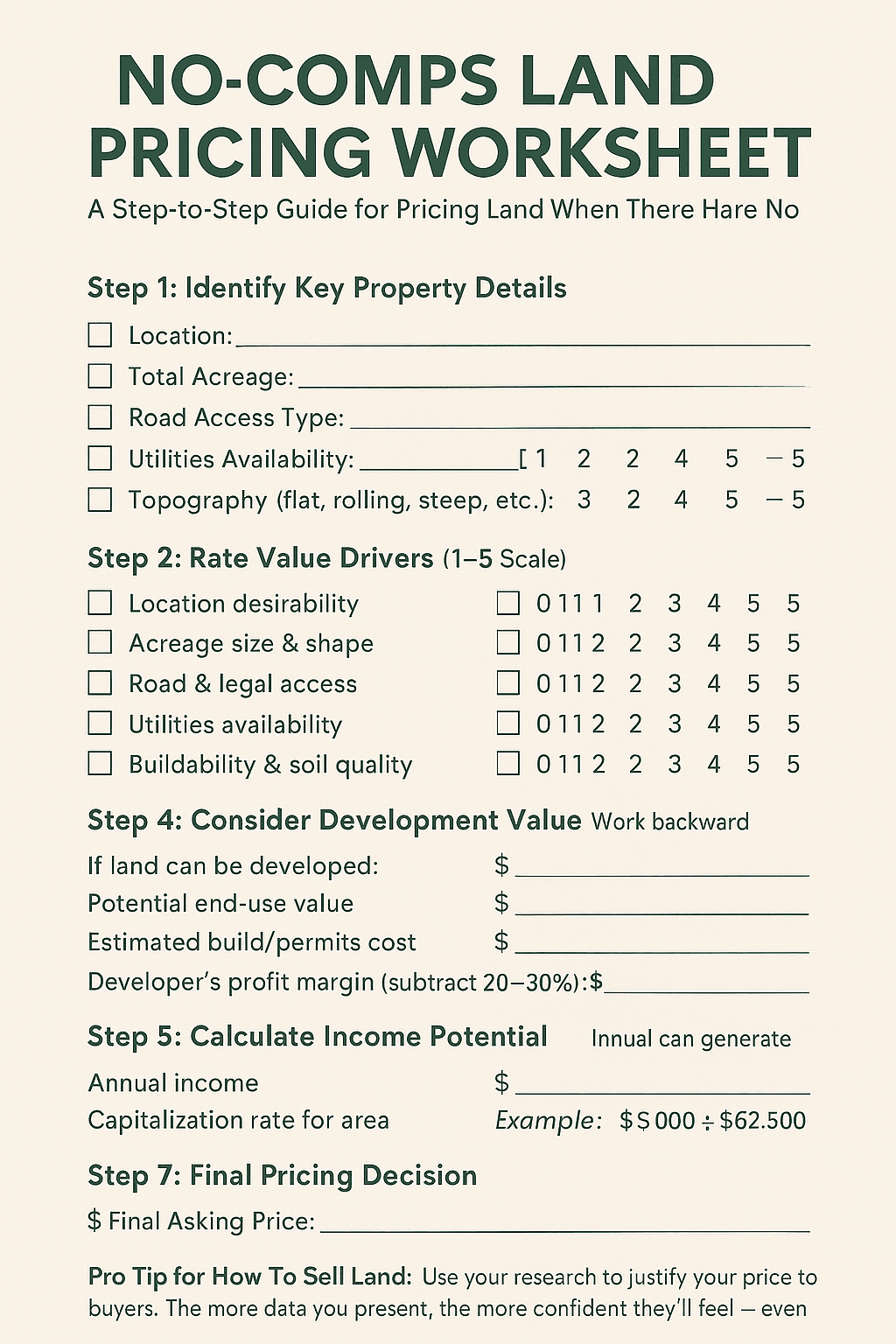
Land Appraisal vs. Broker Price Opinion: Which Is Best When Deciding How To Sell Land?
When you’re preparing to sell a piece of property, one of the most important questions is: “What’s it worth?”
For anyone learning How To Sell Land, two common valuation methods are land appraisals and broker price opinions (BPOs). While both can help you determine a fair asking price, they differ in cost, depth, accuracy, and how they’re used in the selling process.
Understanding the differences — and when to use each — can save you time, money, and headaches.
What Is a Land Appraisal?
A land appraisal is a detailed, formal valuation conducted by a licensed or certified real estate appraiser. It follows strict industry standards, such as the Uniform Standards of Professional Appraisal Practice (USPAP), and provides an unbiased estimate of market value.
Key Features of a Land Appraisal
- Conducted by: State-licensed or certified appraiser
- Purpose: Establish market value for lending, legal, or tax purposes
- Methodology:
- Comparable sales (if available)
- Income approach (if income-producing)
- Cost approach (for development potential)
- Deliverable: A formal written report with detailed analysis, maps, and supporting data
- Typical Cost: $500–$2,000+ depending on property size, complexity, and location
- Time to Complete: 1–4 weeks
Pros
- Highly detailed and credible
- Accepted by banks, courts, and government agencies
- Uses standardized methods for accuracy
Cons
- Higher cost
- Takes longer than a broker price opinion
How To Sell Land Tip: If you’re working with a lender, involved in a legal dispute, or selling a high-value or unique parcel, a formal appraisal is often the safest choice.
What Is a Broker Price Opinion (BPO)?
A broker price opinion is an estimate of value prepared by a licensed real estate broker or agent. BPOs are based on market experience and available sales data, but they are less formal and generally not as detailed as an appraisal.
Key Features of a Broker Price Opinion
- Conducted by: Licensed real estate broker or agent
- Purpose: Estimate listing or selling price for marketing purposes
- Methodology:
- Recent comparable sales
- Current listings and market trends
- Local knowledge and demand factors
- Deliverable: A written report, often 2–10 pages, with photos and sales comps
- Typical Cost: $0–$300 (sometimes offered free by agents seeking the listing)
- Time to Complete: 1–5 days
Pros
- Faster turnaround
- Lower cost (sometimes free)
- Useful for setting a competitive asking price
Cons
- Less formal and less detailed than an appraisal
- Not accepted by lenders or courts for official purposes
How To Sell Land Tip: A BPO can be a great first step when you want to test the market or decide on an asking price without investing in a full appraisal.
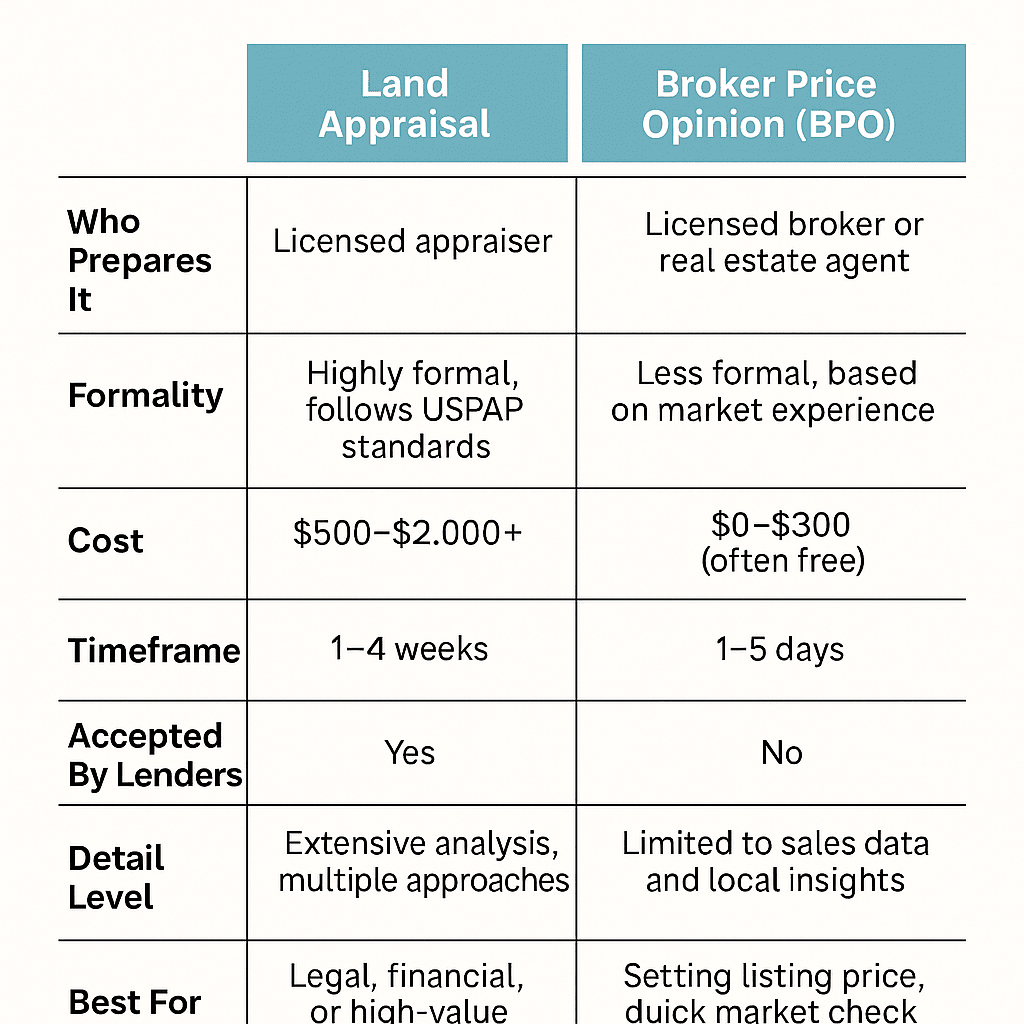
How To Sell Land Tip:
A BPO can be a great first step when you want to test the market or decide on an asking price without investing in a full appraisal.
Sometimes a real estate agent will do it for free with the anticipation of getting the listing. Other’s will charge a fee if you are not considering listing.
Either way, be upfront with your intentions to the real estate agent.
Land Appraisal vs. BPO: Side-by-Side Comparison
| Feature | Land Appraisal | Broker Price Opinion (BPO) |
|---|---|---|
| Who Prepares It | Licensed appraiser | Licensed broker or real estate agent |
| Formality | Highly formal, follows USPAP standards | Less formal, based on market experience |
| Cost | $500–$2,000+ | $0–$300 (often free) |
| Timeframe | 1–4 weeks | 1–5 days |
| Accepted By Lenders | Yes | No |
| Detail Level | Extensive analysis, multiple approaches | Limited to sales data and local insights |
| Best For | Legal, financial, or high-value transactions | Setting listing price, quick market check |
Which Should You Choose When Deciding How To Sell Land?
When determining the value of your land, the best choice depends on your goals, budget, and timeframe:
- Choose a Land Appraisal if:
- You need the valuation for financing, probate, divorce, or tax purposes
- The land is unique, high-value, or has complex development potential
- You want the most defensible and detailed estimate possible
- Choose a Broker Price Opinion if:
- You want a quick, inexpensive market snapshot
- You’re preparing to list the land for sale soon
- You want a broker’s perspective on local demand and pricing strategy
Using Acreage, Road Frontage, and Utilities Access in Pricing Your Land for Sale
When you’re figuring out How To Sell Land, setting the right price is one of the most important steps. While market comps are helpful, your land’s physical attributes can significantly influence its value — especially its acreage, road frontage, and utilities access.
Understanding how each of these elements impacts buyer interest and pricing can help you position your property competitively and attract serious offers.
1. Acreage: Size Matters (But Not Always Proportionally)
The total acreage of your land is a major value driver, but it’s not just about “more is better.”
- Small Parcels: Often appeal to residential builders, tiny home enthusiasts, or buyers looking for a manageable homestead. These may command a higher price per acre.
- Medium to Large Tracts: Attract farmers, ranchers, and developers. Price per acre typically decreases as acreage increases, but total sale price rises.
- Very Large Tracts: Often bought for agriculture, timber, or investment, where per-acre pricing is lower but based on income potential.
How To Sell Land Tip: Highlight usable acreage versus total acreage. If part of the land is steep, wet, or unusable, price accordingly and make that clear in marketing.
2. Road Frontage: Access Can Make or Break Value
Road frontage — the length of your property that borders a public or private road — is often a make-or-break factor for buyers.
- High Road Frontage: Offers easy access, better visibility, and more flexibility for subdividing. Ideal for commercial or development uses.
- Moderate Road Frontage: Good for residential and small agricultural buyers.
- No Direct Road Frontage: May require an easement for legal access, which can significantly reduce value.
How To Sell Land Tip: Include road frontage measurements in your listing and mention if it’s on a paved, gravel, or private road. In How To Sell Land situations, having clear and legal access can be the difference between quick offers and months on the market.
3. Utilities Access: Plugging Into Buyer Demand
Utilities availability is a huge selling point because it reduces a buyer’s development costs and speeds up building timelines.
- Water: Municipal or well access can increase value. If a well is needed, perc tests for septic are often required.
- Sewer/Septic: Municipal sewer is ideal. Septic requires soil suitability (perc test results are critical to share).
- Electricity & Gas: Nearby or on-site service reduces infrastructure costs.
- Internet: High-speed options (fiber or cable) can be a dealmaker, especially for remote workers.
How To Sell Land Tip: If utilities are nearby but not connected, provide distance and estimated hookup costs. This transparency builds buyer confidence and can justify your asking price in How To Sell Land scenarios.
Putting It All Together in Pricing
When setting your price:
- Start with a baseline from comparable sales or broader market data.
- Adjust for acreage — more usable space means higher value per acre.
- Factor in road frontage — more access and visibility usually means higher pricing potential.
- Consider utilities access — full or partial utility availability can add thousands to your asking price.
Example:
Two 10-acre parcels in the same area could have very different values:
- Parcel A: 10 acres, 500 ft paved road frontage, water/electric on site → higher price
- Parcel B: 10 acres, landlocked with easement, no utilities nearby → lower price

Price Per Acre Benchmarks by Property Type
When figuring out How To Sell Land, one of the most common ways to value a property is by price per acre. This approach helps both sellers and buyers quickly compare properties, but the benchmarks can vary dramatically based on property type, location, and market demand.
Understanding these benchmarks — and the factors that influence them — will help you set a realistic asking price and position your property competitively.
1. Residential Land
Typical Price Range: $20,000–$500,000+ per acre (location-dependent)
Residential land tends to have the highest price per acre because it’s often in or near developed areas with access to utilities, roads, and amenities. Zoning and buildability play huge roles in the value.
- Urban/Suburban Lots: Prime building lots in growing neighborhoods can fetch six figures per acre.
- Small Subdivision Parcels: Land that can be split into multiple buildable lots often commands a premium.
How To Sell Land Tip: For residential properties, emphasize nearby schools, shopping, and infrastructure, and confirm utility access to justify higher per-acre pricing.
2. Agricultural Land
Typical Price Range: $3,000–$15,000 per acre (quality & location-dependent)
Agricultural land values are driven by soil quality, climate, and water availability. Farmland in regions with high crop yields (like the Midwest) often sells for more than marginal pastureland in arid areas.
- Irrigated Farmland: Typically higher value due to increased productivity.
- Dryland Farming or Pasture: Lower price per acre unless close to urban expansion areas.
How To Sell Land Tip: Provide soil maps, water rights documentation, and crop history when marketing agricultural property. This data reassures buyers and can help secure top-dollar pricing.
3. Timberland
Typical Price Range: $1,500–$6,000 per acre (based on timber species & maturity)
Timberland value depends on both land quality and the market for the timber itself. Mature, marketable timber stands can add significant value, while young growth may be valued primarily for future potential.
- Hardwoods (oak, walnut, maple): Often more valuable than softwoods due to market demand.
- Managed Timber Tracts: Properties with forestry management plans in place tend to sell faster and for more per acre.
How To Sell Land Tip: If your land’s timber is a selling point, get a professional timber cruise report to document species, volume, and market value. This can be a powerful marketing tool in How To Sell Land campaigns.
4. Recreational Land
Typical Price Range: $1,000–$8,000 per acre (location & amenities matter)
Recreational land is purchased primarily for enjoyment — hunting, fishing, camping, or off-grid living. Proximity to wildlife, water features, and trail systems can drive prices up.
- Hunting Land: Higher value if it has diverse habitat, food plots, and water sources.
- Waterfront Property: Lakefront or riverfront land often commands premium prices.
How To Sell Land Tip: Use high-quality photos, drone footage, and detailed descriptions of recreational amenities (ponds, trails, wildlife) to showcase the lifestyle your land offers.
Key Factors That Affect All Property Types
Regardless of type, these factors can raise or lower your price per acre:
Zoning & Restrictions: The fewer limitations, the more flexible (and valuable) the property.
Location & Access: Paved road frontage typically adds value.
Utilities: Water, sewer, and electricity availability boost pricing.
Topography: Flat, usable land usually commands higher prices than steep or rocky terrain.

Impact of Zoning, Density, Topography, and Views on the Value of Vacant Land
When learning How To Sell Land, understanding what drives its value is essential. Beyond location and acreage, four critical factors often determine how much a buyer is willing to pay: zoning, density, topography, and views.
Knowing how each one affects pricing can help you position your property strategically, highlight its strongest features, and attract the right buyers.
1. Zoning: Defining What Can Be Built
Zoning regulations dictate how land can be used — residential, commercial, agricultural, industrial, or mixed-use. This directly impacts market value because it controls the type of buyers your property will appeal to.
- Residential Zoning: Typically draws the largest buyer pool, especially in growing communities.
- Commercial Zoning: Often higher value per acre if located near major roads or population centers.
- Agricultural Zoning: Can be less expensive per acre but attractive for farming or rural estate buyers.
- Mixed-Use Zoning: Offers flexibility and can boost value by appealing to multiple buyer types.
How To Sell Land Tip: Always verify zoning with your local planning department before listing. If rezoning is possible, that potential can be a major selling point.
2. Density: The Number of Units Allowed
Density regulations control how many homes, buildings, or units can be placed on the property. Higher density allowances usually mean higher land value because developers can maximize returns.
- Low Density: Suitable for large-lot estates, farms, or single residences.
- Medium Density: Allows for small subdivisions or townhomes, boosting buyer interest among builders.
- High Density: Attracts developers for apartments, condos, or mixed-use complexes, significantly raising price per acre.
How To Sell Land Tip: If you’re marketing to developers, highlight density potential in your listing — it can justify a higher asking price.
3. Topography: Shape, Slope, and Usable Land
Topography refers to the lay of the land — flat, rolling, steep, or irregular. It affects buildability, construction costs, and even the type of buyer interested.
- Flat or Gently Sloping Land: Easiest and cheapest to build on; often valued higher.
- Rolling Terrain: Can create privacy and visual appeal for residential buyers.
- Steep or Rugged Land: May be less desirable for construction but attractive for recreation, hunting, or off-grid use.
How To Sell Land Tip: Include a topographic map or drone footage in your marketing. For How To Sell Land effectively, showing the usable areas can make the property more appealing.
4. Views: The Premium of Scenery
A stunning view can dramatically increase a property’s value, especially in residential or recreational markets. Water views, mountain vistas, or skyline panoramas can command a premium because they enhance lifestyle and long-term desirability.
- Waterfront or Water View: Often the highest premiums in real estate.
- Mountain or Hilltop Views: Highly desirable for custom home sites.
- Cityscape Views: Popular in urban or suburban markets.
How To Sell Land Tip: If your property has a view, showcase it with professional photography taken during the best light of day. This visual appeal can justify top-tier pricing.
Bringing It All Together When Selling Land
When pricing vacant land, zoning sets the rules, density determines development potential, topography influences buildability, and views add emotional value.
If you want to master How To Sell Land, combine these factors in your marketing:
- Highlight strengths: If zoning and density are favorable, target developers.
- Address limitations: If topography is challenging, position the land for recreational or conservation use.
- Leverage visuals: Use maps, surveys, and high-quality imagery to show value.
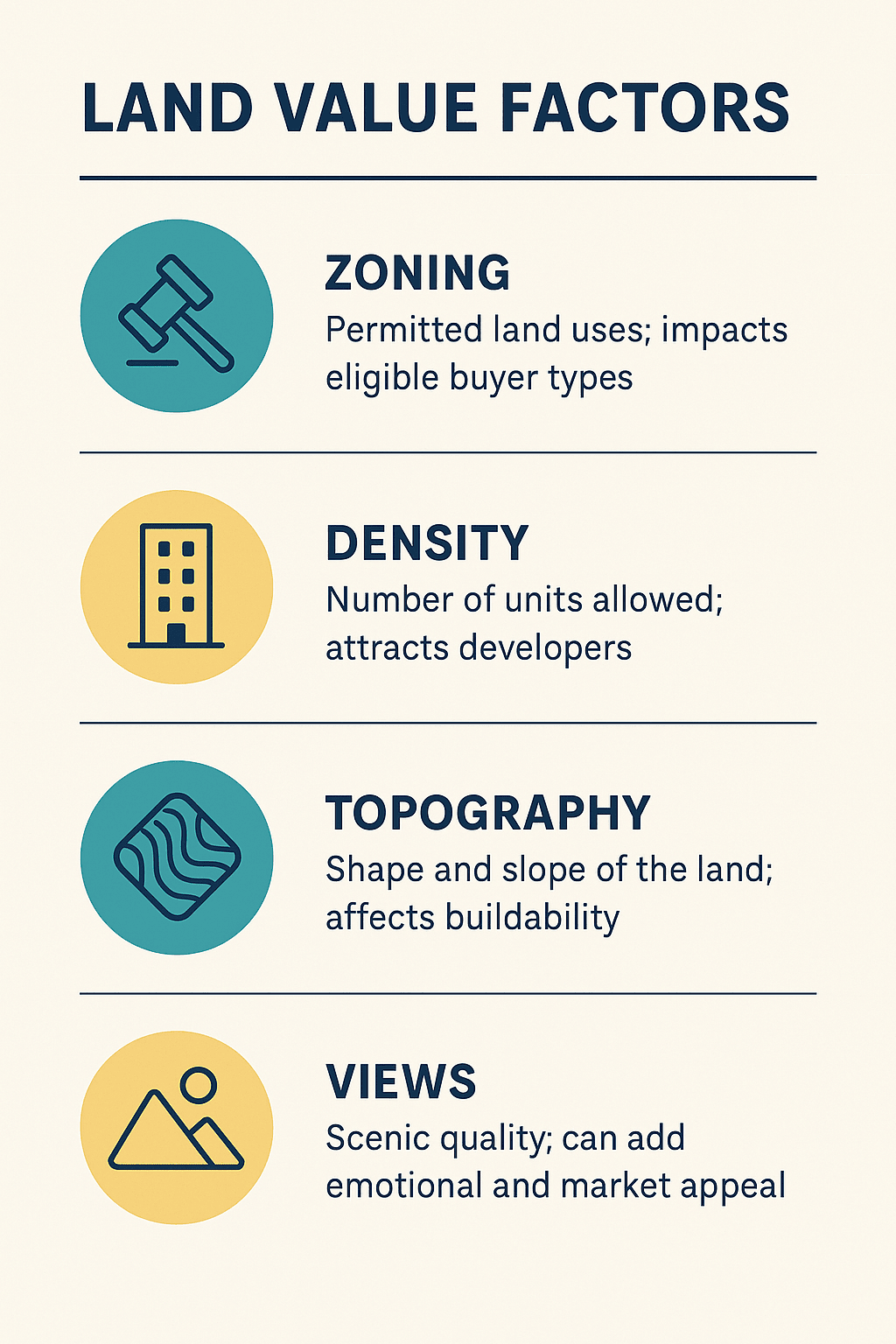
When (and How) to Reduce Price When Selling Land
One of the most difficult decisions you may face when learning How To Sell Land is whether — and when — to lower your asking price. Price reductions can attract fresh buyer interest and lead to a sale, but if done at the wrong time or in the wrong way, they can hurt your negotiating position.
Here’s how to know when it’s time to adjust your price and how to do it strategically.
When to Consider Reducing the Price on Land
Price reductions should be a strategic move, not a panic reaction. Look for these signs:
- No Inquiries or Showings After 30–60 Days
If your listing has been active for over a month without calls, emails, or showings, it’s a red flag that buyers see the price as too high. - Lots of Interest, No Offers
If people are touring the land but not making offers, it usually means buyers like the property but feel it’s overpriced. - Comparable Properties Selling Faster
If other similar parcels in your area are selling within weeks and yours has been sitting for months, pricing may be the main issue. - Market Shifts
In a slowing market or off-season, buyers become more price-sensitive. Adjusting early can keep your land competitive.
How To Sell Land Tip: Always review market data before deciding. A price cut without understanding your competition could cost you more than necessary.
How to Reduce Price Without Losing Leverage
If you decide to lower your price, the key is how you do it:
- Make It Noticeable
A tiny drop (e.g., $1,000 on a $100,000 property) rarely makes an impact. Aim for a noticeable percentage — often 3–10% — so buyers take the change seriously. - Re-Market the Listing
Don’t just change the price; refresh your photos, update the description, and promote it on social media and land listing sites. This gives the impression of a “new” opportunity. - Time It With Purpose
Consider lowering the price before a high-demand season for your type of land (e.g., hunting season for recreational land, spring for residential lots). - Bundle with an Incentive
Pair the reduction with an added value, such as offering owner financing or covering some closing costs.
How To Sell Land Tip: Announce your price change to your email list, social media followers, and any agents or investors who previously inquired.
Alternatives to Price Reductions
Sometimes you can increase buyer interest without lowering the price:
- Improve the property’s curb appeal (clear brush, mark boundaries)
- Offer flexible financing terms
- Add new listing platforms for broader exposure
- Highlight features you may have overlooked in marketing
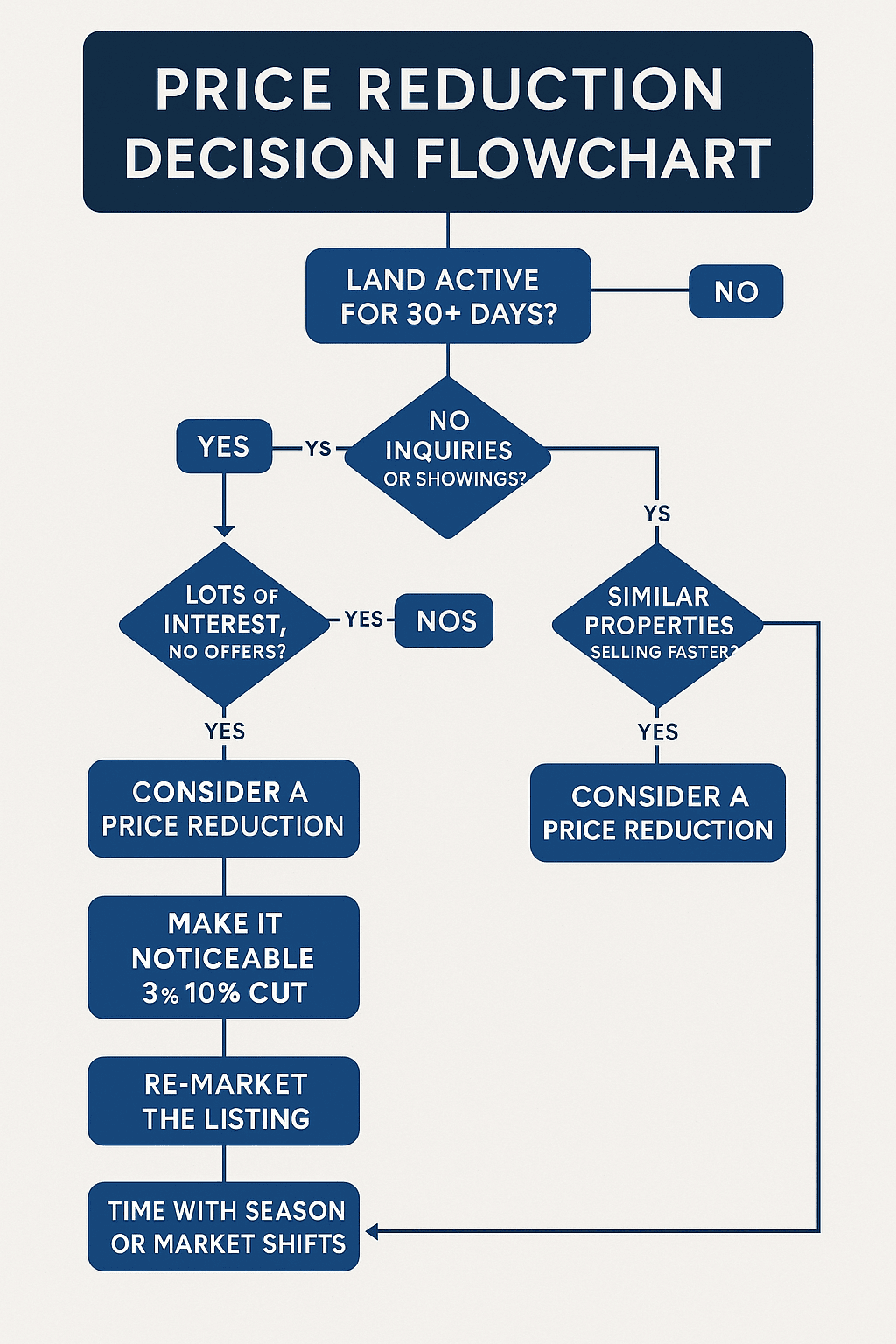
Reducing your price when selling land isn’t about giving up value — it’s about finding the sweet spot where buyer interest meets market reality.
The best approach to How To Sell Land successfully is to price it right from the start, monitor the market closely, and make strategic adjustments when needed. Done correctly, a well-timed price reduction can be the move that turns a stale listing into a sold property.
How to Find Land Comps (MLS, County Records, Land Sites)
When you’re learning How To Sell Land, one of the most important steps is determining a realistic asking price. The best way to do that? Finding land comps — comparable properties that have recently sold in your area.
Unlike homes, which often have abundant comparable sales, vacant land requires more digging to get accurate data. Here’s how to find reliable comps using the MLS, county records, and land listing sites.
1. Using the MLS (Multiple Listing Service)
The MLS is a database used by real estate agents to share property listings and sales information.
- Why it’s valuable: It often includes the most up-to-date and detailed sales data, including sold prices, days on market, and property details.
- How to access:
- Work with a licensed real estate agent who specializes in land sales.
- Request a “sold properties” report for parcels similar to yours in size, location, and zoning.
- Pro Tip: Ask your agent to filter out improved properties (with structures) so you’re only comparing to true vacant land.
How To Sell Land Tip: If you plan to sell FSBO, consider paying an agent a flat fee for an MLS report. This one-time cost can save you from overpricing or undervaluing your land.
2. Searching County Records
Every property sale is recorded with the county, making county records a powerful (and free) source of land comps.
- Where to find them: Visit your county’s property appraiser, assessor, or recorder’s website. Many counties have searchable online databases.
- What to look for:
- Recent sales of similar land in the same area.
- Sale price, acreage, and property type.
- Parcel maps to compare size, shape, and location.
- Bonus: County records can also reveal ownership history, which may help you spot trends in land value.
How To Sell Land Tip: When using county data, focus on sales within the last 6–12 months to ensure pricing reflects current market conditions.
3. Checking Land Listing Websites
Specialized land listing sites make it easier to see active listings and sometimes recent sales:
- Popular platforms include LandWatch, Lands of America, Land and Farm, and Zillow (land filter).
- Why they help: They show asking prices and, in some cases, sales history, giving you a sense of market expectations.
- Caution: Active listing prices may be higher than what properties actually sell for, so use them for reference, not as the sole basis for pricing.
How To Sell Land Tip: Compare your property’s features — road frontage, utilities, topography, and access — to those listed online. Even small differences can justify a higher or lower price per acre.
4. Combining All Three for Accuracy
The most accurate pricing comes from cross-referencing data from all three sources:
- MLS – Gives you the most recent closed sales.
- County Records – Confirms official sale prices and parcel details.
- Land Sites – Shows competition and buyer expectations.
By combining these resources, you’ll have a well-rounded picture of what buyers are actually paying — not just what sellers are asking.
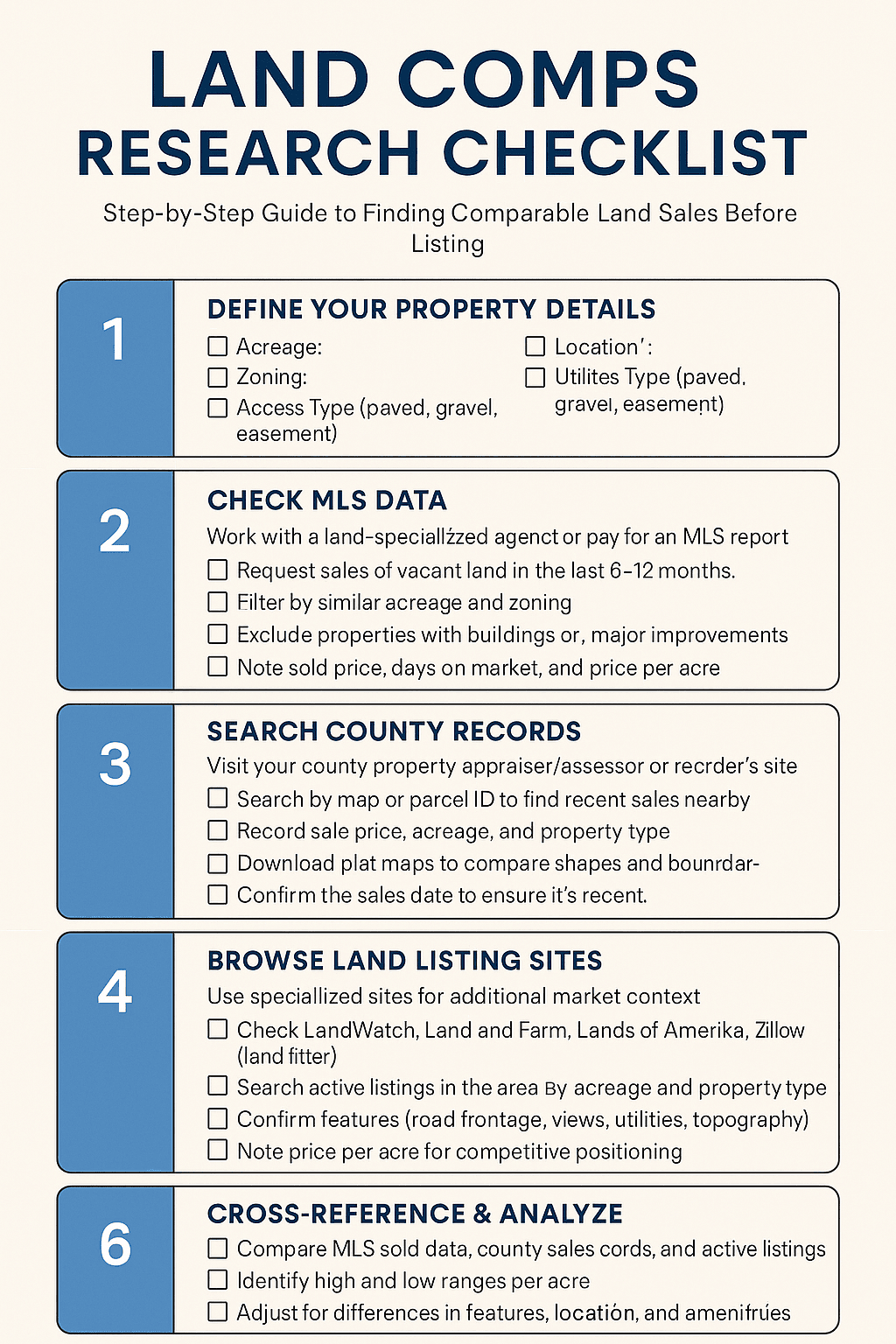
Reading Plat Maps, Parcel Maps, and GIS for Vacant Land
When learning How To Sell Land, one of the most overlooked — yet critical — skills is understanding how to read the maps associated with your property. Plat maps, parcel maps, and GIS (Geographic Information System) tools reveal essential details about boundaries, access, and features that can influence value, marketability, and even whether your property is buildable.
Here’s how to make sense of each one and use them to your advantage.
1. Plat Maps: The Official Survey Record
A plat map is a recorded survey that shows how land has been divided within a subdivision or development.
- What it shows:
- Lot boundaries and dimensions
- Streets, alleys, and easements
- Lot numbers and subdivision names
- Why it matters for How To Sell Land:
- Confirms exact lot size and shape
- Shows legal access points
- Helps buyers visualize layout within a neighborhood
Pro Tip: If your land is part of a platted subdivision, having the plat map available builds buyer confidence and speeds up the due diligence process.
2. Parcel Maps: County Property Reference
A parcel map is typically provided by the county property appraiser or assessor and identifies the location of a parcel within a broader area.
- What it shows:
- Parcel boundaries
- Parcel ID number (used for tax and legal purposes)
- Surrounding property owners and land uses
- Why it matters for How To Sell Land:
- Shows property in relation to nearby parcels
- Can highlight proximity to roads, amenities, or other key features
- Often used by buyers, agents, and title companies to verify location
Pro Tip: Parcel maps aren’t always survey-accurate — they’re best used for location context, not for legal measurements.
3. GIS (Geographic Information System) Maps: Interactive Property Data
GIS maps are digital mapping tools offered by many county governments, allowing you to explore detailed property data interactively.
- What it shows:
- Boundary lines over aerial imagery
- Topography and elevation
- Zoning layers, flood zones, and environmental overlays
- Utility infrastructure (water, sewer, power lines)
- Why it matters for How To Sell Land:
- Helps identify development constraints
- Provides visual proof of access and surrounding land use
- Makes marketing more compelling with high-quality map images
Pro Tip: Many counties offer free GIS systems online — search “[Your County] GIS” to find it.
How to Use These Maps Together
The most effective way to price, market, and close on a property is to use all three map types together:
- Plat Map – Confirms lot dimensions and access.
- Parcel Map – Shows property location in relation to others.
- GIS Map – Provides deeper insights into terrain, zoning, and restrictions.
By combining them, you give buyers complete clarity — which can shorten the time it takes to sell.

Interpreting Assessed Value vs. Market Value for Vacant Land
When learning How To Sell Land, one of the most common points of confusion is the difference between assessed value and market value. Many landowners assume these numbers are interchangeable — but in reality, they serve very different purposes and can vary widely. Understanding the difference is key to setting a realistic asking price and negotiating effectively.
1. What Is Assessed Value?
The assessed value is the dollar amount assigned to your property by the local tax assessor’s office for the purpose of calculating property taxes.
- How it’s determined:
- Based on a percentage of estimated market value or a mass appraisal formula.
- Factors in land size, location, zoning, and sometimes improvements.
- May not be updated annually, so it can lag behind actual market conditions.
- Why it matters for How To Sell Land:
- It affects your annual property tax bill, but it’s not always an accurate reflection of what your land would sell for today.
- Buyers sometimes look at assessed value as a reference point, but experienced investors focus on market value.
Example: A rural parcel assessed at $25,000 might realistically sell for $45,000 in today’s market — or only $15,000 if demand has dropped.
2. What Is Market Value?
Market value is the price your property would likely sell for under current market conditions between a willing buyer and seller.
- How it’s determined:
- Based on recent comparable sales (land comps).
- Considers unique property features like road frontage, views, topography, and utility access.
- Influenced by supply and demand in your local market.
- Why it matters for How To Sell Land:
- Market value is what ultimately drives negotiations, offers, and closing prices.
- Pricing your land based on market value (not assessed value) increases your chances of selling faster.
3. Why Assessed Value and Market Value Often Differ
There are several reasons the two values don’t match:
- Assessment cycles: Many counties only reassess every few years.
- Mass appraisal methods: Assessors often apply a blanket formula, ignoring unique property features.
- Market shifts: Rapid increases or decreases in demand can outpace tax records.
- Zoning or use changes: If your land’s use changes (e.g., rezoning for residential development), market value can jump long before the county updates its records.
4. How to Use Both Values When Selling
- Use assessed value as a baseline, not a pricing guide.
- Rely on market data — MLS reports, county sales records, and land listing sites — to set your asking price.
- Be prepared to explain differences to buyers. If market value is significantly higher than assessed value, highlight market trends and comparable sales.
How To Sell Land Tip: If assessed value is much lower than market value, emphasize that low property taxes could be a selling point for buyers.
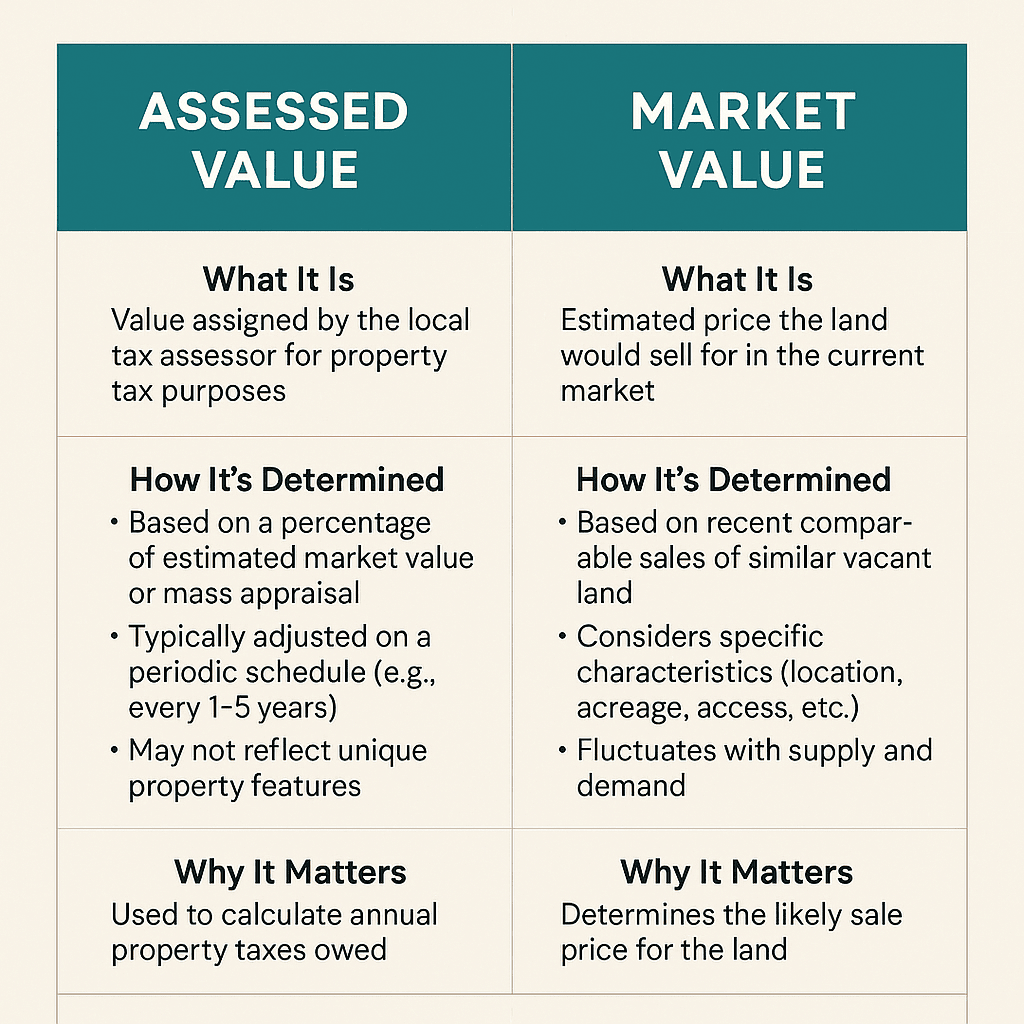
Demand Signals: DOM, Absorption, and Search Volume When Selling Vacant Land
If you’re learning How To Sell Land, understanding demand signals can give you a serious advantage. By tracking metrics like Days on Market (DOM), absorption rate, and search volume, you can gauge buyer interest, set the right price, and time your sale for maximum results.
These indicators work together to answer the big question every seller has: “How hot is the market for my land right now?”
1. Days on Market (DOM)
What it is:
DOM measures the number of days a property stays on the market before going under contract.
Why it matters for How To Sell Land:
- A low DOM usually means high demand and competitive pricing.
- A high DOM could indicate overpricing, poor marketing, or limited buyer interest.
How to use it:
- Compare your land’s projected DOM with similar sold properties in your area.
- If the average DOM is 90 days and your listing has been sitting for 180, it may be time to review your pricing or marketing strategy.
Pro Tip: Always check the median DOM, not just the average, to avoid skewed results from outlier sales.
2. Absorption Rate
What it is:
The absorption rate measures how quickly available properties are selling in a specific market, expressed in months of inventory.
Why it matters for How To Sell Land:
- Shows how long it might take for your property type to sell based on current supply and demand.
- Helps you price competitively in either a buyer’s market (high inventory) or seller’s market (low inventory).
How to calculate:
- Count the number of similar land parcels sold in the last 12 months.
- Divide by 12 for the monthly sales rate.
- Then divide current inventory by the monthly sales rate.
Example: If 24 parcels sold in a year (2 per month) and there are 10 similar parcels currently listed, there’s 5 months of inventory. Lower inventory = faster sales.
3. Search Volume
What it is:
Search volume refers to how many people are actively looking for land online, often tracked by keyword searches like “acreage for sale near me” or “buildable lots in Fort Myers.”
Why it matters for How To Sell Land:
- High search volume means more potential buyers in the market.
- Low search volume may indicate a seasonal lull or reduced interest.
How to use it:
- Monitor Google Trends and land listing site traffic for your area.
- Work with agents or marketing professionals who can track website visits and inquiries.
- Adjust your advertising to target locations or buyer types showing the highest search interest.
4. Putting It All Together
To get a true read on demand:
- Check DOM to see how fast similar parcels are selling.
- Look at the absorption rate to understand supply vs. demand.
- Review search volume to measure buyer interest in real time.
If all three metrics point to high demand, you can price aggressively and expect a faster sale. If they point to low demand, a competitive price, creative financing, or added incentives may be needed.

Preparing Land for Sale: Boundary Confirmation & Surveys
When you’re learning How To Sell Land, one of the most important — and often overlooked — steps is confirming your property’s boundaries. Buyers want clarity on exactly what they’re purchasing, and nothing builds confidence faster than having accurate, up-to-date survey information.
Whether you’re working with an existing survey or considering an updated one, understanding the differences can help you avoid legal disputes, speed up the selling process, and possibly increase your property’s value.
1. Why Boundary Confirmation Matters
Before listing your property, you need to know:
- The exact size and shape of your land.
- Where your property lines begin and end.
- Whether there are any encroachments or easements.
How To Sell Land Tip: Buyers often factor uncertainty into their offers. If they’re unsure about boundaries, they may lower their bid to cover potential risks.
2. Existing vs. Updated Surveys
Existing Survey
- What it is: A previous survey done on your property, often from when you purchased it or during a past transaction.
- Pros:
- Usually cheaper since it’s already done.
- Can provide enough detail for certain transactions.
- Cons:
- May be outdated if landmarks or adjacent property lines have changed.
- Could miss new easements, encroachments, or boundary adjustments.
Updated Survey
- What it is: A fresh, professional survey conducted before selling.
- Pros:
- Reflects the current, exact state of the property.
- More credible to buyers, lenders, and title companies.
- Reduces the chance of post-sale disputes.
- Cons:
- Costs more than using an existing survey.
- May take extra time before listing.
How To Sell Land Tip: If your current survey is more than 5 years old or major changes have occurred nearby, an updated survey is worth the investment.
3. Benefits of an Updated Survey for Sellers
An updated survey can:
- Increase Buyer Confidence – Clear boundaries make buyers more comfortable committing to a purchase.
- Prevent Legal Issues – Protects you from disputes over encroachments after closing.
- Speed Up the Sale – Eliminates delays during the due diligence period.
- Support Marketing Materials – Allows you to show accurate maps in listings and brochures.
4. Steps to Confirm Boundaries Before Selling
- Locate Your Existing Survey – If available, retrieve a copy from your records or the county.
- Walk the Property – Look for existing survey markers or corner stakes.
- Compare to County Records – Ensure the legal description matches your parcel’s location.
- Hire a Licensed Surveyor – If needed, commission a new survey for the most accurate representation.
- Share with Buyers – Provide the survey in your marketing package and at showings.

Preparing Land for Sale: Perc Test & Soil/Septic Permits
When learning How To Sell Land, one crucial step for many rural and undeveloped properties is understanding whether the land can support a septic system. This is where perc tests (sometimes called perk tests) and soil permits come into play. These tests and permits are especially important when your land is not connected to a municipal sewer system, as they can directly impact both value and marketability.
1. What Is a Perc Test?
A perc test measures how quickly water drains through soil, determining whether it’s suitable for a septic system.
- Why it matters for How To Sell Land:
- If the soil fails the test, buyers may walk away unless alternative systems are feasible.
- Passing the test gives buyers confidence they can build and install a septic system.
How it works:
- Conducted by a licensed soil scientist, engineer, or county official.
- Holes are dug at the proposed septic location, filled with water, and drainage rates are recorded.
- Results are compared against county or state standards to determine suitability.
2. Soil & Septic Permits
Once a property passes a perc test, many counties require a soil evaluation or septic permit before installation.
- Types of permits:
- Soil Evaluation Report: Identifies where a system can be installed.
- Construction/Installation Permit: Grants permission to build the septic system.
- Why it matters for How To Sell Land:
- Having these permits in place can shorten a buyer’s timeline.
- In competitive markets, pre-approved septic permits can make your property stand out.
3. Existing vs. New Tests
- Existing Test: If a perc test was completed in the past, find out if it’s still valid. Many counties have expiration periods (often 1–5 years).
- New Test: If your old test expired or conditions have changed, a new one may be necessary.
How To Sell Land Tip: If your test results are favorable, consider getting them updated or renewed before listing to save buyers time and uncertainty.
4. Benefits of Doing a Perc Test Before Selling
- Higher Buyer Confidence – Buyers know the property is buildable.
- Better Marketing – You can advertise the land as “perc tested” or “septic-approved.”
- Faster Closings – Reduces delays during due diligence.
- Potentially Higher Offers – Certainty often justifies a better price.
5. How to Prepare for a Perc Test
- Contact the County Health Department – Learn local requirements and approved testers.
- Hire a Qualified Professional – Ensure the results will be accepted for permits.
- Mark Potential Septic Areas – Work with your tester to find optimal locations.
- Clear Access – Make sure equipment can reach the site for digging.

Preparing Land for Sale: Clearing Brush, Trail Cut-Ins, and Simple Clean-Up
When it comes to How To Sell Land, first impressions matter — even for vacant property. While you can’t stage an empty lot the way you would a house, you can make it more appealing, accessible, and market-ready with some strategic clean-up and light preparation.
Clearing brush, cutting in trails, and doing a basic tidy-up can help buyers envision potential uses, highlight the property’s best features, and make inspections much easier.
1. Why Land Presentation Matters
- Curb Appeal for Land: Just like a home, land benefits from looking well-kept and easy to explore.
- Buyer Experience: If buyers can easily walk the property and see its boundaries, they’re more likely to make an offer.
- Photography & Marketing: Clear, open views make for better listing photos and drone footage.
How To Sell Land Tip: Buyers often decide within minutes whether a property feels right — presentation can tip the scale in your favor.
2. Clearing Brush
Purpose: Removing overgrown vegetation, small trees, and debris to open up sight lines and make the property accessible.
Benefits:
- Highlights usable areas of the property.
- Reduces the “wild and neglected” appearance.
- Shows potential building sites, pasture areas, or recreational spots.
Tips:
- Focus on clearing along access points and near property boundaries.
- Use a brush cutter or hire a local land-clearing service for larger jobs.
3. Trail Cut-Ins
Purpose: Creating walkable or drivable paths through the property so buyers can explore it fully.
Benefits:
- Encourages buyers to see the whole parcel, not just the frontage.
- Helps highlight key features like creeks, high points, or wooded groves.
- Makes inspections (and surveys) easier.
Tips:
- Trails don’t have to be elaborate — a mowed strip or compacted dirt path works.
- Consider marking trails with flagging tape to guide visitors.
4. Simple Clean-Up
Purpose: Removing trash, fallen branches, old fencing, or unused structures that detract from the land’s appeal.
Benefits:
- Creates a more positive first impression.
- Reduces distractions so buyers can focus on the property’s strengths.
- Can subtly increase perceived value.
Tips:
- Walk the entire property before listing to spot problem areas.
- If structures remain, make sure they’re safe to enter or clearly marked as off-limits.
5. Balancing Effort and Cost
While preparing land for sale is important, you don’t need to fully landscape it. The goal is accessibility and visibility, not perfection.
- Do: Clear paths, remove obvious debris, and open up key views.
- Don’t: Spend heavily on landscaping that won’t impact value.
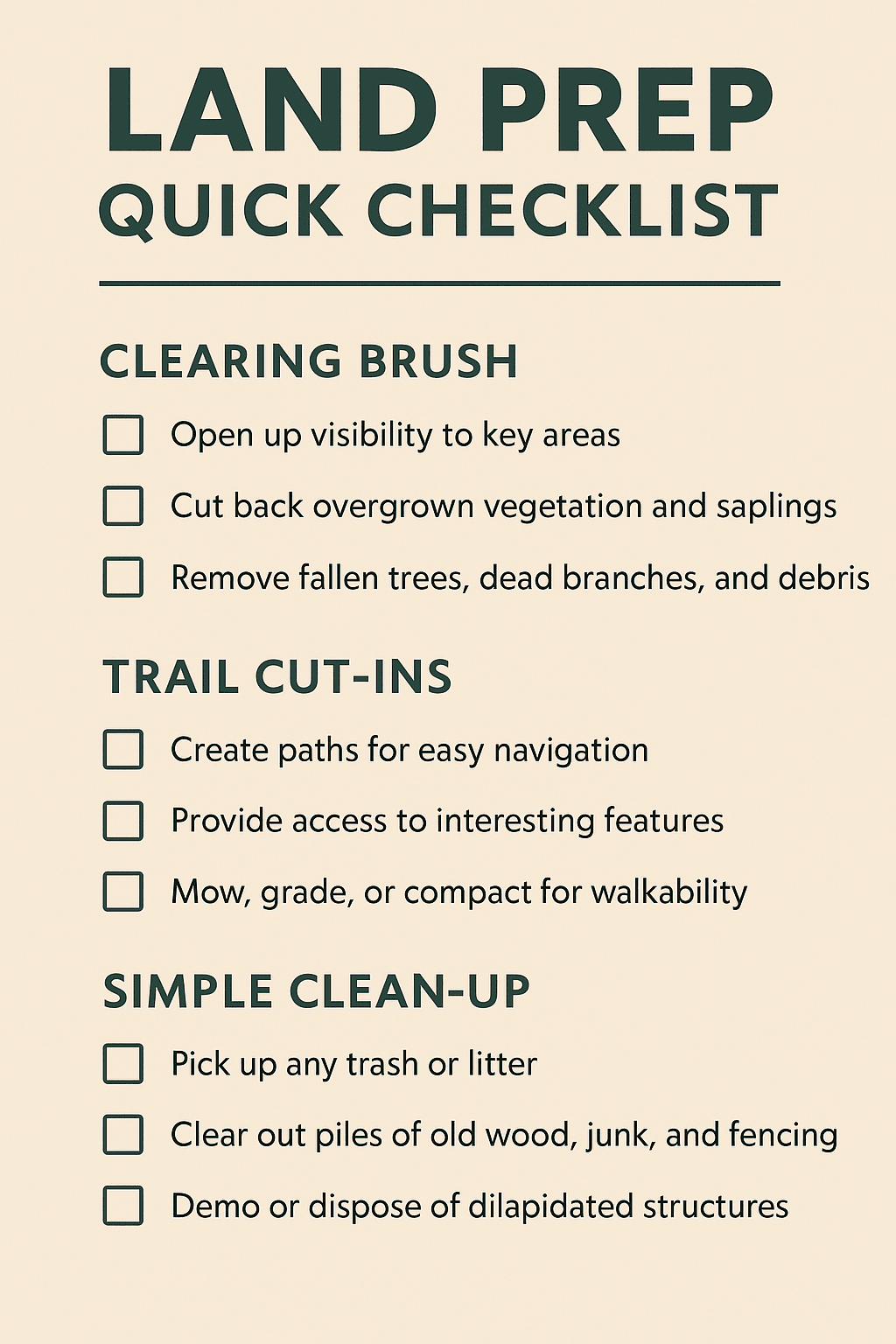
Improving Land for Sale: Gates, Signage, Driveways, and Culverts
When learning How To Sell Land, one of the most overlooked steps is making the property accessible and visible to potential buyers. While vacant land is often sold “as is,” small improvements can make a huge difference in attracting interest, improving usability, and justifying a stronger asking price.
Adding elements like a gate, clear signage, and a temporary driveway or culvert can instantly make your property more inviting and functional — while also helping buyers picture its potential.
1. Installing a Gate
Purpose: Enhances security, creates a defined entrance, and gives the property a more polished first impression.
Benefits for How To Sell Land:
- Signals to buyers that the property is maintained and cared for.
- Adds a sense of privacy and exclusivity.
- Helps control access while still allowing showings.
Tips:
- A basic farm or tube gate is cost-effective and easy to install.
- Place it where the driveway or primary access point will likely be located.
- Keep it unlocked during showings or provide agents with a key or code.
2. Adding Signage
Purpose: Makes your land easy to find for drive-by traffic and scheduled showings. If larger acreage, consider branding it.
Benefits for How To Sell Land:
- Draws attention from potential buyers driving the area.
- Clearly marks the property boundaries or main entrance.
- Can be customized with your contact info or a website link.
Tips:
- Use weather-resistant materials for durability.
- Include lot size, special features, and “For Sale” details.
- Place signs where they are highly visible from the road.
3. Creating a Temporary Driveway
Purpose: Allows vehicles to easily enter the property for showings and inspections.
Benefits for How To Sell Land:
- Improves accessibility for buyers, agents, and inspectors.
- Shows the property’s potential for development or ease of construction.
- Prevents cars from getting stuck or damaging the land during tours.
Tips:
- Use crushed gravel or compacted dirt for a cost-effective solution.
- Ensure the path is wide enough for trucks and small equipment.
4. Installing a Culvert
Purpose: Manages drainage and water flow at the entrance, preventing erosion or flooding.
Benefits for How To Sell Land:
- Ensures long-term access regardless of weather conditions.
- Meets county or state requirements for driveway installation.
- Adds value by demonstrating the land’s readiness for building.
Tips:
- Check with local authorities for permit requirements.
- Install the correct size and type to handle stormwater flow in your area.
5. The Big Picture
While these improvements require some upfront investment, they:
- Make the land more accessible and buyer-friendly.
- Provide a visual cue that the property is cared for and ready for use.
- Can shorten your Days on Market (DOM) and boost perceived value.
How To Sell Land Tip: Even modest upgrades can make a big impact — especially when combined with good marketing and high-quality photos.

Preparing Land for Sale: Drone Photos and Ground Shots
When learning How To Sell Land, one of the most powerful marketing tools you can use is high-quality photography — especially drone photos and ground shots. Unlike homes, where interior staging takes center stage, land relies heavily on visuals that showcase its size, features, and potential uses.
Done right, photography can capture the property’s best angles, tell its story, and inspire buyers to take the next step.
1. Why Professional Photos Matter for Land Sales
- First Impressions Are Digital: Most buyers see your property online before they ever set foot on it.
- Land Is Hard to Visualize: Without photos, it’s difficult for buyers to understand topography, access points, and unique features.
- Better Marketing Reach: Listings with professional images receive more clicks and inquiries.
How To Sell Land Tip: Think of photos as the “curb appeal” of your online listing. The better they look, the faster you’ll get attention.
2. Benefits of Drone Photography
Drone shots capture what ground-level photography can’t, offering a unique perspective that helps buyers understand the big picture.
Key Advantages:
- Show Full Property Boundaries: Aerial shots can be edited with overlay lines to mark lot lines.
- Highlight Surrounding Amenities: Showcase nearby lakes, roads, trails, or development.
- Display Topography: Help buyers see elevation changes and land layout.
Tips for Success:
- Fly at different heights to capture wide shots and close-up angles.
- Use drones on sunny, clear days for crisp, vibrant images.
- Consider aerial video for marketing on social media.
3. Why Ground Shots Still Matter
While drone photography shows the “macro” view, ground shots give buyers the personal perspective of being on the land.
Key Advantages:
- Show Access Points: Driveways, gates, and road frontage.
- Highlight Natural Features: Trees, creeks, open meadows, or scenic views.
- Capture Usable Areas: Potential building sites or cleared areas.
Tips for Success:
- Take photos from multiple directions and lighting conditions.
- Avoid clutter, debris, or overgrown areas when possible.
- Use wide-angle lenses to make spaces feel open and inviting.
4. Combining Drone and Ground Shots for Maximum Impact
The most effective How To Sell Land marketing strategy pairs aerials with ground-level perspectives. For example:
- Start with an aerial “establishing shot” that shows the entire property.
- Follow with mid-level drone shots to highlight features and access points.
- End with ground shots to give buyers the feel of walking the property.
This combination creates a complete visual tour — the next best thing to visiting in person.
5. Hiring a Professional vs. DIY
- Professional Photographer: Offers better equipment, editing skills, and legal compliance for drone flights.
- DIY Approach: More budget-friendly if you have a good camera and basic drone skills.
How To Sell Land Tip: If your property is large, scenic, or high-value, hiring a professional is worth the investment.
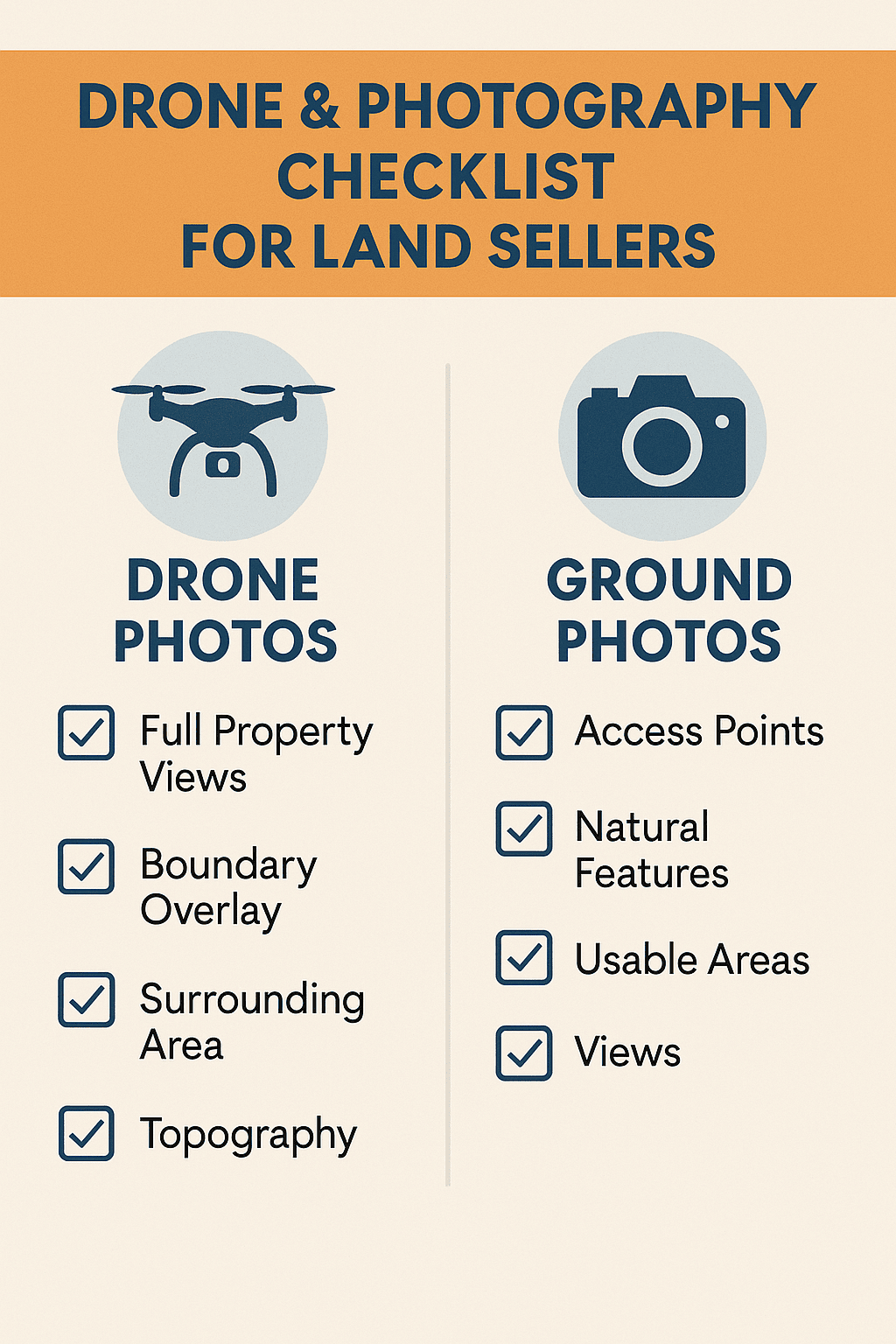
Preparing Land for Sale: Staking Corners, Flagging Lines, and Posting Acreage Markers
When figuring out How To Sell Land, one of the most important — and often overlooked — steps is making sure buyers can physically see the property boundaries. Clearly marked land is easier to show, builds buyer confidence, and helps avoid disputes during the sale process.
By staking corners, flagging property lines, and posting acreage markers, you make the property more navigable and market-ready while reducing confusion for everyone involved.
1. Why Boundary Marking Matters
- Clear Buyer Understanding: Buyers can walk the land knowing exactly what’s included in the sale.
- Fewer Disputes: Prevents misunderstandings with neighbors or potential buyers.
- Professional Presentation: Shows you’ve done your homework and prepared for a smooth closing.
How To Sell Land Tip: Well-marked boundaries can make your property feel larger and more valuable simply by removing uncertainty.
2. Staking Corners
Purpose: Identify the exact points where property lines meet.
Benefits for How To Sell Land:
- Makes it easy for buyers, agents, and surveyors to confirm lot size.
- Demonstrates transparency about the property’s legal boundaries.
- Enhances trust in your listing.
Tips:
- Use survey-grade stakes (wood or metal) for durability.
- Hire a professional surveyor if existing corner markers are unclear or missing.
- Paint the tops or attach bright flagging tape for visibility.
3. Flagging Property Lines
Purpose: Visually connect the corners so buyers can see the full outline of the property.
Benefits for How To Sell Land:
- Guides buyers during walk-throughs or inspections.
- Makes it easier for drone pilots and photographers to capture accurate aerials.
- Shows usable space and potential building envelopes.
Tips:
- Use weather-resistant flagging tape in bright colors.
- Tie flags every 25–50 feet for maximum visibility.
- Remove old or faded flags to avoid confusion.
4. Posting Acreage Markers
Purpose: Provide quick, visible reference to the property size and key features.
Benefits for How To Sell Land:
- Reinforces the property’s value when buyers are walking it.
- Adds professionalism to the listing and showing process.
- Helps buyers visualize how much land they’re purchasing.
Tips:
- Post signage at the main entrance and at visible points within the property.
- Include total acreage and any notable features (e.g., “5 Acres – Creek Access”).
5. Legal & Practical Considerations
- Check Local Rules: Some jurisdictions have specific requirements for signage or surveying.
- Coordinate With Neighbors: Avoid disputes by making sure markings align with recorded surveys.
- Update As Needed: Remove or replace damaged markers during the listing period.

Verifying Legal Access vs. Physical Access When Selling Land
When learning How To Sell Land, one of the most critical — and often misunderstood — factors is access. You can have the most beautiful, valuable property in the county, but if buyers can’t legally or physically get to it, your chances of selling quickly (or at all) drop significantly.
There are two types of access every seller needs to understand: legal access and physical access. While they sound similar, they are not the same — and a gap between the two can cause major headaches during a sale.
1. Legal Access – The Right to Enter
Definition: Legal access is the documented, lawful right to enter and use a property from a public road or via another property.
How To Sell Land Tip: Legal access is usually established through:
- A public road frontage recorded on the deed.
- A recorded easement across a neighbor’s property.
- A subdivision plat that includes shared roads or rights-of-way.
Why It Matters:
Without legal access, a buyer might have to go through lengthy, expensive legal steps to secure it — or they may walk away from the deal entirely.
Verification Steps:
- Review the deed and title report.
- Check county GIS or plat maps.
- Confirm with the county recorder or assessor’s office that the access is recorded.
2. Physical Access – The Actual Ability to Get There
Definition: Physical access is the practical, real-world ability to drive or walk onto the property.
How To Sell Land Tip: Even if you have legal access, poor road conditions or natural barriers can make the property difficult to reach.
Examples of Physical Access Issues:
- Overgrown or impassable roads.
- Washed-out culverts or bridges.
- Locked gates or fences blocking the route.
Verification Steps:
- Drive to the property yourself — don’t rely solely on maps.
- Inspect the condition of access points and roads.
- Ensure there are no physical obstructions preventing entry.
3. Landlocked Properties – When Neither Access Exists
Definition: Landlocked land has no legal right of way and often no physical route in or out.
How To Sell Land Tip: Landlocked parcels can be challenging to sell and may require:
- Negotiating and recording an easement with a neighbor.
- Going through a legal process for a court-ordered easement.
- Pricing the property significantly lower to reflect the issue.
4. How to Prevent Access Problems Before Listing
- Confirm both legal and physical access before marketing the property.
- Document proof of access (maps, easement agreements, road maintenance details).
- Address barriers in advance, such as clearing overgrowth or repairing driveways.
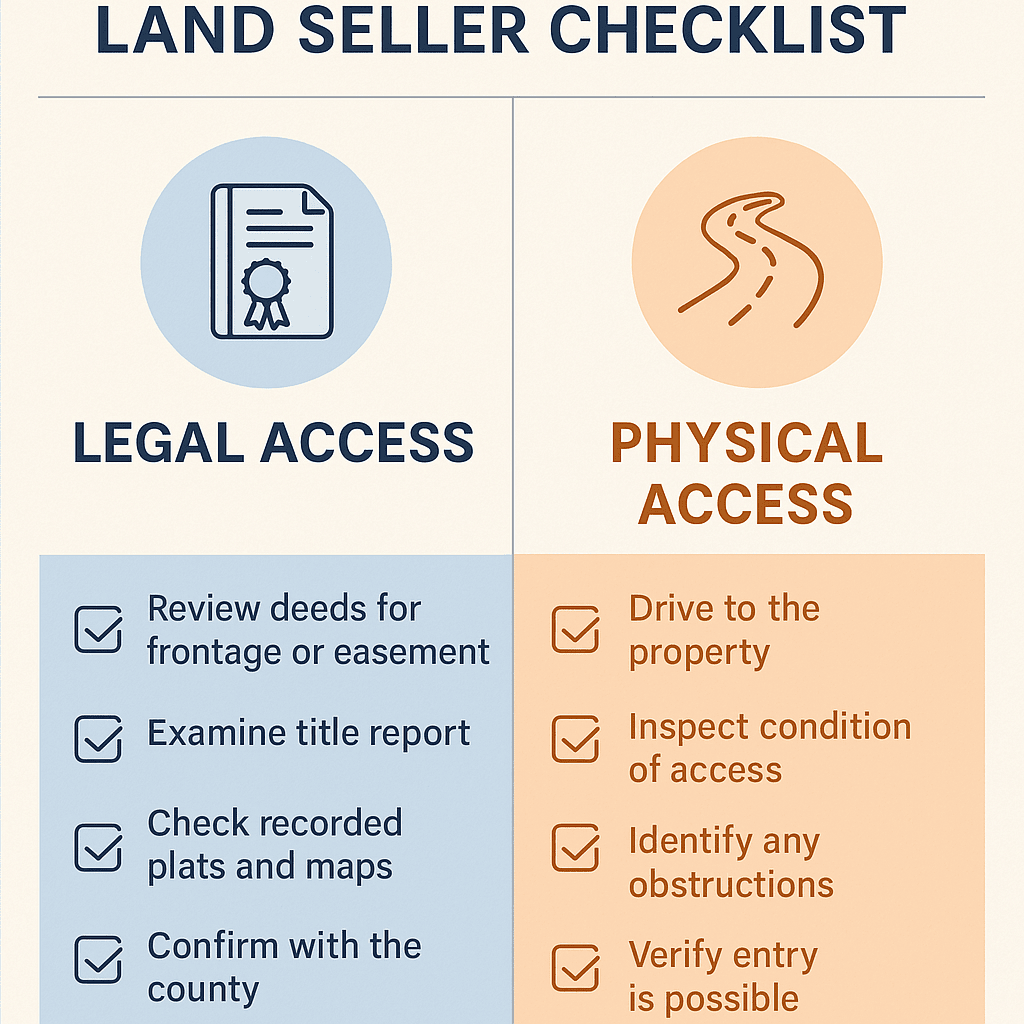
How To Sell Land: Understanding Easements, Rights-of-Way, and Shared Driveways
When figuring out How To Sell Land, one of the most common—and confusing—issues sellers face is dealing with easements, rights-of-way (ROWs), and shared driveways. These legal arrangements can have a major impact on your property’s value, appeal, and ability to close a deal smoothly.
Whether your land benefits from, or is burdened by, these agreements, knowing how they work and how to present them to buyers can make or break your sale.
1. What is an Easement?
An easement is a legal right for someone else to use a portion of your property for a specific purpose. You still own the land, but another party has usage rights.
Common Easement Types:
- Utility Easements: Allow power lines, water lines, or sewer pipes to cross your property.
- Access Easements: Allow a neighbor or another party to cross your land to reach theirs.
- Conservation Easements: Limit development to protect natural resources.
How To Sell Land Tip: Easements should always be disclosed to potential buyers. They may not hurt your sale if presented clearly with proper documentation.
2. Rights-of-Way (ROWs)
A Right-of-Way is a type of easement that allows travel across your land—either for vehicles, pedestrians, or utilities.
Examples:
- Public roads maintained by the county.
- Private lanes maintained by multiple landowners.
- Trails or paths for hiking or horseback riding.
How To Sell Land Tip: Verify if your ROW is recorded with the county and if there’s a maintenance agreement. Buyers will want to know who’s responsible for upkeep.
3. Shared Driveways
Shared driveways occur when two or more properties use the same driveway for access.
Potential Benefits:
- Cost-sharing for maintenance.
- Easier access in certain property layouts.
Potential Drawbacks:
- Disagreements over maintenance or usage.
- Legal disputes if agreements aren’t documented.
How To Sell Land Tip: Provide buyers with a copy of the recorded shared driveway agreement, including maintenance obligations.
4. How Easements and ROWs Affect Your Sale
- Value Impact: Some easements can limit how you use your land, potentially lowering its market value.
- Buyer Perception: Well-documented and maintained access easements can actually make a property more appealing.
- Financing: Lenders often require recorded easements for properties without direct road frontage.
5. How To Prepare Before Listing
- Gather Documentation: Deeds, plats, recorded agreements, and maps.
- Verify Recording: Ensure easements or ROWs are officially recorded with the county.
- Address Maintenance: If shared, confirm who is responsible for upkeep.
- Be Transparent: Disclose easements early to avoid deal-breaking surprises.
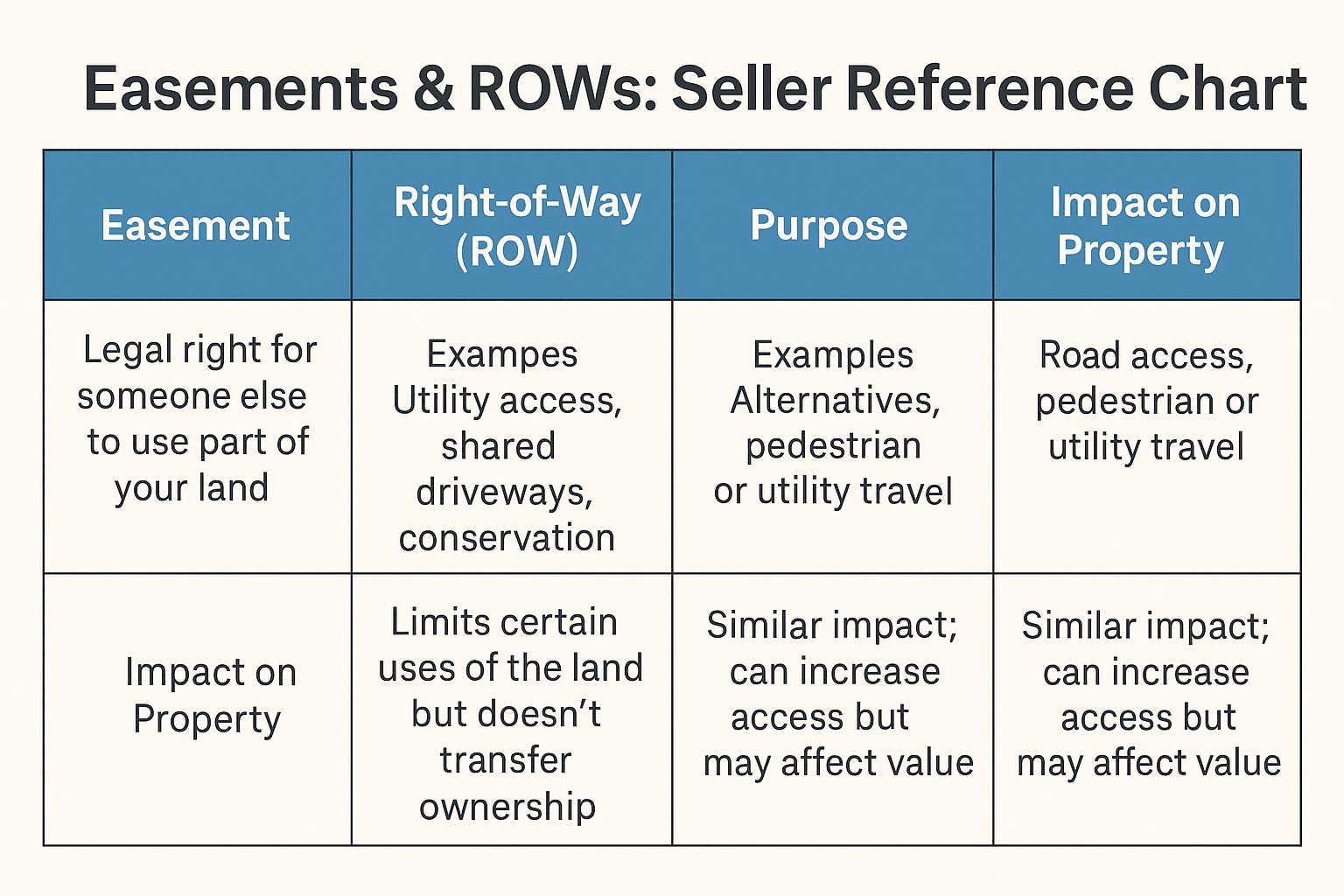
How To Sell Land: The Role of Utilities in Attracting Buyers
When figuring out How To Sell Land, one of the first questions buyers ask is: “What utilities are available?” Utilities can dramatically influence your land’s value, marketability, and the speed of the sale. A parcel with ready-to-use infrastructure is far more appealing than one requiring costly, time-consuming installation.
By understanding the different utility options—power, water, septic, natural gas, fiber/internet—you can market your land more effectively and avoid surprises during negotiations.
1. Power (Electricity)
Why It Matters: Electricity is often a must-have for buyers planning residential, commercial, or agricultural development.
How It Affects How To Sell Land:
- On-site power: Adds value and reduces buyer development costs.
- Nearby access: Still appealing, but the buyer will need to pay for a connection.
- Off-grid potential: Appeals to certain rural or recreational buyers.
Tip: Contact the local utility provider for connection details, costs, and timelines before listing.
2. Water (Municipal or Well)
Municipal Water:
- Often preferred in urban and suburban settings.
- Easy for buyers to hook up if a water main runs along the property.
Wells:
- Common in rural areas.
- Well depth, water quality, and flow rate are critical selling points.
How To Sell Land Tip: If you have a well, provide recent water quality reports to boost buyer confidence.
3. Septic Systems
Why It Matters: Not all areas have municipal sewer connections, so septic is essential for livability.
- Existing septic: Increases appeal and saves the buyer thousands.
- Perc test completed: If no system exists, a passed perc test makes selling easier.
Tip: Include septic permits and inspection records in your marketing package.
4. Natural Gas
Availability:
- More common in suburban and urban fringe areas.
- Increases appeal for residential or light commercial use.
How To Sell Land Tip: Check with the local gas company for line proximity and hookup feasibility.
5. Fiber / Internet
Why It Matters: High-speed internet is no longer optional for many buyers, especially remote workers.
- Fiber availability: Major selling point in rural markets.
- Satellite or wireless options: Alternative for more remote locations.
Tip: List available internet providers and speeds in your marketing materials.
6. Other Utilities & Infrastructure
- Phone lines (landline service).
- Irrigation water rights (for agricultural parcels).
- Drainage systems (especially in flood-prone areas).
7. Marketing Strategy for Utilities
When learning How To Sell Land, remember:
- Highlight existing utilities upfront in the listing description.
- Disclose connection costs if they are significant.
- Include maps and photos showing utility locations on the property.
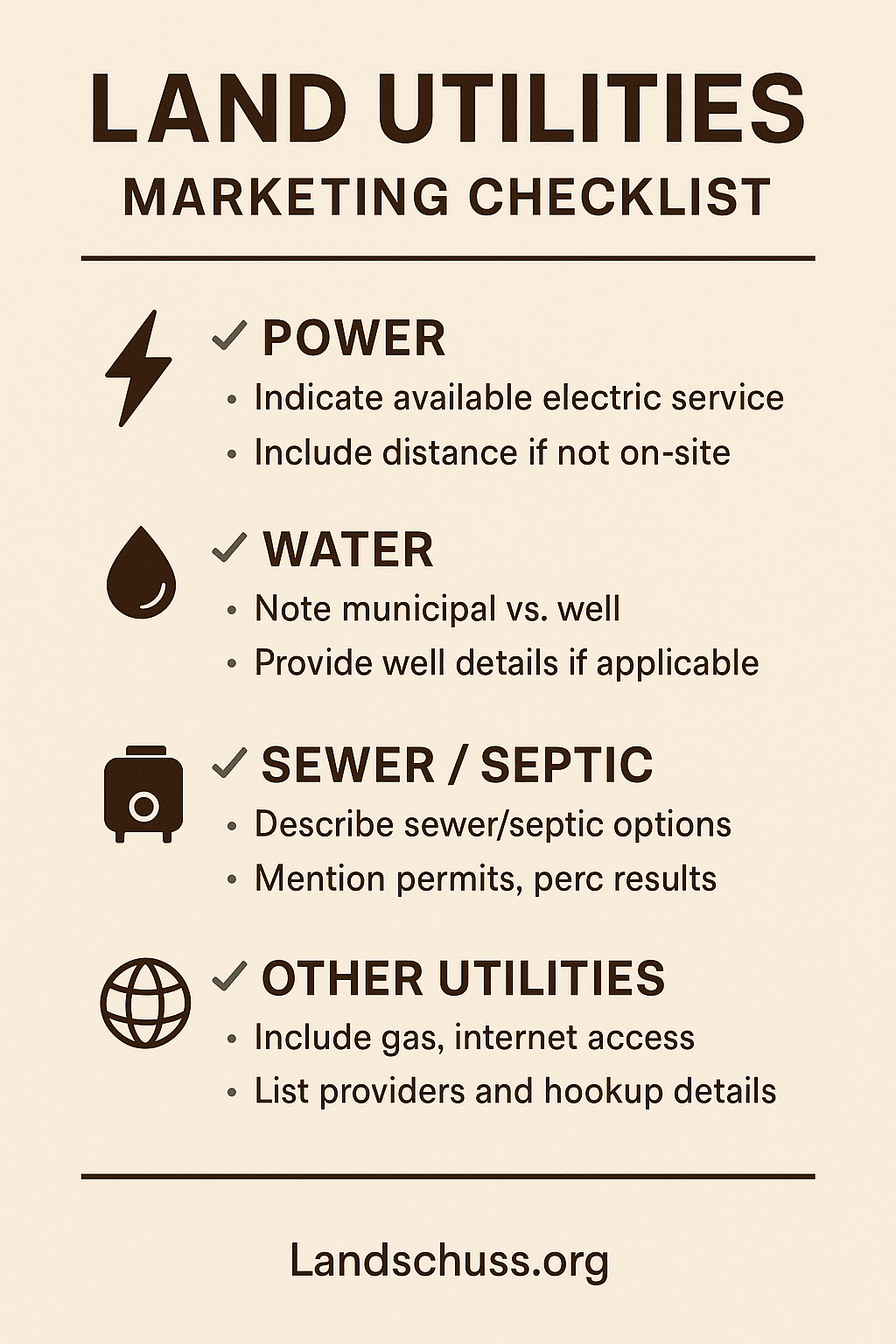
How To Sell Land: Understanding the Costs to Bring Utilities
When learning How To Sell Land, one of the most common questions buyers ask is, “How much will it cost to get utilities here?”
Whether your property has no services yet or limited connections, understanding the costs—and who is responsible for paying them—can make your sale smoother and more transparent.
By preparing accurate estimates and documentation from utility providers in advance, you can remove uncertainty and position your property as a smart investment.
1. Who Pays for Utility Installation?
In most real estate transactions, buyers pay for utility installation after purchase. However, in competitive markets—or if your property is harder to sell—you may offer to:
- Share the cost to make the property more appealing.
- Install key utilities upfront to raise the price and attract more interest.
How To Sell Land Tip: Offering partial or full utility installation can be a strong marketing advantage, especially if nearby properties already have access.
2. Typical Utility Connection Costs
Electricity:
- Cost depends on distance to the nearest power pole, terrain, and whether new poles must be installed.
- Typical Range: $5,000–$30,000+ in rural areas; less if close to existing lines.
Water (Well or Municipal):
- Municipal hookup: $1,000–$5,000 for tap fees plus trenching.
- Well drilling: $3,000–$15,000 depending on depth and geology.
Septic System:
- $5,000–$12,000 for installation.
- Requires a successful perc test before permitting.
Natural Gas:
- If a line runs nearby: $500–$2,000.
- If not: Can be cost-prohibitive and require propane as an alternative.
Fiber / Internet:
- $500–$5,000 depending on provider and trenching needs.
- Rural areas may require satellite or fixed wireless as alternatives.
3. Why Utility Estimates Matter
Buyers are often hesitant to move forward without knowing utility costs.
How To Sell Land Tip: Providing realistic estimates upfront builds trust and helps your property stand out.
4. Getting Letters from Providers
One of the most valuable marketing tools when selling land is a Utility Availability Letter from each provider. These letters:
- Confirm if service is available.
- Outline the installation process.
- Provide an estimated cost and timeline.
How To Sell Land Tip: Contact each provider—power, water, septic, internet—and request a written statement you can share with buyers.
5. How to Present Utility Cost Info in Your Listing
- Include a Utility Summary Sheet with your marketing package.
- Use bullet points to list each service, availability, and estimated cost.
- Add scanned copies or PDFs of provider letters.
- Highlight any cost-sharing incentives you’re offering.
How To Sell Land: Navigating Zoning, Rezoning, and Density Studies
When figuring out How To Sell Land, one of the most important steps is understanding what can be built on your property—and what might be possible if zoning changes. Zoning rules determine everything from building height to allowed uses, and they can either limit or expand your buyer pool.
By learning how to look up zoning, assess rezoning potential, and conduct density or yield studies, you can better position your land in the market and speak confidently with buyers.
1. Zoning Lookups: The Starting Point
Why It Matters: Buyers want to know exactly what they can do with the land. Zoning determines permitted uses, minimum lot sizes, setbacks, and building requirements.
How To Look It Up:
- Visit your county or city planning department website. Many have an interactive GIS map where you can enter your parcel number to see zoning designations.
- Contact the planning office directly if you need clarification.
- Review zoning codes for allowed uses under your land’s classification (e.g., residential, agricultural, commercial).
How To Sell Land Tip: Print or download your zoning code and include it in your marketing package to answer buyer questions instantly.
2. Rezoning Feasibility
Sometimes, your property’s value increases significantly if it’s rezoned to allow a different use.
Example: Agricultural land rezoned to residential may allow subdivision for housing.
Key Steps for Evaluating Rezoning:
- Check the Comprehensive Plan: This is the city or county’s long-term growth vision. If your land’s future use matches your rezoning request, odds improve.
- Speak with the Planning Department: Ask about rezoning timelines, application fees, and success rates.
- Understand Community Impact: Rezoning often requires public hearings—neighbor opposition can affect approval.
How To Sell Land Tip: If rezoning looks promising, mention “rezoning potential” in your listing to attract developers.
3. Density and Yield Studies
What They Are:
A density or yield study estimates how many units (homes, apartments, etc.) can be built on your land under current or potential zoning.
Why They Matter:
- Developers use them to calculate profitability.
- Higher allowable density often means higher land value.
Basic Components:
- Zoning restrictions (minimum lot size, setbacks, height limits).
- Environmental constraints (wetlands, flood zones, slopes).
- Infrastructure availability (roads, utilities).
How To Sell Land Tip: Having a yield study in hand can help buyers quickly assess your property’s development potential, speeding up offers.
4. Marketing Strategy for Zoning & Density Info
When selling land, zoning clarity is a selling tool. Consider:
- Including zoning maps in your listing.
- Highlighting potential rezoning opportunities.
- Providing density/yield estimates for serious developer prospects.
- Sharing planning department contact info so buyers can verify details themselves.

How To Sell Land: Subdividing Lots for Maximum Value
One of the most effective strategies in How To Sell Land for a higher total return is subdividing your property into smaller lots. While a large parcel may appeal to certain buyers, breaking it into multiple pieces can attract a broader range of prospects and often yield a higher combined sale price.
However, subdividing is not as simple as drawing lines on a map—it’s a regulated process involving permits, surveys, infrastructure, and timelines that vary by location.
1. Why Consider Subdividing Land?
Higher Per-Acre Value: Smaller lots often sell for more per acre than large parcels.
Expanded Buyer Pool: Smaller, more affordable parcels appeal to individual homebuilders, investors, and families.
Flexible Selling Strategy: You can sell some lots now and hold others for future appreciation.
How To Sell Land Tip: Compare current market prices for large tracts vs. smaller lots in your area before committing.
2. The Subdivision Process
The process for subdividing land varies depending on your state, county, and municipality, but typically involves:
Step 1: Research Local Regulations
- Contact your county or city planning department to understand subdivision rules.
- Learn minimum lot sizes, road frontage requirements, and utility access needs.
Step 2: Hire a Land Surveyor
- A surveyor will map out proposed lot boundaries, easements, and access points.
- Their plat maps become part of your official subdivision application.
Step 3: Submit Application for Approval
- Applications go to the planning commission or zoning board.
- May require public hearings if rezoning or significant changes are involved.
Step 4: Install Required Infrastructure
- Roads, drainage, water lines, sewer/septic, and utilities.
- These costs can be substantial and must meet local development standards.
Step 5: Record the New Lots
- Once approved, new legal descriptions are recorded with the county.
- Each lot receives its own parcel number for tax and sale purposes.
3. Typical Costs to Subdivide Land
Costs vary widely, but here are common expenses:
- Surveying: $1,000–$5,000+ depending on property size and complexity.
- Engineering/Plat Design: $2,000–$15,000.
- Permit & Application Fees: $500–$5,000.
- Road & Utility Installation: $10,000–$50,000+ depending on requirements.
- Environmental Studies (if needed): $1,000–$10,000.
How To Sell Land Tip: Get multiple quotes from surveyors, engineers, and contractors before committing.
4. Timelines for Subdividing Land
Subdivision projects can take:
- Small/simple splits: 3–6 months.
- Larger/more complex projects: 12–24 months.
The biggest factors affecting timelines are:
- Local planning commission schedules.
- Environmental or zoning reviews.
- Time to install infrastructure.
5. Marketing Subdivided Lots
Once your lots are approved:
- List individually: Highlight different lot sizes, features, and pricing.
- Bundle pricing: Offer discounts for buyers purchasing multiple lots.
- Emphasize readiness: If utilities and access are in place, promote “shovel-ready” status.

How To Sell Land: Understanding Building Restrictions, Setbacks, and HOA/POA Rules
When learning How To Sell Land, one of the most important things you can do is educate potential buyers about any limitations on what they can build. Many deals fall apart when buyers discover restrictions late in the process—something you can prevent by being upfront and prepared.
From local building codes to homeowner association (HOA) or property owner association (POA) rules, these regulations can have a major impact on the value and appeal of your land.
1. Building Restrictions: The Basics
What They Are:
Building restrictions are rules set by city, county, or other governing bodies that limit how and what you can build.
Common Examples:
- Minimum or maximum building size.
- Prohibited structures (e.g., mobile homes, certain outbuildings).
- Restrictions on height, design, or materials.
How To Sell Land Tip: Visit your local building department and request a land use and building restrictions summary you can share with buyers.
2. Setbacks and Why They Matter
Definition:
Setbacks are the required distances between structures and property lines, roads, waterways, or other features.
Typical Requirements:
- Front yard: 20–50 feet from the road.
- Side yard: 5–20 feet from the property line.
- Rear yard: 10–30 feet from the back property line.
Setbacks can limit the size and placement of buildings, especially on small or oddly shaped lots.
How To Sell Land Tip: Ask your county planning office for a setback diagram to include in your marketing materials.
3. HOA/POA Rules
If your land is in a subdivision or private community, it may be subject to HOA (Homeowners Association) or POA (Property Owners Association) rules.
Common HOA/POA Restrictions:
- Architectural approval before building.
- Landscaping and fencing requirements.
- Limitations on exterior colors or finishes.
- Restrictions on vehicle parking or outbuildings.
Why It Matters in How To Sell Land:
- Some buyers prefer HOAs for their property value protections.
- Others avoid them due to fees and restrictions.
- Disclosing rules early prevents wasted time with incompatible buyers.
4. How to Present Restrictions Without Scaring Buyers
While restrictions can seem like a negative, they also protect the neighborhood’s look, feel, and property values. When marketing, frame them as:
- Ensuring quality development.
- Preventing undesirable construction nearby.
- Maintaining resale value over time.
5. Action Steps Before Listing Your Land
- Get a Full Copy of the HOA/POA Covenants, Conditions, and Restrictions (CC&Rs) if applicable.
- Confirm setback requirements with the local planning office.
- Document building restrictions from local codes.
- Create a Restrictions Summary Sheet for buyers.
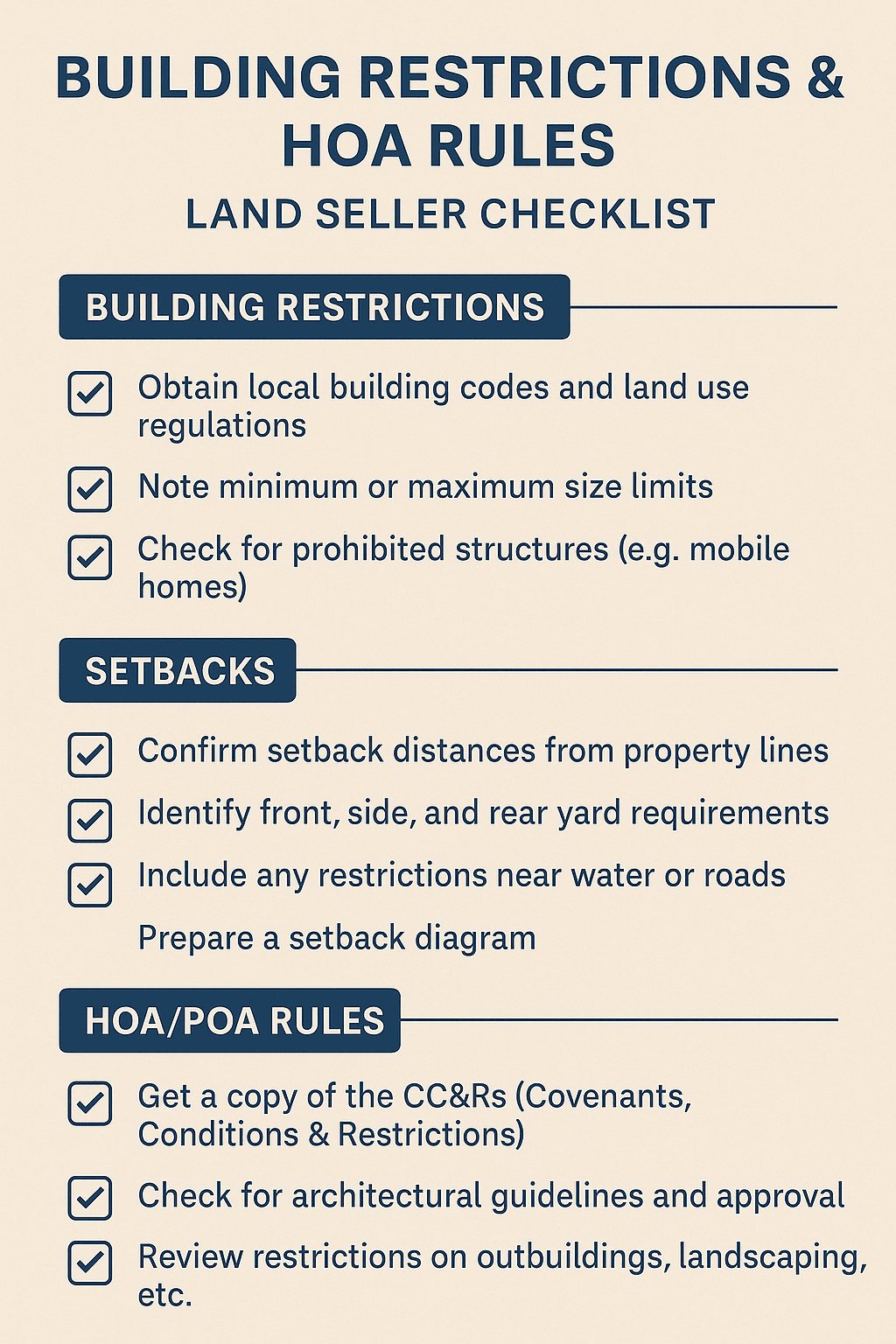
Understanding Agricultural Exemptions, Greenbelt, and Timber Plans
When exploring How To Sell Land, especially large rural parcels, understanding tax exemptions and land use programs can make a huge difference in attracting buyers and negotiating the best deal.
Programs like agricultural exemptions, greenbelt classifications, and timber management plans can lower annual property taxes and appeal to farmers, ranchers, investors, and conservation-minded buyers. Knowing how these work—and how to present them—can help you sell faster and for more money.
1. Agricultural Exemptions
What They Are:
An agricultural exemption is a special tax classification that reduces property taxes for land used in farming, ranching, or similar production.
Why It Matters in How To Sell Land:
- Buyers inherit potential tax savings.
- Properties with active ag exemptions can be more attractive to investors and operators.
Seller Tips:
- Confirm with your county appraisal district or assessor whether the exemption is active.
- Gather proof of qualifying use (livestock records, crop receipts, grazing leases).
- Disclose renewal requirements to the buyer—some states require continuous ag use to keep the exemption.
2. Greenbelt Programs
What They Are:
Greenbelt laws (also called “open space” or “conservation use” programs) offer reduced property taxes for land kept in agricultural, timber, or open-space use rather than development.
Why Buyers Like Them:
- Significantly lower annual tax bills.
- Encourages long-term land stewardship.
How To Sell Land Tip: Provide buyers with your current property tax bill, showing the difference between the greenbelt valuation and the market value.
3. Timber Management Plans
What They Are:
A timber management plan outlines sustainable forestry practices and may qualify land for special timber tax classifications.
Benefits to Buyers:
- Reduced property taxes in states with timber exemptions.
- Income potential from timber harvests.
- Long-term investment growth.
Seller Tip: Have a copy of the active timber plan available, along with maps of tree species, ages, and harvest schedules.
4. Other Special Classifications
Depending on your state, you may also encounter:
- Wildlife management exemptions – for land managed to support native species.
- Conservation easements – limiting development to protect natural resources.
- Floodplain/ag use overlays – offering special tax treatment or restrictions.
How To Sell Land Tip: Make a list of every tax or use program affecting your property and clearly explain them in your marketing.
5. Key Marketing Strategies for Land With Special Exemptions
- Highlight tax savings in your listing headline or bullet points.
- Provide official documentation from the tax assessor’s office.
- Explain how buyers can maintain or transfer these benefits.
- Be transparent about any penalties if the buyer changes land use.
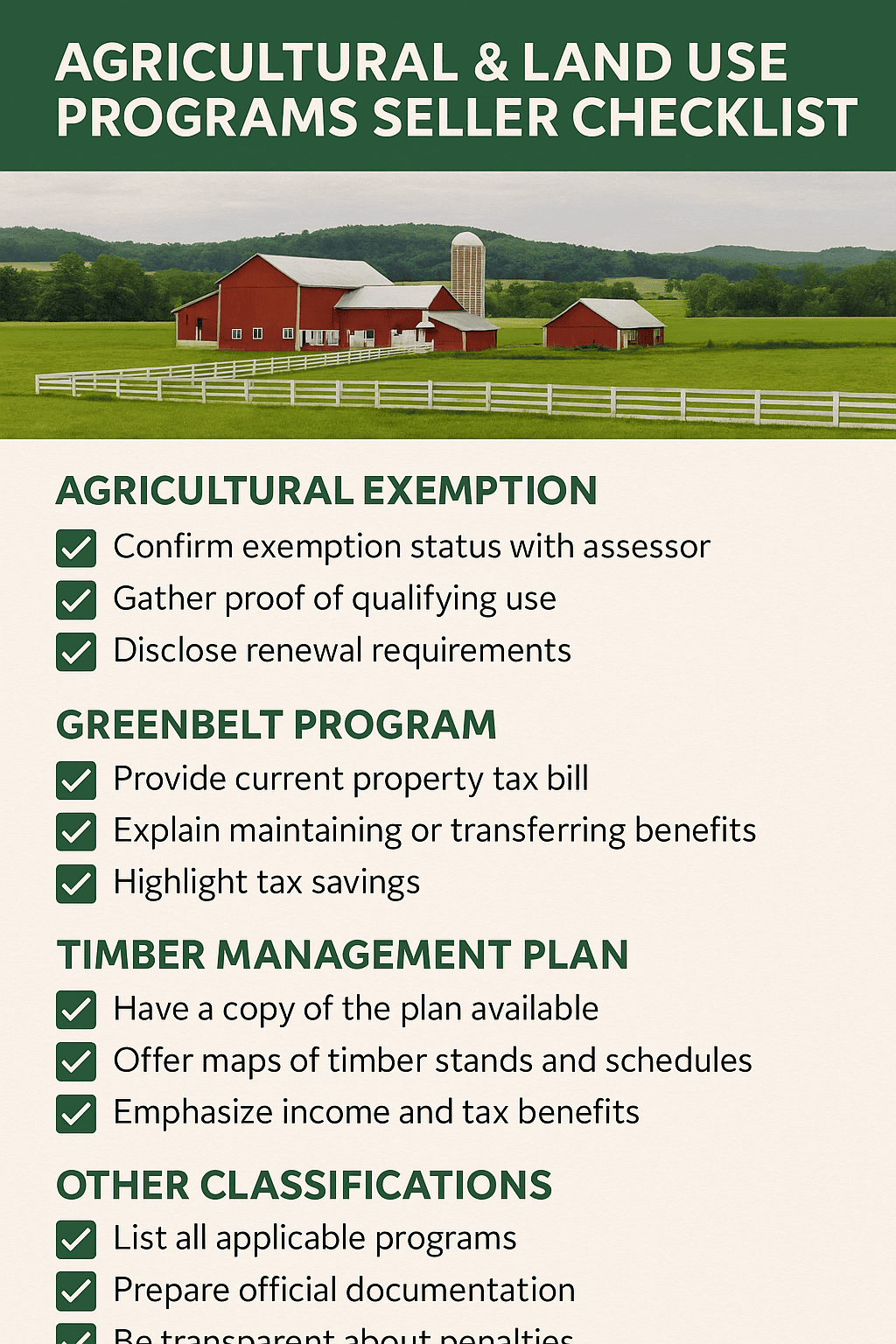
How To Sell Land: Understanding Impact Fees and Concurrency
When learning How To Sell Land, it’s important to look beyond just zoning and property size. Two often-overlooked factors—impact fees and concurrency requirements—can significantly influence your buyer pool, sales timeline, and asking price.
If you’re selling to developers, builders, or investors, these terms are critical. They can affect not only the cost of building on your land but also whether a project can even move forward right away.
1. What Are Impact Fees?
Definition:
Impact fees are charges assessed by local governments on new development to help fund the public infrastructure needed to support growth.
What They Cover:
- Roads and transportation improvements.
- Water and sewer system expansions.
- Parks and recreation facilities.
- Schools, police, and fire services.
Why They Matter in How To Sell Land:
- High impact fees can make a project less attractive to buyers.
- Lower or waived fees can be a selling point in certain markets.
- Fees can vary widely between jurisdictions—even within the same county.
Seller Tip: Contact your local planning or building department to get a current impact fee schedule and provide it to potential buyers.
2. What Is Concurrency?
Definition:
Concurrency laws require that necessary public infrastructure (roads, utilities, schools, etc.) be available at the same time new development occurs.
Key Points:
- If the infrastructure isn’t in place, a project may be delayed until upgrades are completed.
- This can push a development timeline back months—or even years.
- Concurrency requirements vary by state and municipality.
How To Sell Land Tip: Know whether your area has concurrency rules and whether your land meets them today. This can be a decisive factor for builders.
3. How These Factors Influence Pricing
- High Impact Fees + Concurrency Delays = Buyers may offer less or pass altogether.
- Low Fees + Ready Infrastructure = Land can command a premium because development can start immediately.
- Incentive Programs – Some areas reduce fees or fast-track permitting to encourage certain types of projects, such as affordable housing or commercial investment.
4. Action Steps for Sellers
- Request an Impact Fee Breakdown – Include totals for residential, commercial, or industrial uses.
- Verify Concurrency Status – Check if infrastructure is adequate for development now.
- Highlight Positive Factors – If fees are low or infrastructure is ready, make that part of your marketing.
- Prepare Buyers for Costs – Transparency builds trust and reduces last-minute deal killers.
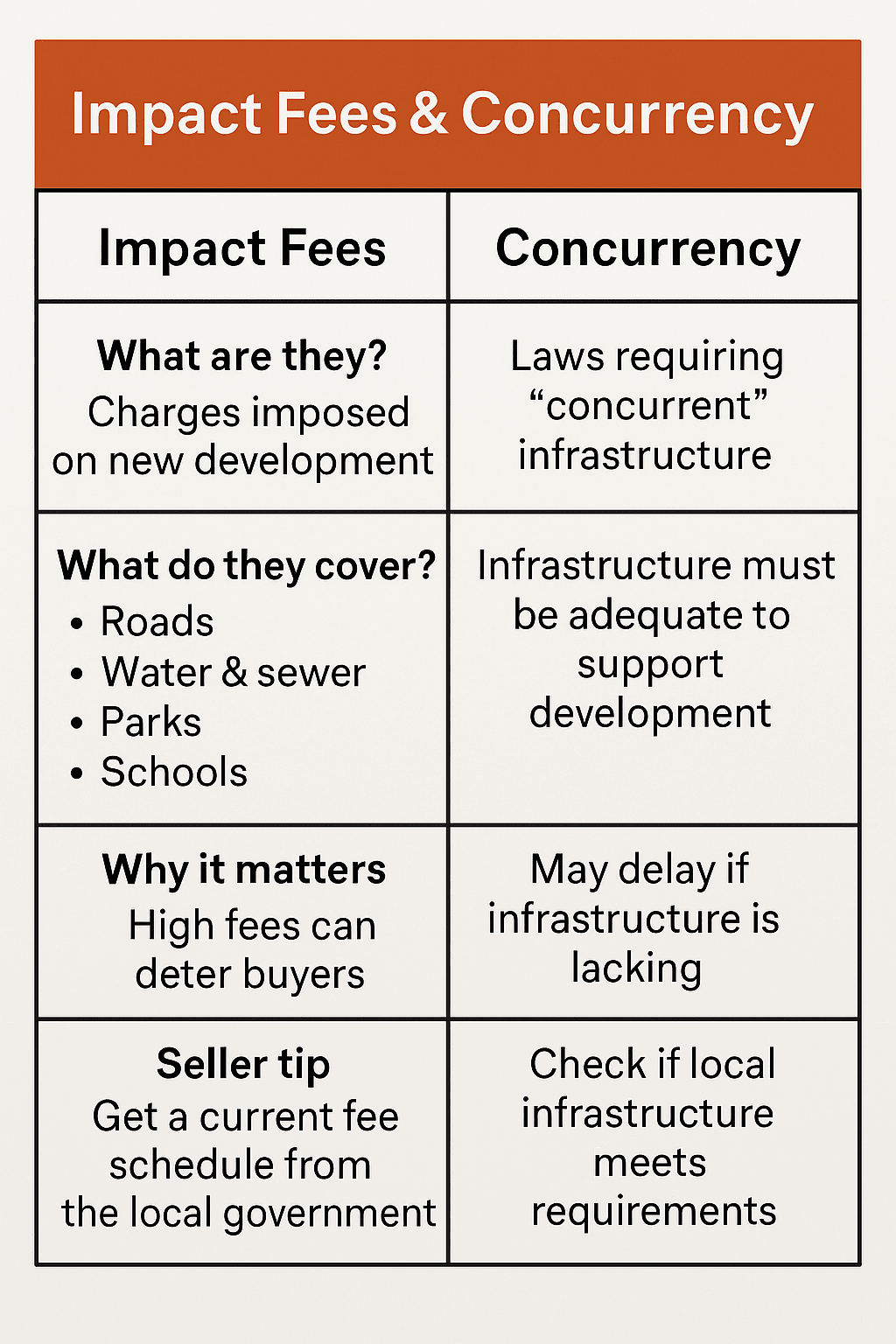
How To Sell Land: Title Search, Liens, and Encumbrances
When figuring out How To Sell Land, the legal side of the transaction can be just as important as the marketing and pricing. Before you list your property or accept an offer, it’s essential to understand the role of title searches, liens, and encumbrances—and how they can affect your ability to close the deal.
1. Title Search: The Foundation of a Clean Sale
What It Is:
A title search is a review of public records to confirm the legal ownership of the land and identify any claims or restrictions against it.
Why It Matters in How To Sell Land:
- Confirms you have the legal right to sell.
- Identifies potential obstacles before they derail the sale.
- Gives buyers confidence that the property is free from undisclosed issues.
Seller Tip: Order a pre-listing title search through a title company or real estate attorney. This allows you to fix problems before a buyer’s due diligence begins.
2. Liens: Hidden Financial Claims
Definition:
A lien is a legal claim against the property for unpaid debts. Common examples include:
- Property tax liens – from unpaid local taxes.
- Mortgage liens – if the property was used as collateral for a loan.
- Mechanic’s liens – from contractors who weren’t paid for work on the land.
Impact on Selling:
You generally can’t transfer ownership until all liens are satisfied or negotiated. In How To Sell Land, clearing liens early avoids last-minute deal cancellations.
3. Encumbrances: Restrictions Beyond Money
Definition:
An encumbrance is any restriction or limitation on the property’s use that may reduce its value or desirability. Examples include:
- Easements (utility, access rights for neighbors).
- Deed restrictions (limiting building type or use).
- HOA/POA rules (if part of a community).
Why It Matters:
Encumbrances stay with the land even after it changes hands, so buyers need full disclosure to make informed decisions.
4. How to Prepare for a Smooth Closing
- Run a Title Search Early – Fix issues before listing.
- Request a Payoff Statement for Any Liens – Know exactly what’s owed.
- Gather Encumbrance Documents – Include easement maps, HOA covenants, or deed restrictions in your listing package.
- Be Transparent – Surprises kill deals; upfront honesty builds trust.
5. Marketing Advantage of a Clear Title
A property with “clear title” can be marketed as move-in ready for development—a big draw for buyers who don’t want legal delays. In How To Sell Land, advertising that your title is clean and verified can help you stand out in competitive markets.
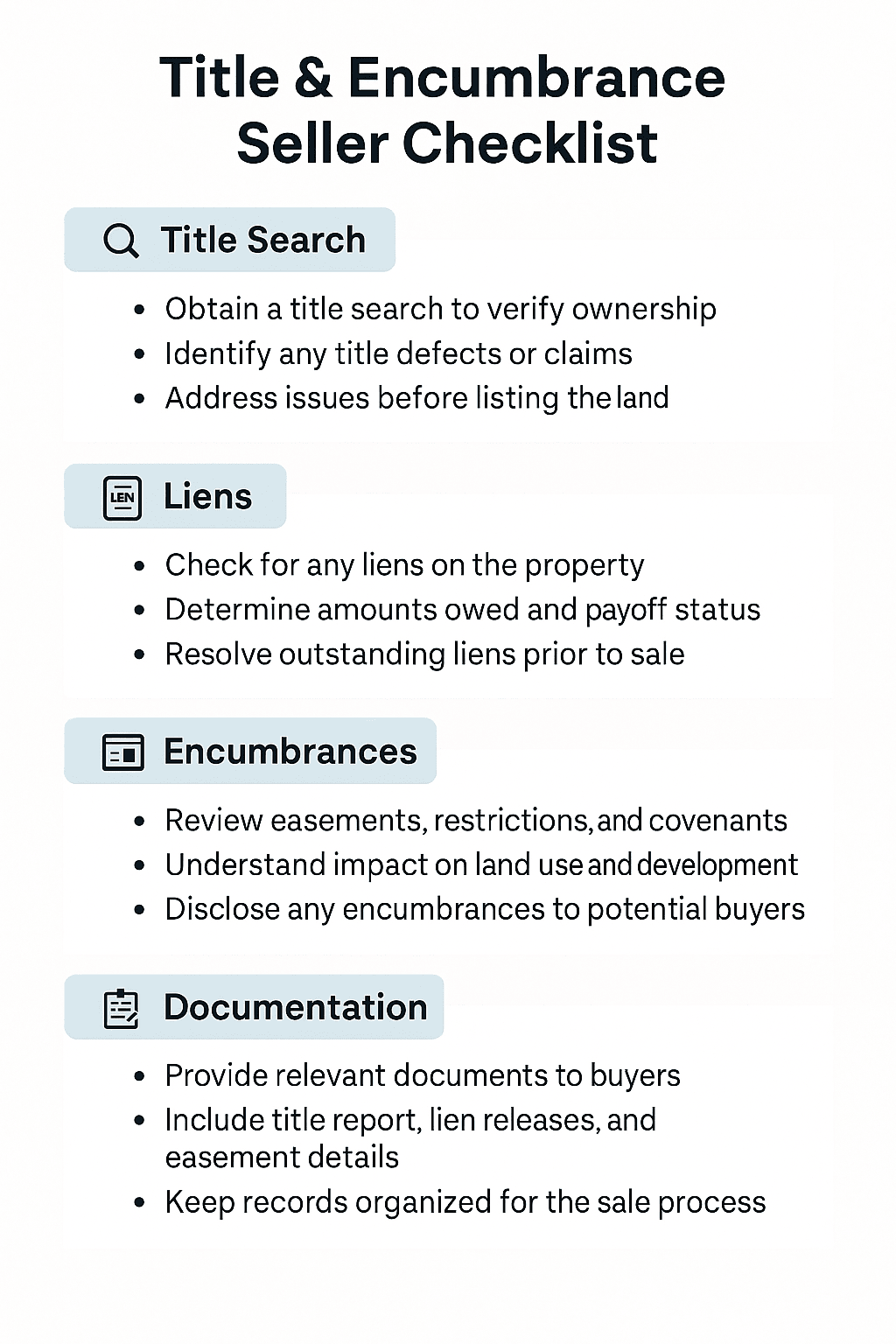
How To Sell Land: Inherited Property, Probate, and Heirs’ Rights
Selling inherited land can be both an emotional and a legal challenge. When figuring out How To Sell Land that has been passed down to you, understanding the probate process, heir entitlements, and the legal steps required is essential to avoiding delays and disputes.
1. Understanding Probate and How It Affects Selling
What Probate Is:
Probate is the legal process used to settle a deceased person’s estate. It ensures debts are paid, and the remaining assets (including land) are distributed according to the will—or state law if there’s no will.
How It Impacts How To Sell Land:
- In many cases, you can’t transfer ownership until probate is complete.
- Court approval may be required to list and sell the land.
- The executor or personal representative has the authority to act on behalf of the estate.
Tip: If the land is jointly owned with rights of survivorship, probate may not be required—title can transfer directly to the surviving owner.
2. Determining Who Has the Right to Sell
If you’re researching How To Sell Land that’s inherited, the first step is confirming who actually owns it now. This depends on:
- A valid will – The will names beneficiaries.
- State intestacy laws – If there’s no will, laws determine which relatives inherit.
- Number of heirs – If multiple heirs inherit jointly, all must agree to sell (or transfer their share).
Potential Issues:
- Disputes between heirs can delay or block a sale.
- A buyout option may be needed if one heir wants to keep the land.
3. Common Costs and Obligations Before Selling
When learning How To Sell Land that’s inherited, remember that you may need to address:
- Property taxes – Ensure they are current.
- Outstanding debts or liens – These must be cleared before closing.
- Maintenance – If the property is vacant, you may need to handle upkeep until it sells.
4. Special Considerations for Inherited Land Sales
- Capital Gains Taxes: Your tax basis is generally “stepped up” to the land’s fair market value at the time of the owner’s death, which may reduce taxable gains when selling.
- Probate Timelines: Probate can take months to over a year depending on complexity.
- Selling As-Is vs. Improvements: Decide whether to sell in current condition or invest in cleanup and presentation.
5. Steps to Selling Inherited Land
- Confirm Ownership – Determine if probate is required and who the legal heirs are.
- Hire Professionals – A probate attorney and a land-specialized real estate agent can guide you.
- Resolve Debts – Pay taxes and liens from the estate before closing.
- Agree Among Heirs – Get all co-owners on board with selling.
- List the Property – Use marketing tailored for land buyers, not just traditional homebuyers.

How To Sell Land: Legal Considerations for Mineral Rights, Boundary Disputes, and Easements
When researching How To Sell Land, it’s easy to focus on pricing, marketing, and finding a buyer. But legal factors—such as mineral, timber, and water rights; boundary disputes; conservation easements; and deed restrictions—can dramatically influence a sale’s success. Ignoring these issues can lead to delays, renegotiations, or even lawsuits.
1. Mineral, Timber, and Water Rights
Mineral Rights
In many states, mineral rights can be severed from surface rights. This means someone other than the landowner may own the rights to oil, gas, or minerals beneath the property.
- Why It Matters: If mineral rights are excluded, buyers may offer less.
- How To Sell Land Tip: Confirm whether you own full or partial mineral rights before listing.
Timber Rights
These grant ownership of trees for logging purposes, often through separate contracts or leases.
- If timber rights have been sold, the buyer may inherit obligations to allow logging.
Water Rights
Water access—especially in agricultural or drought-prone areas—can make or break a land deal.
- Verify whether rights are included, leased, or subject to restrictions.
2. Boundary Disputes
A boundary dispute occurs when neighboring landowners disagree on where the property line lies.
- Causes: Inaccurate surveys, fence placement, or outdated legal descriptions.
- Impact on How To Sell Land: Buyers may walk away if boundaries aren’t clear.
- Solution: Order a recent survey and resolve disputes before listing.
3. Conservation Easements
A conservation easement is a legal agreement that limits the type and scope of development allowed on a property, often to protect wildlife habitats, open spaces, or agricultural land.
- Benefits: Can offer tax advantages.
- Drawbacks: May significantly limit what a buyer can do with the property.
- How To Sell Land Tip: Fully disclose easement terms upfront to avoid deal-breaking surprises.
4. Deed Restrictions
Deed restrictions (also called restrictive covenants) are rules placed in the property’s deed that limit use.
- Examples include prohibiting certain types of buildings, requiring specific setbacks, or banning certain activities (like hunting or RV parking).
- Common in HOA/POA communities.
Seller Tip: Gather all governing documents (HOA rules, recorded covenants) so buyers understand limitations.
5. Preparing for a Legally Clean Sale
When navigating How To Sell Land with potential legal complications:
- Run a Title Search – Identify recorded easements, restrictions, and rights.
- Order a Survey – Clarify boundaries before listing.
- Consult a Real Estate Attorney – Especially important for high-value or complex land sales.
- Disclose Everything – Transparency prevents future legal claims.
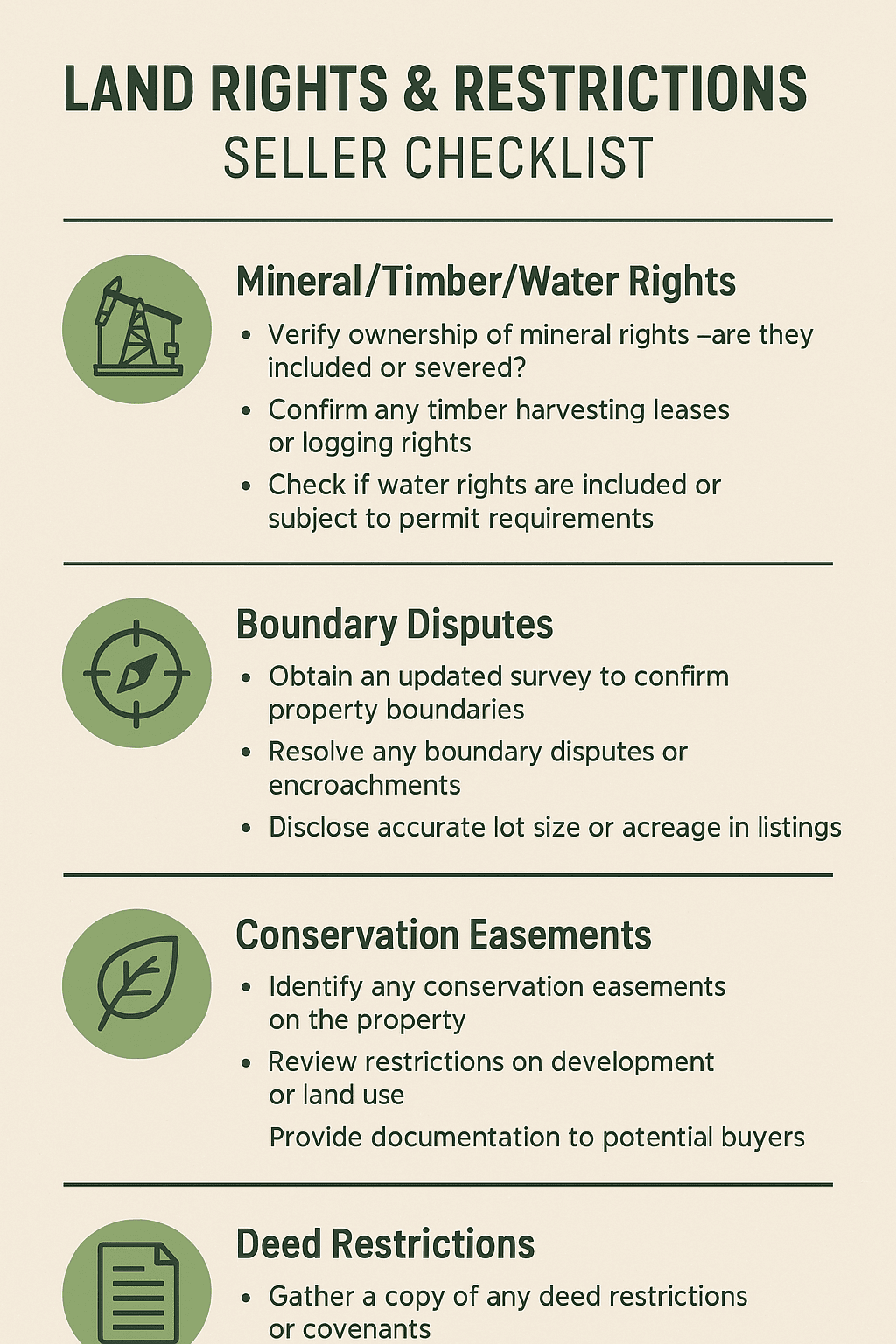
How To Sell Land: Taxes, Money, and Financial Considerations Every Seller Should Know
Selling land isn’t just about finding a buyer—it’s about understanding how the transaction impacts your finances, both now and in the future. Whether you’re selling a small rural lot or hundreds of acres, knowing the tax rules, potential deductions, and financial strategies can help you keep more of your profit.
This guide walks through capital gains taxes, 1031 exchanges, back taxes and liens, property tax prorations, and creative financing options so you can confidently navigate How To Sell Land without costly surprises.
1. Capital Gains Taxes on Land Sales
When you sell land for more than you paid for it (plus certain allowable costs), the profit is considered a capital gain.
- Short-Term vs. Long-Term Gains
- Short-Term: If you owned the land for less than one year, the profit is taxed as ordinary income.
- Long-Term: If you owned it for more than a year, the gain is taxed at the capital gains rate (often lower than income tax rates).
- How To Sell Land Tip: Keep detailed records of your purchase price, improvements, and selling expenses (surveys, marketing, legal fees) to reduce your taxable gain.
2. 1031 Exchange Basics
A 1031 exchange allows you to defer paying capital gains taxes if you reinvest the proceeds from your sale into another “like-kind” property.
- The replacement property must be of equal or greater value.
- You must identify the new property within 45 days and close within 180 days of your land sale.
- A qualified intermediary must hold the sale proceeds—you can’t touch the money.
- When to Consider: If you’re learning How To Sell Land and plan to reinvest in other real estate, a 1031 exchange can preserve your capital for the next purchase.
3. Back Taxes, Tax Liens, and Redemption Periods
Before you sell, check whether there are any unpaid property taxes.
- Back Taxes: Must be paid at or before closing, typically from the seller’s proceeds.
- Tax Liens: If the property is in tax foreclosure, the buyer may be able to redeem it by paying the owed taxes—but this reduces your negotiating power.
- Redemption Periods: Some states allow owners to reclaim land after a tax sale by paying all due taxes plus interest.
- How To Sell Land Tip: Order a title search early to uncover unpaid taxes or liens and avoid last-minute closing delays.
4. Property Tax Prorations at Closing
Most real estate transactions prorate property taxes so each party pays their fair share for the year.
- If you’ve already paid taxes for the year, you’ll get a credit for the buyer’s portion.
- If you haven’t paid, the amount owed for your portion will be deducted from your sale proceeds.
Example: If taxes are $1,200/year and you close on July 1, you’ll owe for the first half of the year ($600), and the buyer will cover the second half.
5. Installment Sales & Owner Carry Financing
Instead of receiving all proceeds upfront, you may agree to an installment sale or owner carry financing, where the buyer pays over time with interest.
- Benefits: Steady income stream, potential interest earnings, possible capital gains tax deferral.
- Risks: Buyer default, collection issues, and tying up your equity.
- How To Sell Land Tip: Use a legally binding promissory note and record the mortgage or deed of trust to protect your interest.
6. Financial Planning Before and After the Sale
When you’re learning How To Sell Land, think beyond just the sale price:
- Consult a CPA to project your tax liability and explore deferral strategies.
- Review how the proceeds will impact your overall income and possibly your tax bracket.
- Decide whether to reinvest, save, or use the funds for other purposes.

Marketing Strategy For Land Sales: How to Maximize Exposure and Attract the Right Buyers
Selling land requires a very different marketing approach than selling a house. Land buyers have different priorities, and they’re often searching for details that residential homebuyers wouldn’t think about—like zoning, access, and topography. An effective marketing strategy for land sales means combining the right platforms, compelling listing copy, high-quality visuals, and strong lead follow-up systems.
Below is a complete breakdown of how to position your property for maximum impact.
1. Best Websites to List Land
A strong online presence is essential for land sales. Consider using a mix of land-specific marketplaces and broader listing platforms.
Land Marketplaces
- LandWatch – One of the largest databases for land buyers.
- Lands of America – Owned by CoStar, connects to LandWatch for broader exposure.
- Land And Farm – Great for agricultural and recreational parcels.
- LandFlip – Includes multiple niche sites like RanchFlip, FarmFlip, and LotFlip.
- Zillow / Realtor.com / Trulia – Good for local visibility and reaching non-traditional buyers.
MLS (Multiple Listing Service)
- Even if you’re not using an agent, consider paying a flat-fee service to get your land on the MLS. This feeds your listing to major real estate sites automatically.
Specialty Sites for Unique Parcels
- LoopNet – For commercial or mixed-use properties.
- Craigslist / Facebook Marketplace – Can capture local buyers or investors.
2. Writing Land-Specific Listing Copy
Land buyers look for facts first, fluff second. Your listing should address their most common questions right away.
Key Elements to Include:
- Location details (county, nearest city/town, road access)
- Size and shape (acres, lot dimensions)
- Zoning and allowable uses (residential, agricultural, recreational, commercial)
- Utilities (power, water, septic, natural gas, fiber/internet availability)
- Access (paved, gravel, easement)
- Topography & soil type (flat, rolling, wooded, cleared)
- Unique selling points (mountain views, river frontage, hunting potential)
Pro Tip: Use bullet points at the top for quick scanning, then a narrative description for emotional appeal.
3. Photography, Drone Video & Map Overlays
Why it matters: Land without visuals feels invisible online. A simple text-only listing will be skipped over.
- Photography: Show the property from multiple angles—road frontage, interior shots, and views.
- Drone Video: Gives buyers an instant understanding of layout, surroundings, and terrain.
- Map Overlays: Use tools like Google Earth or GIS to outline property boundaries, access roads, and nearby landmarks directly on images.
4. Using GIS Links, Soil Maps, and FEMA Flood Maps
Providing factual resources saves buyers time and positions you as a trustworthy seller.
- GIS (Geographic Information Systems): Many counties offer free GIS maps with property lines, aerials, and tax data. Include the link in your listing.
- Soil Maps: USDA Web Soil Survey is a free tool for understanding soil composition—important for agriculture or building feasibility.
- FEMA Flood Maps: Show flood risk zones, which can influence insurance requirements and building plans.
By adding these links to your listing, you reduce unnecessary inquiries and attract serious buyers.
5. Lead Capture & Follow-Up
Many sellers make the mistake of only answering calls or emails—they don’t actively capture buyer information for follow-up.
- Lead Capture Tools: Use a simple form on your website or a CRM like HubSpot, Follow Up Boss, or Podio.
- Fast Response Time: Respond within hours, not days. Land buyers often inquire with multiple sellers at once.
- Follow-Up Sequences: Send additional photos, maps, and details to keep buyers engaged.
- Call to Action: Every conversation should end with a clear next step (schedule a site visit, make an offer, review documents).
Selling Land Methods Compared: Choosing the Right Approach for Your Property
When it comes to selling vacant land, there’s no one-size-fits-all approach. Your timeline, property type, location, and financial goals all play a role in determining the best selling method. Below, we compare the most common options—traditional listing with a land agent, selling to a land investor, land auctions, sealed bids, and iBuyer-style offers—so you can make an informed decision.
1. Traditional Listing with a Land Agent
How It Works:
You hire a licensed real estate agent who specializes in land to market the property, list it on the MLS, negotiate with buyers, and guide you through closing.
Pros:
- Broad exposure through MLS and online platforms
- Professional marketing, including photos, drone shots, and signage
- Agent expertise in pricing, zoning, and land-specific disclosures
- Negotiation handled on your behalf
Cons:
- Commission fees (often 6–10% for land)
- May take months—or years—to find the right buyer
- Some agents focus more on homes than land, so expertise varies
Best For: Sellers who want maximum market exposure, have time to wait for the right buyer, and prefer professional representation.
2. Selling to a Land Investor / Wholesaler
How It Works:
A land investor or wholesaler buys your property directly, often for cash, “as-is,” and with a quick closing—sometimes in as little as 1–4 weeks.
Pros:
- Fast closing, often without inspections or financing delays
- No need for repairs, clean-up, or surveying (unless required by title)
- Certainty of sale—no risk of buyer financing falling through
Cons:
- Offers are typically 40–70% of market value to account for resale margin
- Less exposure to other buyers who might pay more
Best For: Sellers who value speed and simplicity over top-dollar pricing, need to settle an estate, or want to offload a problem property quickly.
3. Land Auction
Types:
- Absolute Auction: Property sells to the highest bidder regardless of price.
- Reserve Auction: Seller sets a minimum price they’ll accept.
Formats:
- Online Auctions: Attract a larger, national audience and are convenient for remote buyers.
- Onsite Auctions: Can create a competitive atmosphere but draw mostly local bidders.
Pros:
- Creates urgency with a set sale date
- Competitive bidding can sometimes drive prices higher than expected
- Works well for unique or hard-to-value properties
Cons:
- No guarantee you’ll hit your target price (especially with absolute auctions)
- Auction fees (seller premiums, marketing costs) can be high
- Limited appeal for buyers who need financing
Best For: Properties with high demand, unique features, or motivated sellers looking for a defined timeline.
4. Sealed Bids / Call for Offers
How It Works:
Interested buyers submit their best offer by a certain deadline without knowing what others have bid.
Pros:
- Encourages serious buyers to put their best price forward
- Maintains privacy—offers are not public until selection
- Useful when demand is strong but price range is uncertain
Cons:
- If competition is low, offers may come in below expectations
- May require strong marketing to generate enough interest
Best For: Desirable parcels in competitive markets, development-ready sites, or situations where you want to control the negotiation timeline.
5. iBuyer-Style Offers for Land
How It Works:
Modeled after home-buying tech companies, some emerging platforms and investors make instant online cash offers for land.
Pros:
- Speed—offers within days, closings in weeks
- Low hassle, no traditional showings or marketing required
- Transparent process with upfront pricing
Cons:
- Lower sale price than traditional listing
- Still a niche option—fewer iBuyer services handle vacant land compared to houses
- May charge convenience fees or deduct for perceived risks
Best For: Sellers who want an instant decision and quick close with minimal interaction.

FSBO Land Selling: How to List, Negotiate, and Close Like a Pro
Selling land without a real estate agent—known as For-Sale-By-Owner (FSBO)—can be a cost-saving and empowering approach, especially if you understand the steps, tools, and legal requirements involved. If you’ve been wondering how to list, market, and close your land sale on your own, here’s a step-by-step guide to getting it done right.
1. Step-by-Step: How to List Land FSBO
Step 1: Research and Set Your Price
- Use recent comparable sales (land comps) from MLS data, county records, and land marketplace websites.
- Adjust for unique features: road frontage, utilities, zoning, views, and size.
Step 2: Prepare the Land
- Mow or clear overgrowth.
- Stake corners and flag boundaries.
- Install clear signage with your contact info.
- Take quality drone photos and ground-level shots.
Step 3: Write a Compelling Listing
- Include property basics (acreage, parcel number, location).
- Highlight key features buyers care about: utilities, access, zoning, and potential uses.
- Add maps, aerial imagery, and any surveys or reports you have.
Step 4: Choose Your Marketing Channels
- List on free or paid land marketplaces (Zillow, LandWatch, Land And Farm, Craigslist, Facebook Marketplace).
- Use a flat-fee MLS service (see below) for maximum exposure.
Step 5: Prepare to Respond to Inquiries
- Have your sales pitch ready.
- Keep a folder of property documents to send to interested buyers quickly.
2. Flat-Fee MLS for Land
One of the main challenges FSBO sellers face is getting onto the Multiple Listing Service (MLS), which is the primary database agents and buyers use to find property.
A flat-fee MLS service lets you list your property on MLS for a one-time fee (often $100–$500) without hiring a full-service agent.
Benefits:
- Appears on Realtor.com, Zillow, and local MLS feeds.
- Expands buyer pool beyond just those browsing FSBO sites.
Tips:
- Ensure the service supports land-specific listings.
- Read the fine print—some require you to offer a buyer’s agent commission (usually 2–3%).
3. Negotiation Scripts for Land Buyers
Land negotiations are different from home sales—buyers often have more questions about use, zoning, and access than about the price itself.
Example Script – Price Inquiry
Buyer: “Would you take less for the property?”
You: “I’m open to reasonable offers. Can you share your intended use for the property? That will help me determine if we’re a good match.”
Example Script – Lowball Offer
You: “I appreciate your offer, but based on recent sales in the area and the unique features of this parcel, I believe my asking price is fair. I could consider [slightly lower amount] if we can close quickly.”
Example Script – Due Diligence Questions
Buyer: “Can I walk the property?”
You: “Absolutely, but I’ll need to accompany you for safety. I’ll bring a copy of the survey so you can see the boundaries.”
4. Handling Showings/Walks Safely on Vacant Parcels
Vacant land showings are different from homes—there’s no doorbell or locked front door.
Safety tips:
- Never meet buyers alone in remote areas.
- Inform a friend/family member of the time and location.
- Carry a charged phone and have your vehicle nearby.
- Wear visible clothing if the land has thick brush or hunting activity nearby.
- Accompany all visitors; don’t allow unescorted access.
5. FSBO Forms & Disclosures (State Variations)
Selling land FSBO still requires legal documentation. Common items include:
- Purchase Agreement (land-specific)
- Property Disclosure Form (varies by state—some require none for raw land, others do)
- Lead-based paint disclosure (if there are any structures built before 1978)
- Septic/well reports (if applicable)
- Survey
- HOA/POA documents (if applicable)
Pro tip:
Check your state’s real estate commission or Department of Consumer Affairs website for free downloadable forms.
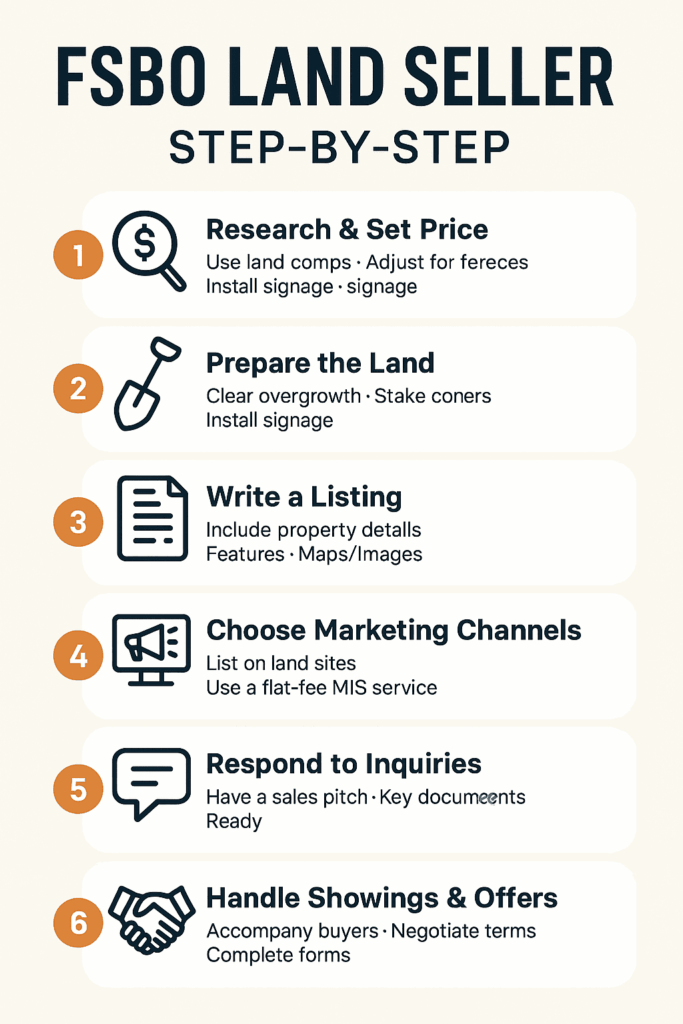
Working With a Land Real Estate Agent Specialist: What Sellers Need to Know
If you’ve been researching how to sell land, one of the most important decisions you’ll make is whether to work with a real estate agent—and if so, finding one who specializes in land. Land sales are not the same as home sales, and the wrong agent can cost you time, money, and opportunity. Here’s how to choose the right professional, understand the costs, and ensure they deliver results.
1. How To Choose a Land-Specialist Agent
When you’re figuring out how to sell land, you need an agent who understands more than just curb appeal and square footage. Look for someone who:
- Specializes in vacant land—not just houses. Ask for recent land sales in their portfolio.
- Understands zoning, access, and utilities—all critical factors that influence land value.
- Has a network of land buyers, developers, and investors.
- Uses land-specific marketing tools like aerial photography, GIS mapping, and soil/flood data.
Pro Tip: Interview at least three agents. Ask them exactly how they’ve marketed land in the past and what results they’ve achieved.
2. Commission Structures for Land vs. Houses
If you’re exploring how to sell land through an agent, be aware that commission rates for land are often higher than for houses.
- Typical house commission: 5–6% split between listing and buyer’s agents.
- Typical land commission: 6–10%, sometimes more for smaller parcels.
Why the difference? Land typically takes longer to sell and requires more specialized marketing. Be prepared to negotiate, but also understand the extra work and niche expertise involved.
3. Exclusive vs. Open Listings for Land
When deciding how to sell land with an agent, you’ll choose between:
- Exclusive Right to Sell Listing: The agent gets paid no matter who brings the buyer, even if it’s you. This is the most common type for land.
- Exclusive Agency Listing: You can find your own buyer without owing commission, but if the agent finds one, you pay them.
- Open Listing: Multiple agents can market the land, and only the one who finds the buyer earns commission. Less common for serious marketing efforts.
Best Practice: For dedicated marketing, an exclusive right to sell arrangement with a clear end date is usually the most effective.
4. Agent’s Marketing Plan—What to Demand
The right land agent will have a specific marketing plan tailored to your property type. When learning how to sell land through a professional, insist on seeing these elements in writing:
- High-quality visuals: Drone photography, ground-level shots, and map overlays.
- Online presence: MLS listing plus exposure on top land marketplaces like LandWatch, Land And Farm, and Realtor.com.
- GIS/Mapping tools: Links to plat maps, zoning maps, soil maps, and FEMA flood maps.
- Signage: Professional on-site signs with clear contact info and parcel boundaries marked.
- Buyer targeting: Outreach to builders, developers, investors, and end-users.
- Follow-up system: How inquiries will be tracked, responded to, and converted.
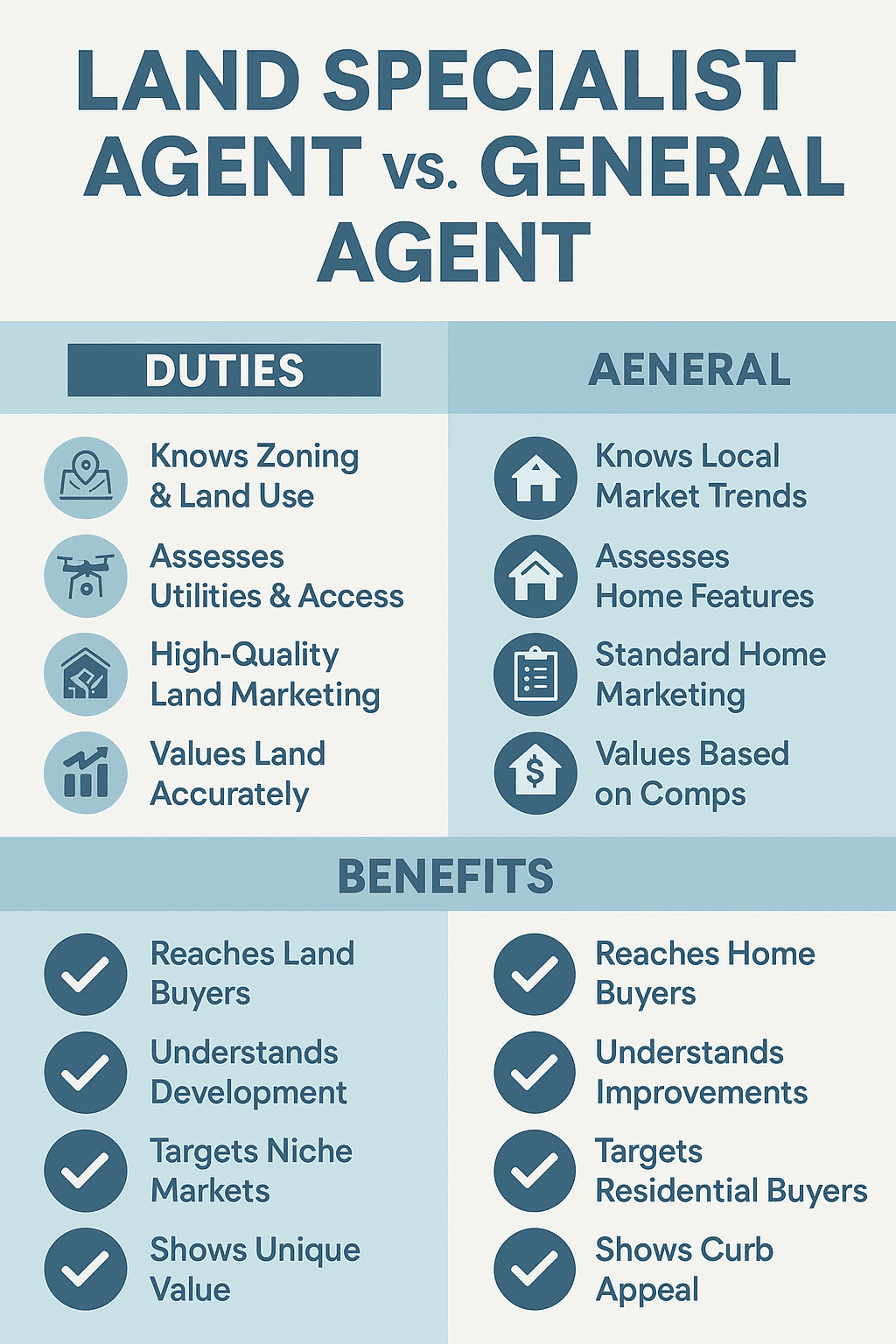
Owner Financing for Land: What Sellers Need to Know
If you’re researching how to sell land, you’ve probably heard about owner financing (also called seller financing). This is when the seller acts as the bank, allowing the buyer to make payments directly over time instead of paying the full purchase price upfront. For the right property and buyer, it can be a powerful tool to sell faster, increase your buyer pool, and even earn more money over time.
Below, we break down when to use it, what typical terms look like, and the key legal and practical considerations.
1. When to Offer Owner Financing for Land
Owner financing isn’t right for every land sale, but it can be a game-changer in certain situations:
- Slow-moving properties: If your land has been sitting on the market for months (or years), offering financing can attract buyers who can’t get traditional loans.
- Unique parcels: Rural, off-grid, or unconventional properties may not qualify for bank financing.
- Investor appeal: Buyers may pay a higher price if you offer flexible terms.
- Cash flow strategy: Instead of a lump sum, you can create a steady income stream.
If you’re figuring out how to sell land in a tough market, owner financing could make your listing stand out.
2. Typical Terms for Owner Financing
While there’s flexibility in structuring the deal, common land financing terms include:
- Down payment: 10%–30% of the purchase price (more for riskier buyers or remote parcels).
- Interest rate: Often 6%–12%, depending on market rates and buyer risk.
- Balloon payment: Many agreements require the buyer to pay off the balance in 3–5 years.
- Amortization period: Payments might be calculated over 15–30 years to keep them affordable, with a balloon at the end.
Clear terms will make your how to sell land strategy more appealing while protecting your interests.
3. Notes, Mortgages, Deeds of Trust, and Land Contracts
When you sell land with owner financing, the agreement is documented through one of several legal instruments:
- Promissory note: Details the repayment terms.
- Mortgage or deed of trust: Secures the note with the property as collateral.
- Land contract (contract for deed): The seller retains title until the buyer pays in full.
Which you use depends on your state laws and how you want the transaction structured.
4. Servicing Notes, Late Fees, and Default Remedies
If you’re learning how to sell land with owner financing, you’ll need a plan for managing the payments:
- Loan servicing company: Handles billing, record-keeping, and compliance.
- Late fees: Typically allowed after a grace period (e.g., 10 days past due).
- Default remedies: Spell out what happens if the buyer stops paying—foreclosure or contract cancellation, depending on your agreement.
A professional note servicer can ensure you stay compliant and keep the process smooth.
5. Dodd-Frank & S.A.F.E. Act Considerations
Federal and state lending laws can apply to owner financing, even for land. The Dodd-Frank Act and S.A.F.E. Mortgage Licensing Act may impose restrictions, especially if you finance multiple properties per year or if the buyer intends to build a residence. In some cases, you’ll need a licensed mortgage loan originator to handle the transaction.
Consult a real estate attorney to make sure your how to sell land plan follows the rules.
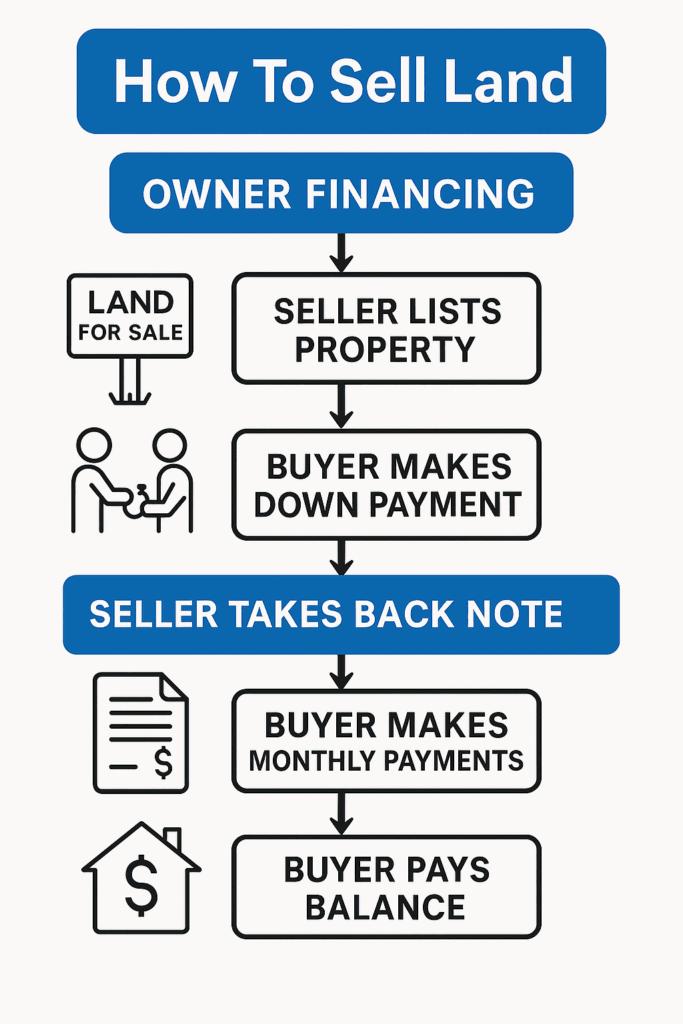
Due Diligence Buyers Will Do In Land Sales
If you’re learning how to sell land, it’s essential to understand that buyers—especially savvy or experienced ones—will conduct due diligence before committing to a purchase. This process allows them to uncover any issues, confirm the property’s suitability for their plans, and ensure they’re making a wise investment.
The more you understand what buyers will be looking for, the better you can prepare and even address potential concerns in advance.
1. Surveys – Confirming Boundaries and Acreage
A professional land survey confirms the property’s legal boundaries, total acreage, and whether there are any encroachments from neighbors.
- Why buyers care: Accurate boundaries determine build locations, fencing, and legal access.
- Seller tip: Providing an updated survey upfront can speed up the how to sell land process and reduce negotiation friction.
2. Perc (Percolation) Tests & Soil/Septic Permits
A perc test measures how quickly soil absorbs water, which is critical for septic system approval.
- Why buyers care: Without a passing perc test (or access to public sewer), some properties can’t be built on.
- Seller tip: Conducting a perc test before listing can make your property more attractive and prove buildability.
3. Environmental, Flood Zone, and Wetlands Assessments
Environmental reports (like Phase I ESA), FEMA flood zone maps, and wetlands delineations determine if there are restrictions or costly mitigation steps needed.
- Why buyers care: Flood insurance, development limitations, and environmental cleanup costs can be deal-breakers.
- Seller tip: Be ready with disclosures and documentation—it builds trust in your how to sell land strategy.
4. Timber Cruise Reports, Soil Class, and Slope Analysis
For rural or forested properties, buyers may request:
- Timber cruise: An estimate of timber volume and value.
- Soil classification: Determines agricultural potential or septic feasibility.
- Slope analysis: Impacts construction costs, erosion control, and usable acreage.
- Seller tip: If your land has marketable timber or prime soils, highlight it in your listing.
5. Access Verification – Legal and Physical
Buyers will confirm:
- Legal access: Deeded easement or direct frontage on a public road.
- Physical access: Usable road or driveway to reach the parcel.
- Seller tip: If there’s a discrepancy between legal and physical access, resolve it before listing to avoid derailing your how to sell land efforts.
6. Title Search & Encroachments
A title search uncovers:
- Existing liens or mortgages
- Unpaid taxes
- Easements or deed restrictions
- Boundary encroachments (neighbor’s fence or structure on your land)
- Seller tip: Clear title issues before going to market to avoid losing qualified buyers.
7. Estimating Build Cost & Utility Runs
Buyers may get quotes for:
Seller tip: Having letters or estimates from utility providers can make the how to sell land process smoother and attract serious buyers faster.
Driveway installation
Extending power lines or water mains
Drilling a well or installing septic
Internet and natural gas service
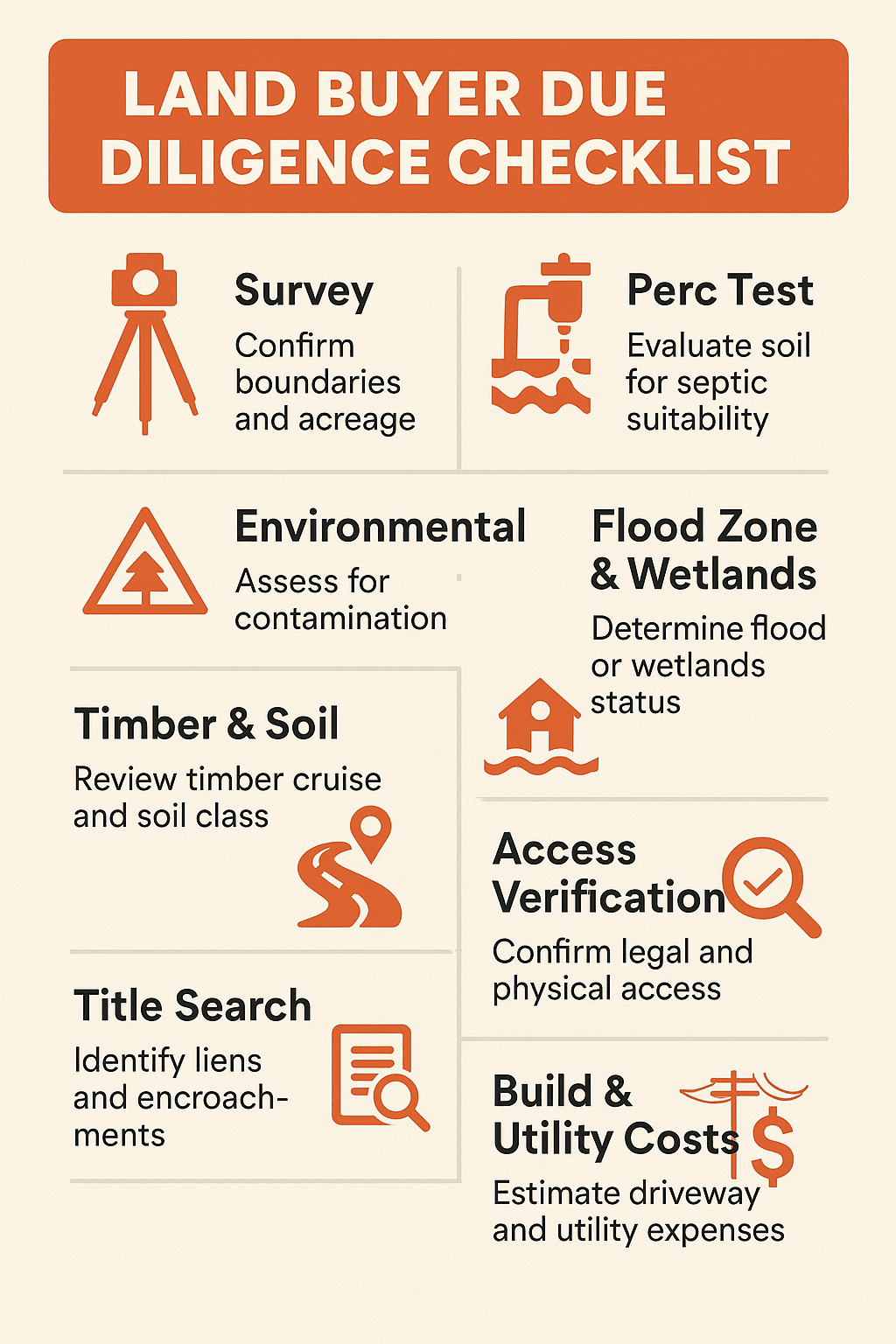
Environmental & Specialty Issues in Land Sales
When figuring out how to sell land, environmental and specialty issues can make or break a deal. Some parcels come with unique challenges—whether due to location, natural resources, or legal restrictions—that require special handling. Knowing how to identify, disclose, and navigate these factors is critical to attracting the right buyer and getting to closing without delays.
1. Wetlands Delineation, Army Corps, and Mitigation Banks
If your property contains wetlands, a wetlands delineation conducted by a qualified environmental consultant is often required. This identifies the exact boundaries of protected areas.
- Army Corps of Engineers oversight: Federal regulations may limit what can be built in or near wetlands.
- Mitigation banks: If development impacts wetlands, buyers might purchase “credits” from mitigation banks to offset the loss.
- How to Sell Land Tip: Provide any existing delineation reports upfront to avoid surprises during due diligence. If wetlands limit development, market the land for its ecological or recreational value.
2. Endangered Species & Habitat Constraints
Some parcels fall within habitats for endangered or threatened species such as gopher tortoises, red-cockaded woodpeckers, or certain plant species.
- Impact: Development might require surveys, relocation permits, or seasonal work restrictions.
- How to Sell Land Tip: Be transparent about species-related limitations and highlight alternative uses for the property that don’t conflict with regulations.
3. Brownfields, Contamination, & Phase I Environmental Site Assessments (ESA)
Properties that may have been used for industrial, agricultural, or commercial purposes could have soil or groundwater contamination.
- Phase I ESA: A standard first step for identifying potential environmental liabilities.
- Brownfields programs: Offer grants or incentives for remediation.
- How to Sell Land Tip: If contamination is possible, order a Phase I ESA before listing. This shows buyers you’ve taken proactive steps and can accelerate financing approval.
4. Floodplains, FEMA Letters, & Elevation Certificates
Floodplain maps determine if a property is at risk for flooding.
- FEMA Flood Zone Determination: Buyers will want to know if flood insurance is required.
- Elevation certificates: Document the property’s height relative to base flood elevation.
- How to Sell Land Tip: If your land is in a flood zone, provide FEMA documentation upfront. This transparency can make the buyer’s decision easier and prevent deal fallout.
5. Coastal, Riparian, and Lakefront Nuances
Waterfront properties often have additional regulations.
- Coastal zones: May be subject to setbacks, dune protection, or hurricane building codes.
- Riparian rights: Dictate water usage along rivers or streams.
- Lakefront restrictions: Often tied to dock permits, shoreline management plans, or HOA rules.
- How to Sell Land Tip: Market these properties by emphasizing permitted uses and the lifestyle benefits, but be ready with the governing documents.
6. Fire Risk – Wildland-Urban Interface (WUI)
In certain regions, fire danger is a significant factor in how to sell land.
- WUI zones: Areas where development meets wildland vegetation often require special fire-resistant building codes.
- Buyer considerations: Insurance availability and cost can be impacted.
- How to Sell Land Tip: Include information on local fire mitigation programs, defensible space requirements, and any existing fire protection measures.

Parcel Structures & Special Cases in Land Sales
When learning how to sell land, one of the most overlooked—but highly important—factors is the structure and unique characteristics of the parcel itself. Shape, size, access points, and existing improvements can significantly influence both value and marketing strategy. Understanding these nuances helps sellers position their property for the right audience and the best possible price.
1. Selling Part of a Parcel: Splits & Lot Line Adjustments
Sometimes you don’t need (or want) to sell your entire parcel.
- Parcel splits: Involve creating one or more new legal parcels from an existing lot. This often requires subdivision approval or a minor land division process through the county.
- Lot line adjustments: Shift the boundary lines between neighboring parcels without creating new lots.
- Key Considerations: Costs, surveys, and local zoning rules. These changes can take weeks to months, so start early.
- How to Sell Land Tip: Have a surveyor draw proposed new boundaries before listing, and clarify utility access for each portion.
2. Flag Lots, Panhandle Access, & Odd Shapes
- Flag lots (a narrow strip leading to a wider buildable area) and panhandle access lots can be harder to market because of privacy, driveway costs, and zoning setbacks.
- Odd-shaped parcels may limit building footprints or development layout.
- How to Sell Land Tip: For unusual shapes, provide a site plan showing possible building or development layouts. This helps buyers visualize potential despite unconventional geometry.
3. Corner Lots vs. Interior Lots: Value Differences
- Corner lots: Often more desirable for commercial uses due to visibility and multiple access points. In residential areas, they may have larger yard setbacks, which can be a pro or con depending on the buyer.
- Interior lots: Usually have lower traffic and more privacy but less visibility for businesses.
- How to Sell Land Tip: Highlight the specific advantages for your buyer type—visibility for commercial buyers, privacy for residential buyers.
4. Small Acreage vs. Large Tract Strategy
- Small acreage parcels appeal to homebuilders, first-time rural buyers, and recreational buyers. They often sell faster but at a higher price per acre.
- Large tracts may attract developers, farmers, or investors, but can take longer to sell and require more due diligence.
- How to Sell Land Tip: For large tracts, consider subdividing or offering seller financing to broaden your buyer pool.
5. Land with Mobile Homes or RV Pads
- Mobile homes or existing RV hookups can add value, especially for recreational or seasonal buyers.
- Check whether structures are titled as personal property or real property; this impacts financing and taxes.
- How to Sell Land Tip: If the mobile home is outdated, market the value of the hookups, septic, and utilities rather than the structure itself.
6. Agricultural Land with Active Leases
- Some farmland comes with an active lease to a farmer or rancher. These can be appealing for investors who want immediate income.
- Buyers may have to honor existing lease terms, so disclose the lease length, rent amount, and renewal terms upfront.
- How to Sell Land Tip: Market agricultural parcels by emphasizing lease income and any special tax advantages such as agricultural exemptions.

Closing Process in Land Sales: What Every Seller Should Know
When learning how to sell land, understanding the closing process is just as important as knowing how to market it. While many sellers focus on attracting buyers and negotiating price, the final stage—closing—is where deals are either sealed smoothly or fall apart.
Here’s a detailed look at what goes into closing on a vacant land sale, who pays what, and how you can prepare for a seamless transaction.
1. Who Pays What at Closing for Land
The allocation of costs can vary depending on the state, local custom, and the purchase agreement. Common expenses include:
Seller Typically Pays:
- Owner’s title insurance policy (in many states)
- Real estate commissions (if applicable)
- Prorated property taxes up to the day of closing
- Documentary stamp tax or transfer tax (state/county dependent)
- HOA/POA transfer fees (if applicable)
Buyer Typically Pays:
- Lender’s title insurance (if financing)
- Loan origination fees
- Survey fees (if required)
- Recording fees
- Closing/escrow fee (split or buyer-paid depending on agreement)
How to Sell Land Tip: Always confirm local customs with your title company or attorney and set clear expectations in the purchase agreement to avoid disputes later.
2. Choosing a Title Company or Closing Attorney
- In some states, title companies handle closings; in others, a closing attorney is required.
- Choose a professional experienced in vacant land transactions, as these can have unique title and access issues compared to residential homes.
- Ask about their process, turnaround time for title searches, and ability to handle remote closings if needed.
How to Sell Land Tip: Your choice of closing professional can make or break a deal—vet them before the contract is signed.
3. Earnest Money Norms for Land
Earnest money for vacant land tends to be lower in percentage compared to home purchases, but the actual amount varies by price range:
- Small parcels: $500–$1,000
- Mid-range parcels: 1–3% of purchase price
- High-value/development tracts: Negotiable, often higher to demonstrate serious intent
How to Sell Land Tip: A larger earnest money deposit signals a serious buyer and can help secure a deal—especially if you’re entertaining multiple offers.
4. As-Is Addenda & Inspection Periods
Vacant land is often sold as-is, meaning the seller makes no repairs or changes before closing. However, buyers may still request:
- Environmental studies
- Perc tests
- Surveys
- Utility access confirmation
Inspection periods for land can be longer than for homes, sometimes 30–90 days, especially for large tracts.
How to Sell Land Tip: Clearly define the inspection period and what is allowed (e.g., soil borings, site clearing) to avoid disputes.
5. Remote & Online Closings for Vacant Land
One of the perks of selling land is that remote closings are often possible.
- Sellers can sign documents via e-signature and send notarized paperwork via courier.
- Title companies can wire funds directly after closing.
- This is especially helpful for out-of-state transactions.
How to Sell Land Tip: If selling to an out-of-state buyer, choose a title company experienced in handling fully remote closings to avoid delays.
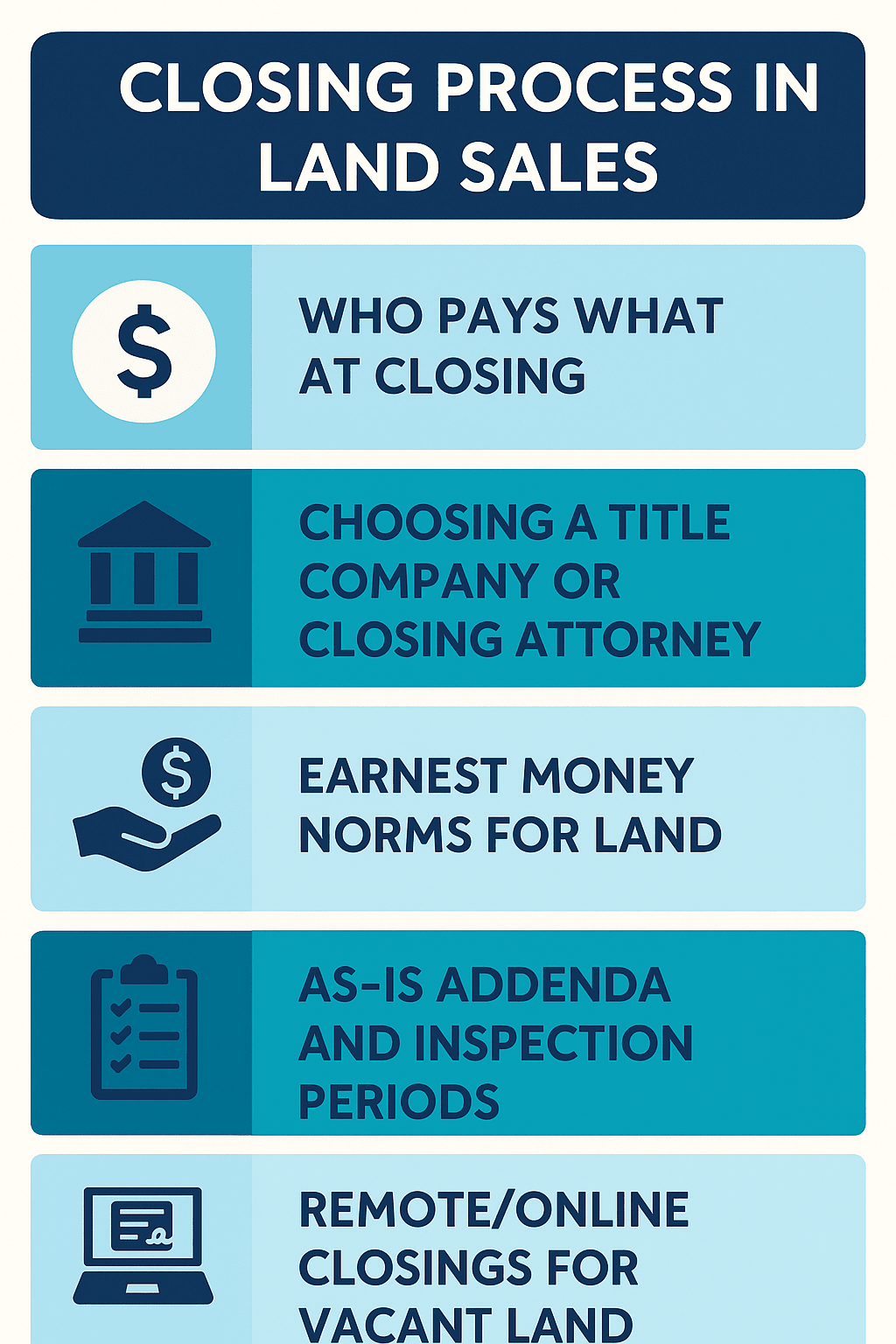
Land Sales Negotiation & Offers: How to Secure the Best Deal for Your Property
When learning how to sell land, the negotiation and offer stage is where deals are made or lost. Unlike home sales, land deals can have wider price swings, unique contingencies, and varying buyer motivations. Knowing how to evaluate offers and negotiate terms will help you protect your bottom line while keeping the deal moving toward closing.
1. Evaluating Cash vs. Financed Offers
When it comes to how to sell land, the type of offer you accept can dramatically affect the speed and certainty of closing.
- Cash Offers:
- Pros: Faster closings, fewer contingencies, no lender underwriting delays.
- Cons: Buyers may expect a discount in exchange for speed and certainty.
- Financed Offers:
- Pros: May yield a higher price since buyers can leverage loans.
- Cons: Risk of loan denial, longer timelines, and lender-driven appraisal requirements.
Tip: If a financed offer is significantly higher than a cash offer, weigh the potential delays against the added profit.
2. Contingencies Common in Land Contracts
Land transactions often include unique contingencies that can either protect the buyer or create delays. Common ones include:
- Survey & Boundary Confirmation: Ensures the property lines match what’s being sold.
- Perc Test or Soil Approval: Critical for septic system installation.
- Environmental Review: Especially for rural, industrial, or waterfront parcels.
- Zoning Verification: Confirms intended use is allowed.
When deciding how to sell land, set reasonable contingency timelines so the deal doesn’t stall indefinitely.
3. Multiple-Offer Strategy for Land
When you receive more than one offer, you have options:
- Highest & Best: Set a short deadline for all buyers to submit their best terms.
- Counter-Offer Selectively: Negotiate individually with the strongest offers.
- Leverage Offers Against Each Other: Without revealing confidential details, let buyers know there is competition to motivate better terms.
Multiple-offer scenarios in land sales are less common than in hot housing markets, but when they happen, they’re a strong opportunity to maximize price.
4. Appraisal Gaps and Proof of Funds for Land Deals
Unlike houses, vacant land can be harder to appraise—comps may be sparse and values subjective.
- Appraisal Gap Clauses: Let you protect the agreed price by requiring the buyer to cover any difference if the appraisal comes in low.
- Proof of Funds: Always request this for cash deals to ensure the buyer has liquid funds to close.
By incorporating these into your negotiation process, you reduce last-minute surprises and strengthen your position.
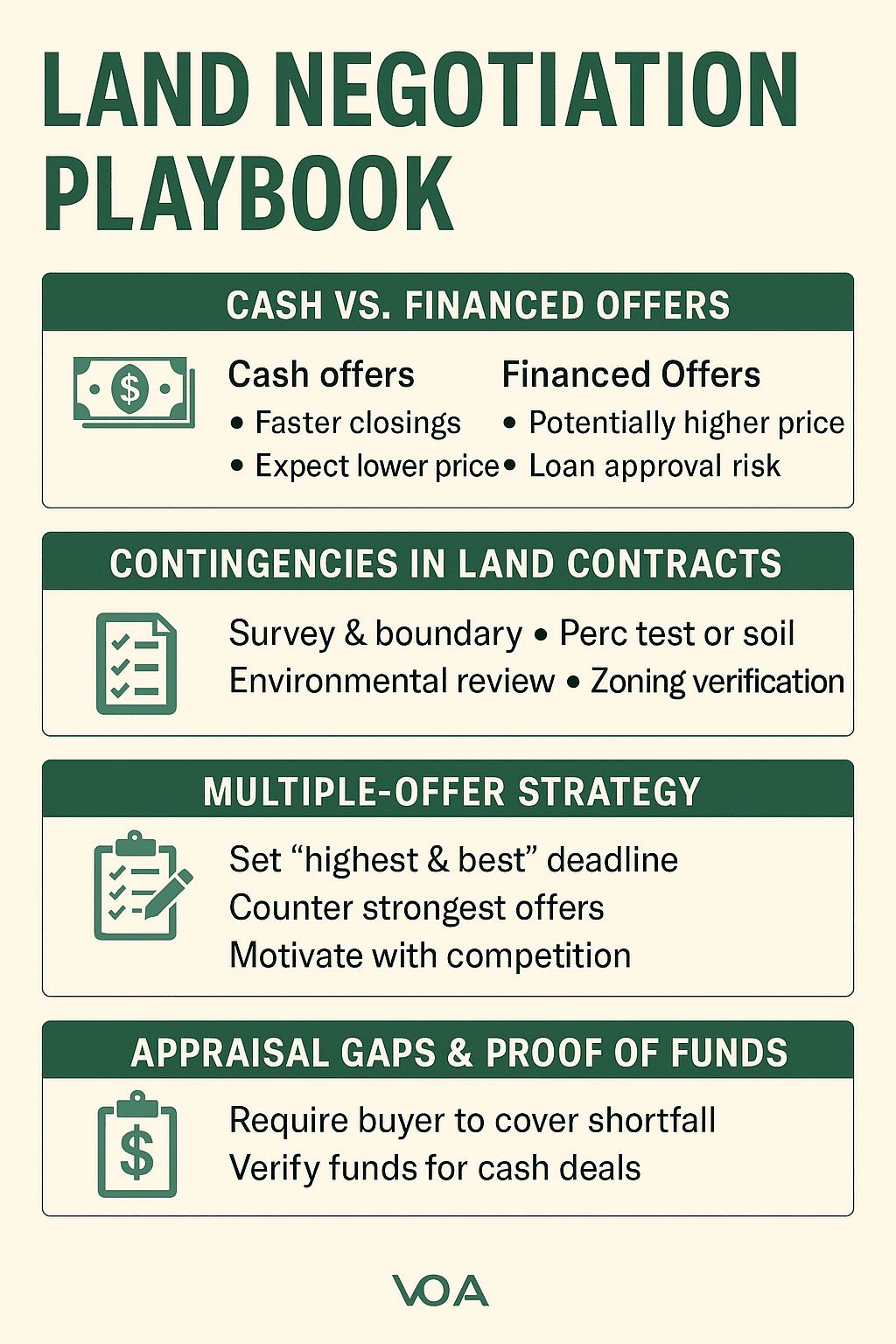
Land Selling Marketing Creatives & Assets: Making Your Property Stand Out
When it comes to How To Sell Land, the marketing assets you create can make the difference between generating serious interest and getting lost in a crowded market. Vacant land buyers don’t have a front porch, remodeled kitchen, or curb appeal to sway their decision—your marketing materials must bring the property to life in ways that help buyers see its potential.
Here’s how to elevate your land listing with strategic, professional creative assets.
1. Site Maps with Annotations
A plain map is fine—but an annotated site map transforms your listing into a guided tour. Highlight:
- Potential build sites
- Notable views or high points
- Water features such as ponds, creeks, or wetlands
- Access points and roads
When learning How To Sell Land, think like a buyer: a well-marked site map gives them instant clarity about layout and potential use. You can create these with Google Earth overlays, GIS tools, or with the help of a surveyor.
2. Overlay Utilities and Easements on Listing Images
Buyers want to know where power lines run, where water taps are, and whether an easement crosses the property. Overlaying these details directly onto aerial photos or drone shots gives them answers before they ask.
For example:
- Mark power pole locations
- Show well or septic test areas
- Identify driveway easements or rights-of-way
If your goal is How To Sell Land effectively, transparency about infrastructure is a trust-builder and speeds decision-making.
3. Seasonal Photography for a Complete Picture
Many land listings only show one season—which can undersell the property’s beauty. Capture multiple “faces” of the land:
- Leaf-off season to highlight terrain and boundaries
- Leaf-on season for lushness and shade
- Snow-covered views for mountain or northern properties
- Wildflower bloom for fields or meadows
Knowing How To Sell Land includes knowing how to help a buyer emotionally connect—and seasonal photos are an emotional trigger.
4. 3D Terrain & Slope Visualizations (LIDAR/GIS)
Topography is one of the biggest factors in a buyer’s decision. Using LIDAR data or GIS mapping tools, you can create:
- 3D slope maps for building feasibility
- Elevation profiles to plan views
- Watershed flow visuals for drainage or pond potential
When executed well, this demonstrates expertise in How To Sell Land and positions you as a seller who understands the technical side of land value.
5. Bundling Your Creatives into a Marketing Package
The best strategy is to combine all these assets into a cohesive marketing folder or webpage:
- High-resolution photos (ground + drone)
- Annotated site map
- Utility/easement overlays
- Seasonal and 3D terrain visuals
When buyers see a complete set of materials, they feel more confident making offers—sometimes without a site visit.

Niches & End Buyers for Land Sales: Understanding Who You’re Selling To
When learning How To Sell Land, one of the most important steps is understanding who your potential buyer might be. Unlike homes, where the pool of buyers tends to be broader, land sales are often driven by specific niches—each with its own motivations, timelines, and deal structures. Knowing these audiences can help you tailor your marketing, pricing, and negotiation strategies for maximum impact.
1. Builders & Developers
Builders and developers typically buy land with the intention to construct residential, commercial, or mixed-use projects.
Key Characteristics:
- Often value location, zoning flexibility, and infrastructure readiness over aesthetic appeal.
- Tend to perform extensive feasibility studies before making an offer.
- Usually seek land with existing entitlements or easy rezoning potential.
How To Sell Land to Builders/Developers:
- Highlight zoning, density allowances, and utility access in your listing.
- Provide site maps, topography, and any prior permits or surveys.
- Be prepared for longer due diligence periods.
2. Homesteaders & Lifestyle Buyers
Homesteaders are looking for a self-sufficient lifestyle—often with space for gardens, animals, or off-grid living.
Key Characteristics:
- Motivated by privacy, soil quality, and access to natural resources like water.
- May value aesthetics, mature trees, or scenic views over strict ROI.
- Tend to be emotionally driven buyers.
How To Sell Land to Homesteaders:
- Market water rights, fertile soil, and low restrictions on farming or building.
- Include seasonal photos showcasing the property’s beauty.
- Emphasize nearby resources like farmers’ markets or agricultural supply stores.
3. Land Investors
Investors focus on appreciation potential and resale or development opportunities.
Key Characteristics:
- Typically buy at below-market value for future profit.
- Less concerned with immediate usability—more focused on growth potential.
- Quick decision-makers if the deal meets their ROI requirements.
How To Sell Land to Investors:
- Show historical appreciation trends and area growth projections.
- Highlight unique attributes that could make the property a standout future resale.
- Be open to cash offers for faster closing.
Get Started: Get Your Cash Offer Below…
We are direct land buyers. There are no commissions or fees and no obligation whatsoever. Start below by sharing where your property is and where we can send your offer…
4. Recreational Buyers (Hunting, Fishing, Off-Grid)
This niche buys for leisure and personal enjoyment.
Key Characteristics:
- Seek properties near lakes, rivers, forests, or hunting grounds.
- Prioritize privacy, access rights, and recreational usability.
- May require information on hunting leases, fishing permits, or ATV access.
How To Sell Land to Recreational Buyers:
- Advertise trails, wildlife sightings, and proximity to recreational areas.
- Include drone footage to show terrain and natural features.
- Provide maps showing public land access or nearby parks.
5. Timber Buyers & Forestry Interests
Some buyers are in it for the wood—literally.
Key Characteristics:
- Evaluate the property’s timber quality, age, and market value.
- May want a timber cruise report before making an offer.
- Focus on access roads for harvesting and hauling.
How To Sell Land to Timber Buyers:
- Provide a recent timber evaluation or connect them with local foresters.
- Showcase access points and any logging roads.
- Mention potential income from selective harvesting.
6. RV, Tiny Home, & ADU Enthusiasts
This fast-growing niche is fueled by affordability and flexible living.
Key Characteristics:
- Often interested in minimal zoning restrictions.
- Want access to utilities or alternative power/water solutions.
- May prioritize proximity to desirable vacation or retirement areas.
How To Sell Land to RV/Tiny Home Buyers:
- Clarify local zoning rules for RV parking, tiny homes, or accessory dwellings.
- Highlight existing septic, well, or solar capabilities.
- Show creative examples of similar properties being used successfully.
Risk & Compliance in Selling Your Land
When learning How To Sell Land, many owners focus on marketing and pricing, but one critical area that often gets overlooked is risk management and legal compliance. Vacant land may seem harmless compared to a house, but it carries unique liability and safety considerations that can impact your sale. From insurance coverage to access control, here’s what you need to know to protect yourself while attracting serious buyers.
1. Vacant Land Insurance & Liability
Even if no structures exist on your property, you can still be held liable for accidents that occur there. This is especially important if you’re actively showing the land to potential buyers or allowing surveyors, inspectors, or contractors to visit.
- Vacant Land Liability Insurance – This coverage protects you if someone is injured on your property.
- Coverage Considerations – Ask your insurance agent about limits, exclusions (such as ATV accidents), and short-term policies if you’re selling quickly.
- Why It Matters for How To Sell Land – Buyers feel more confident viewing your property when they know the site is properly managed and safe.
2. Posting “Enter at Own Risk” & Waiver Language
Signs and legal disclaimers won’t prevent all liability, but they can help establish that visitors are entering at their own discretion.
- “Enter at Own Risk” Signs – Place these near all entrances and trailheads.
- Written Waivers – If you’re scheduling guided showings or site visits, have visitors sign a liability waiver.
- How This Helps – It shows professionalism, manages expectations, and demonstrates that you understand both the property and compliance steps in How To Sell Land safely.
3. Trespass, Hunting Leases & Marketing Overlap
If your property is in a rural or wooded area, it may be used informally by hunters, hikers, or neighbors. This can become a problem during the selling process.
- Terminate or Clarify Leases – If you have an active hunting lease, decide whether to pause or continue it during marketing.
- Prevent Uninvited Use – Posting signs and installing gates helps maintain control.
- Why It Matters – In How To Sell Land, unmonitored trespass can cause liability, create buyer safety concerns, and complicate showings.
4. Gate Codes & Access Control During Showings
If your property has a gate, you need a secure method for providing buyer access without risking security.
- Change Codes Regularly – Especially if agents, inspectors, or contractors have access.
- Accompanied Showings – For larger or complex properties, consider guided tours instead of free access.
- Lockboxes or Temporary Codes – Allows flexible buyer visits while keeping your land protected.
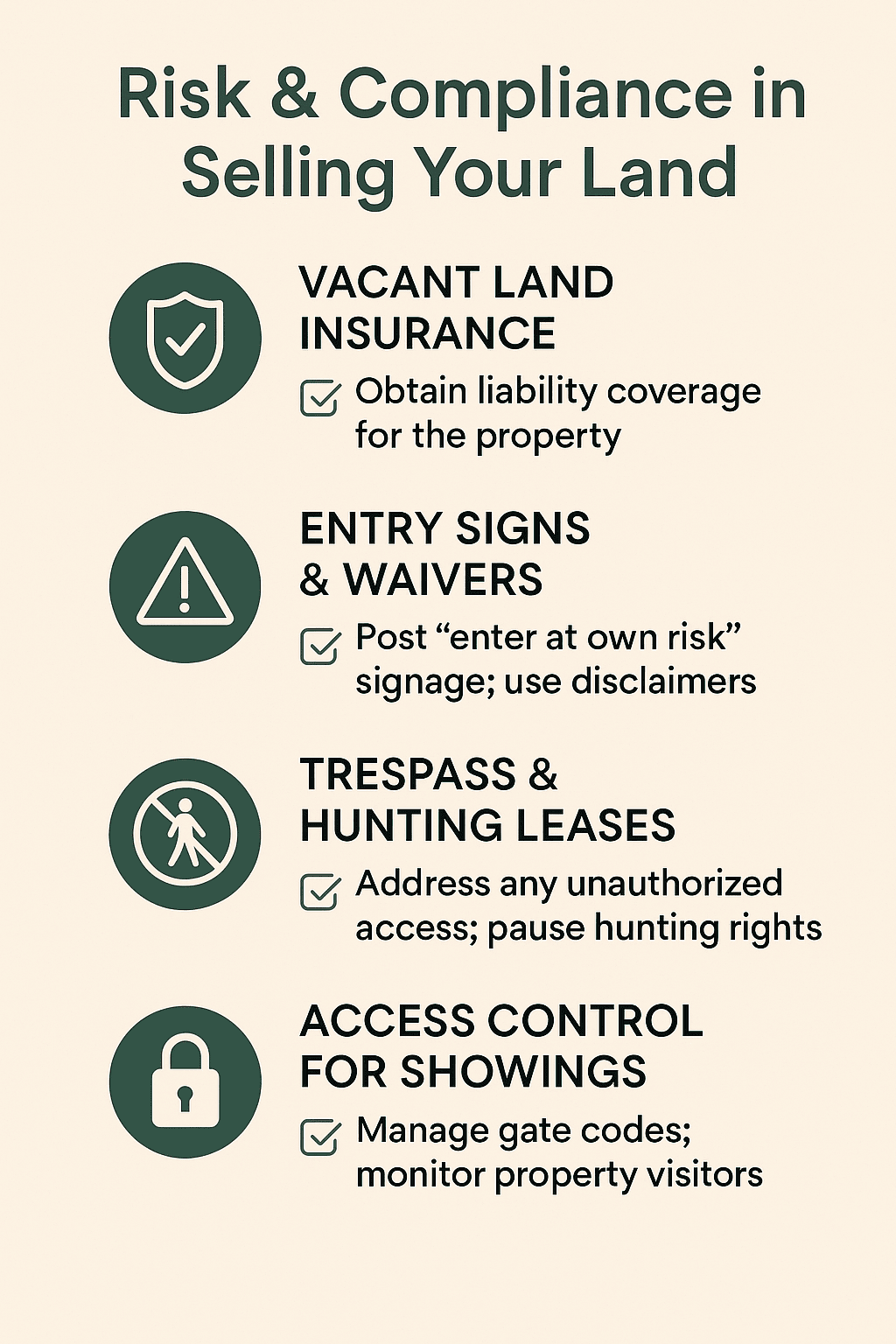
Common Problems & Fixes When Selling Your Land
When researching how to sell land, many owners quickly realize that vacant land transactions come with unique challenges compared to selling a house. From legal access to boundary disputes, these issues can stall or even derail a sale if not addressed early. Below, we break down common problems and their proven solutions—so you can move forward with confidence.
1. Landlocked Parcels (No Legal Access)
The Problem:
You own a property with no deeded road access. Even if you can physically walk or drive to it, buyers (and lenders) usually require a legal easement.
The Fix:
- Negotiate an easement with a neighboring property owner—record it with the county.
- Consider a “right-of-way” purchase to establish permanent legal access.
- If neighbors are resistant, explore prescriptive easement or court-ordered access in states where allowed.
Why It Matters:
When learning how to sell land, resolving access issues early is key—landlocked parcels can be heavily discounted or unsellable without a fix.
2. Failed Perc Tests
The Problem:
The land fails a percolation (perc) test, meaning soil conditions won’t support a traditional septic system.
The Fix:
- Hire an engineer to explore alternative septic solutions (mound systems, aerobic treatment units).
- Apply for a variance or re-test in a different location on the property.
- Market the land for non-residential uses that don’t require septic.
Pro Tip:
If you know how to sell land that has failed a perc test, you can target off-grid buyers or recreational users who aren’t concerned with residential waste systems.
3. Encroachments & Fence Line Disputes
The Problem:
A neighbor’s fence, shed, or driveway crosses onto your property—or your improvements extend onto theirs.
The Fix:
- Order a current survey to confirm boundaries.
- Negotiate a boundary line agreement or easement with the neighbor.
- If necessary, remove or relocate the encroaching structure.
Why It Matters:
Buyers expect a clean title and undisputed boundaries. Knowing how to sell land with encroachments means clearing them up before listing.
4. Missing Monuments or Corners
The Problem:
Survey markers (monuments, pins) are missing, making it unclear where the property lines are.
The Fix:
- Hire a licensed surveyor to re-establish and record the corners.
- Use GPS mapping and county parcel data for preliminary identification, but rely on a survey for legal certainty.
Pro Tip:
Flagging and staking corners makes it easier for buyers to visualize the property—something every how to sell land guide will recommend.
5. Old Liens & Unreleased Mortgages
The Problem:
A past mortgage or lien still shows on the title, even if it was paid off years ago.
The Fix:
- Have the title company request a release or satisfaction document from the lender.
- If the lender no longer exists, work with a title attorney to file corrective paperwork.
- Clear any unpaid taxes or judgments that could cloud the title.
Why It Matters:
When understanding how to sell land, title clearance is non-negotiable—lenders, buyers, and title companies won’t close until these issues are resolved.
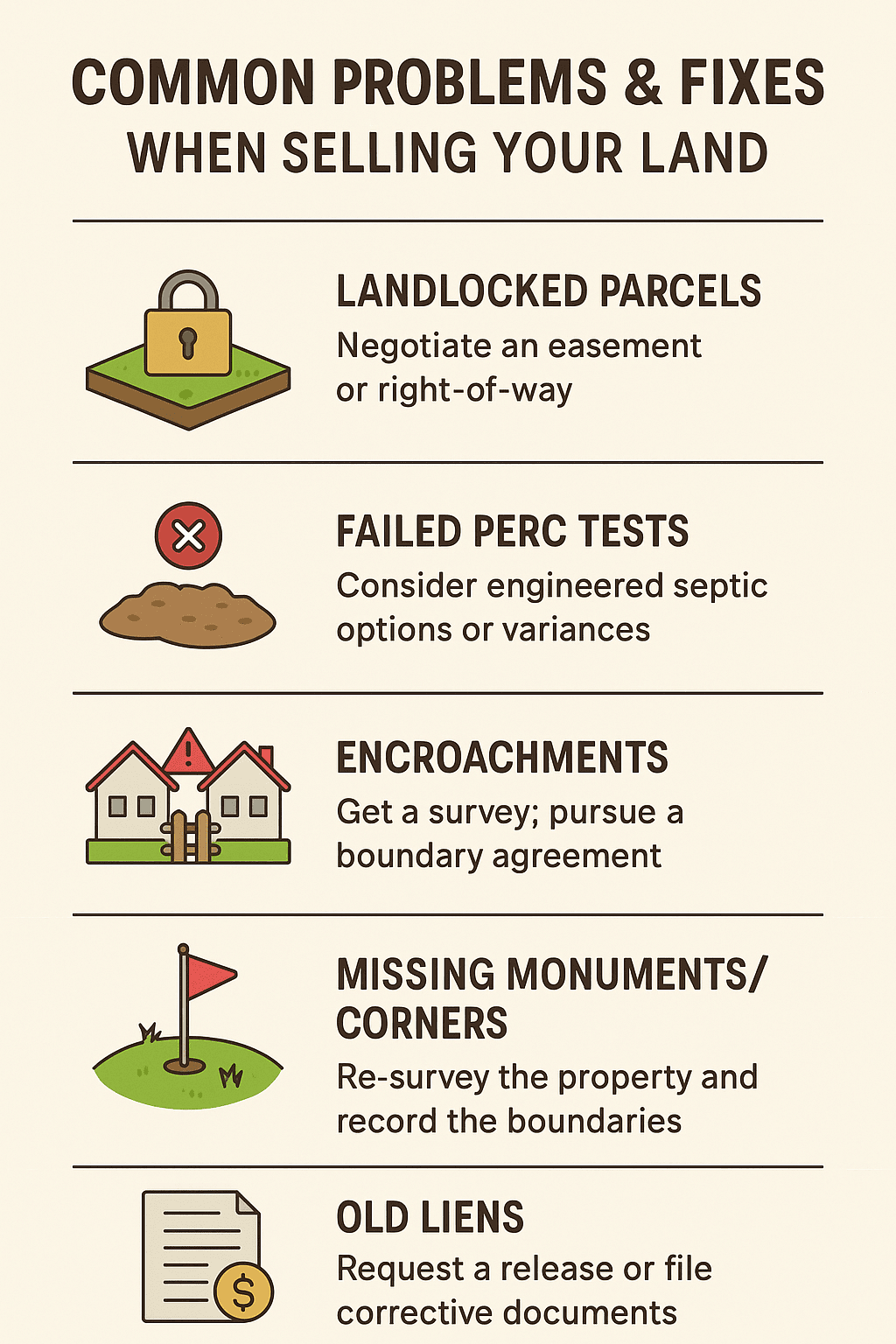
Tools & Resources for Selling Land: Your Complete Guide
If you’ve ever Googled how to sell land, you know the process involves more than just planting a “For Sale” sign and hoping for the best. Today’s land sellers have access to powerful tools and resources that can streamline research, improve pricing accuracy, and even automate documentation. The key is knowing which ones to use — and when.
Below is a breakdown of some of the best paid tools, ready-to-use templates, and handy pricing resources that can help you get from listing to closing faster and more confidently.
1. Best Paid Tools for Land Research
When learning how to sell land, the first step is often research. You’ll need accurate details about your parcel’s zoning, topography, access, and comparable sales. Here are some of the best paid platforms to consider:
- LandVision by LightBox – Excellent for property boundary overlays, zoning lookups, flood maps, and nearby sales data. Great for developers and experienced sellers.
- MapRight – User-friendly mapping software that lets you layer GIS data (soil types, wetlands, FEMA flood zones) over your parcel. You can share interactive maps with buyers.
- LandGrid – National parcel database that allows you to research ownership details, zoning codes, and land-use classifications.
- Parlay – Ideal for residential lot analysis; integrates zoning, density calculations, and feasibility tools in one place.
💡 Pro Tip: Combine these tools with your county’s GIS property search (often free) for the most accurate, current parcel data.
2. Templates You Should Have Ready
Whether you’re selling to an investor, a builder, or a private buyer, having the right forms and templates on hand saves time and reduces mistakes. Sellers mastering how to sell land often keep these in a folder ready to go:
- Letter of Intent (LOI) – A non-binding agreement outlining purchase terms before entering a formal contract.
Free LOI Template - Offer Sheet – Breaks down purchase price, contingencies, and timelines in a clear, easy-to-read format for buyers.
- Seller Disclosures – Varies by state, but may include environmental disclosures, easements, and known property defects.
State-Specific Disclosure Forms
💡 Pro Tip: Even if selling “as-is,” keep your disclosures transparent. It can prevent disputes and protect you legally.
3. Pricing Calculators & Price-Per-Acre Tools
Setting your asking price is one of the most challenging parts of learning how to sell land — especially if there aren’t many comparable sales nearby. These tools can help:
- AcreValue – Provides land values by county, soil maps, crop productivity indexes, and recent sales.
- LandWatch Price Per Acre – Filter by state, county, and land type to see current asking prices and trends.
- FarmRanchSell – Useful for rural and agricultural property pricing data.
- Custom Excel Pricing Calculator – Create your own spreadsheet to calculate price-per-acre, factoring in location, utilities, access, and market trends.
💡 Pro Tip: Always adjust your price-per-acre benchmarks by property type — residential lots, agricultural tracts, timberland, and recreational parcels each command different premiums.
We are a real estate solutions and investment company that helps land owners turn burdensome raw/vacant/bare land into cash. We Buy Land throughout the United States of America.
Any information on this website should not be taken as legal or financial advice. Readers should contact an attorney, CPA or the appropriate licensed professional for advice on any particular legal, tax or financial matter. Owners of this website and affiliated companies are licensed real estate brokers / agents in Florida.
